How long does it take to get to Mars?
We explore how long it takes to get to Mars and the factors that affect a journey to the Red Planet.

- Distance to Mars
- Traveling at the speed of light

Fastest spacecraft so far
Mars travel time q&a with an expert.
- Travel time calculation problems
- Past mission's travel times
Additional resources
Ever wondered how long does it take to get to Mars?
The answer depends on several factors, ranging from the position of Earth and Mars to the technology that would propel you there. According to NASA , a one-way trip to the Red Planet would take about nine months . If you wanted to make it a round-trip , all in all, it would take about 21 months as you will need to wait about three months on Mars to make sure Earth and Mars are in a suitable location to make the trip back home.
We take a look at how long a trip to the Red Planet would take using available technology and explore some of the factors that would affect your travel time.
Related: Curiosity rover: 15 awe-inspiring photos of Mars (gallery)
How far away is Mars?
To determine how long it will take to reach Mars, we must first know the distance between the two planets.
Mars is the fourth planet from the sun, and the second closest to Earth (Venus is the closest). But the distance between Earth and Mars is constantly changing as they travel around the sun .
In theory, the closest that Earth and Mars would approach each other would be when Mars is at its closest point to the sun (perihelion) and Earth is at its farthest (aphelion). This would put the planets only 33.9 million miles (54.6 million kilometers) apart. However, this has never happened in recorded history. The closest recorded approach of the two planets occurred in 2003 when they were only 34.8 million miles (56 million km) apart.
The two planets are farthest apart when they are both at their farthest from the sun, on opposite sides of the star. At this point, they can be 250 million miles (401 million km) apart.
The average distance between Earth and Mars is 140 million miles (225 million km).
Related: What is the temperature on Mars?
How long would it take to travel to Mars at the speed of light?

Light travels at approximately 186,282 miles per second (299,792 km per second). Therefore, a light shining from the surface of Mars would take the following amount of time to reach Earth (or vice versa):
- Closest possible approach: 182 seconds, or 3.03 minutes
- Closest recorded approach: 187 seconds, or 3.11 minutes
- Farthest approach: 1,342 seconds, or 22.4 minutes
- On average: 751 seconds, or just over 12.5 minutes
The fastest spacecraft is NASA's Parker Solar Probe , as it keeps breaking its own speed records as it moves closer to the sun. On Nov 21, 2021, the Parker Solar Probe reached a top speed of 101 miles (163 kilometers) per second during its 10th close flyby of our star, which translates to a phenomenal 364,621 mph (586,000 kph). According to a NASA statement , when the Parker Solar Probe comes within 4 million miles (6.2 million kilometers) of the solar surface in December 2024, the spacecraft's speed will top 430,000 miles per hour (692,000 kph)!
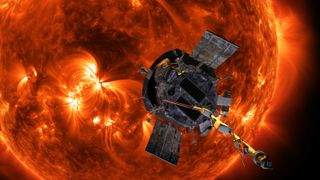
So if you were theoretically able to hitch a ride on the Parker Solar Probe and take it on a detour from its sun-focused mission to travel in a straight line from Earth to Mars, traveling at the speeds the probe reaches during its 10th flyby (101 miles per second), the time it would take you to get to Mars would be:
- Closest possible approach: 93 hours
- Closest recorded approach: 95 hours
- Farthest approach: 686 hours (28.5 days)
- On average: 384 hours (16 days)
We asked Michael Khan, ESA Senior Mission Analyst some frequently asked questions about travel times to Mars.
Michael Khan is a Senior Mission Analyst for the European Space Agency (ESA). His work involves studying the orbital mechanics for journeys to planetary bodies including Mars.
How long does it take to get to Mars & what affects the travel time?
The time it takes to get from one celestial body to another depends largely on the energy that one is willing to expend. Here "energy" refers to the effort put in by the launch vehicle and the sum of the maneuvers of the rocket motors aboard the spacecraft, and the amount of propellant that is used. In space travel, everything boils down to energy. Spaceflight is the clever management of energy.
Some common solutions for transfers to the moon are 1) the Hohmann-like transfer and 2) the Free Return Transfer. The Hohmann Transfer is often referred to as the one that requires the lowest energy, but that is true only if you want the transfer to last only a few days and, in addition, if some constraints on the launch apply. Things get very complicated from there on, so I won't go into details.
Concerning transfers to Mars, these are by necessity interplanetary transfers, i.e., orbits that have the sun as central body. Otherwise, much of what was said above applies: the issue remains the expense of energy. An additional complication lies in the fact that the Mars orbit is quite eccentric and also its orbit plane is inclined with respect to that of the Earth. And of course, Mars requires longer to orbit the sun than the Earth does. All of this is taken into account in a common type of diagram called the "pork chop plot", which essentially tells you the required dates of departure and arrival and the amount of energy required.
The "pork chop plot" shows the trajectory expert that opportunities for Mars transfers arise around every 25-26 months, and that these transfers are subdivided into different classes, one that is a bit faster, with typically around 5-8 months and the other that takes about 7-11 months. There are also transfers that take a lot longer, but I’m not talking about those here. Mostly, but not always, the second, slower one turns out to be more efficient energy-wise. A rule of thumb is that the transfer to Mars takes around as long as the human period of gestation, approximately 9 months. But that really is no more than an approximate value; you still have to do all the math to find out what applies to a specific date.
Why are journey times a lot slower for spacecraft intending to orbit or land on the target body e.g. Mars compared to those that are just going to fly by?
If you want your spacecraft to enter Mars orbit or to land on the surface, you add a lot of constraints to the design problem. For an orbiter, you have to consider the significant amount of propellant required for orbit insertion, while for a lander, you have to design and build a heat shield that can withstand the loads of atmospheric entry. Usually, this will mean that the arrival velocity of Mars cannot exceed a certain boundary. Adding this constraint to the trajectory optimisation problem will limit the range of solutions you obtain to transfers that are Hohmann-like. This usually leads to an increase in transfer duration.
The problems with calculating travel times to Mars
The problem with the previous calculations is that they measure the distance between the two planets as a straight line. Traveling through the farthest passing of Earth and Mars would involve a trip directly through the sun, while spacecraft must of necessity move in orbit around the solar system's star.
Although this isn't a problem for the closest approach, when the planets are on the same side of the sun, another problem exists. The numbers also assume that the two planets remain at a constant distance; that is, when a probe is launched from Earth while the two planets are at the closest approach, Mars would remain the same distance away over the length of time it took the probe to travel.
Related: A brief history of Mars missions
In reality, however, the planets are moving at different rates during their orbits around the sun. Engineers must calculate the ideal orbits for sending a spacecraft from Earth to Mars. Like throwing a dart at a moving target from a moving vehicle, they must calculate where the planet will be when the spacecraft arrives, not where it is when it leaves Earth.
It's also not possible to travel as fast as you can possibly go if your aim is to eventually orbit your target planet. Spacecraft need to arrive slow enough to be able to perform orbit insertion maneuvers and not just zip straight past their intended destination.
The travel time to Mars also depends on the technological developments of propulsion systems.
According to NASA Goddard Space Flight Center's website, the ideal lineup for a launch to Mars would get you to the planet in roughly nine months. The website quotes physics professor Craig C. Patten , of the University of California, San Diego:
"It takes the Earth one year to orbit the sun and it takes Mars about 1.9 years (say 2 years for easy calculation) to orbit the sun. The elliptical orbit which carries you from Earth to Mars is longer than Earth's orbit but shorter than Mars' orbit. Accordingly, we can estimate the time it would take to complete this orbit by averaging the lengths of Earth's orbit and Mars' orbit. Therefore, it would take about one and a half years to complete the elliptical orbit.
"In the nine months it takes to get to Mars, Mars moves a considerable distance around in its orbit, about three-eighths of the way around the sun. You have to plan to make sure that by the time you reach the distance of Mar's orbit, Mars is where you need it to be! Practically, this means that you can only begin your trip when Earth and Mars are properly lined up. This only happens every 26 months. That is, there is only one launch window every 26 months."
The trip could be shortened by burning more fuel — a process not ideal with today's technology, Patten said.
Evolving technology can help to shorten the flight. NASA's Space Launch System (SLS) will be the new workhorse for carrying upcoming missions, and potentially humans, to the red planet. SLS is currently being constructed and tested, with NASA now targeting a launch in March or April 2022 for its Artemis 1 flight, the first flight of its SLS rocket.
Robotic spacecraft could one day make the trip in only three days. Photon propulsion would rely on a powerful laser to accelerate spacecraft to velocities approaching the speed of light. Philip Lubin, a physics professor at the University of California, Santa Barbara, and his team are working on Directed Energy Propulsion for Interstellar Exploration (DEEP-IN). The method could propel a 220-lb. (100 kilograms) robotic spacecraft to Mars in only three days, he said.
"There are recent advances which take this from science fiction to science reality," Lubin said at the 2015 NASA Innovative Advanced Concepts (NIAC) fall symposium . "There's no known reason why we cannot do this."
How long did past missions take to reach Mars?
Here is an infographic detailing how long it took several historical missions to reach the Red Planet (either orbiting or landing on the surface). Their launch dates are included for perspective.
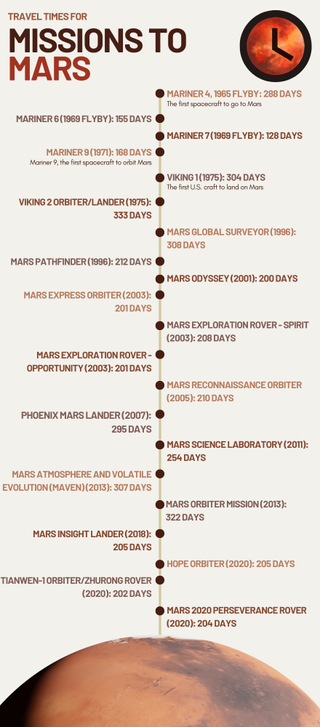
Explore NASA's lunar exploration plans with their Moon to Mars overview . You can read about how to get people from Earth to Mars and safely back again with this informative article on The Conversation . Curious about the human health risks of a mission to the Red Planet? You may find this research paper of particular interest.
Bibliography
- Lubin, Philip. " A roadmap to interstellar flight. " arXiv preprint arXiv:1604.01356 (2016).
- Donahue, Ben B. " Future Missions for the NASA Space Launch System. " AIAA Propulsion and Energy 2021 Forum . 2021.
- Srinivas, Susheela. " Hop, Skip and Jump—The Moon to Mars Mission. " (2019).
Join our Space Forums to keep talking space on the latest missions, night sky and more! And if you have a news tip, correction or comment, let us know at: [email protected].
Get the Space.com Newsletter
Breaking space news, the latest updates on rocket launches, skywatching events and more!

Nola Taylor Tillman is a contributing writer for Space.com. She loves all things space and astronomy-related, and enjoys the opportunity to learn more. She has a Bachelor’s degree in English and Astrophysics from Agnes Scott college and served as an intern at Sky & Telescope magazine. In her free time, she homeschools her four children. Follow her on Twitter at @NolaTRedd
Boeing's Starliner spacecraft is 'go' for May 6 astronaut launch
Building rockets and looking for life on Venus: Q&A with Rocket Lab's Peter Beck
Satellite images overlay 2024 and 2017 total solar eclipses sweeping across US
Most Popular
- 2 Boeing's Starliner spacecraft is 'go' for May 6 astronaut launch
- 3 Russian cosmonauts make quick work of space station spacewalk
- 4 Curiosity rover may be 'burping' methane out of Mars' subsurface
- 5 Boeing Starliner 1st astronaut flight: Live updates
Advertisement
How Long Does It Take to Get to Mars?
- Share Content on Facebook
- Share Content on LinkedIn
- Share Content on Flipboard
- Share Content on Reddit
- Share Content via Email
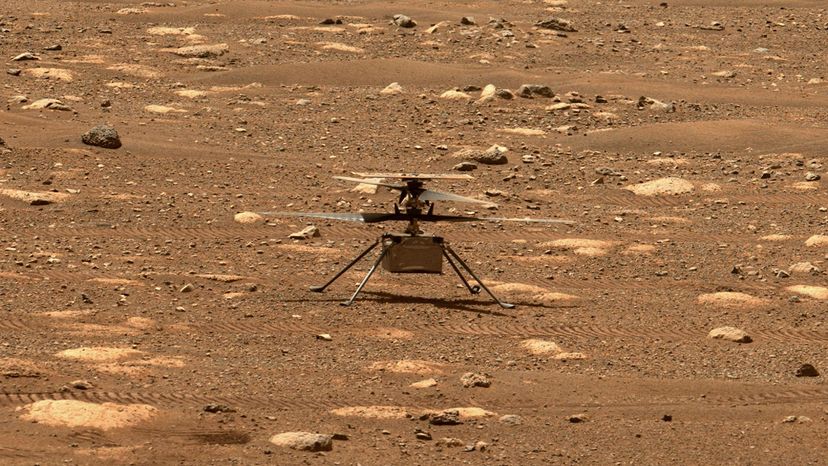
All eyes are on the red planet lately. Thanks to a number of missions in the past few years – including the Perseverance Rover that touched down Feb. 22, 2021 – Mars is increasingly interesting to astronomers, astrophysicists and future astronauts. NASA plans to put astronauts on Mars in the future, and Elon Musk keeps claiming he'll do it first , but before we strap in and blast off, it helps to know exactly how long it takes to get to there.
Mars completes one turn around the sun every 687 Earth days . This means that the distance between Earth and Mars changes every day, and the two planets are aligned closely to one another roughly every 26 months . Additionally, because both Earth and Mars have elliptical orbits (and Mars' is more elliptical than Earth's), some of our close approaches are closer than others. The most recent notable close approach was Oct. 6, 2020, when Mars was just 38.57 million miles (62.07 million kilometers) from Earth.
So how long does it take to travel the almost 40 million miles to Mars? That depends on your speed. For example, the Perseverance rover traveled at a speed of about 24,600 mph (about 39,600 kph) and the journey took seven months , but that's because of where the Earth and Mars were at the time Perseverance was launched and where they were when it landed. If you could travel as fast as the New Horizons spacecraft (which is famous for visiting Pluto back in 2015), you could potentially reach Mars in as little as 39 days depending on the alignment of the planets and the 36,000 mph (58,000 kph) speed that New Horizons reached. Historically, spacecraft have taken anywhere between 128 days (Mariner 7 on a flyby) and 333 days (Viking 2 Orbiter/Lander, the second U.S. landing on Mars) .
Since no human has traveled to Mars yet, we don't have exact numbers on how fast it's possible to go – because remember, you need to slow down as you get closer to Mars. The best estimates are that human missions to Mars will be timed to take advantage of a good planetary alignment. Most estimates put the travel time in the range of 150-300 days – that's five to 10 months – and the average is usually around seven months , just like the Perseverance rover.
The two fastest travel times from Earth to Mars are for the Viking 6 and Viking 7 spacecraft, which took 155 and 128 days respectively . Both of these spacecraft were on flyby missions to image Mars, so they didn't need to slow down as they approached Mars as orbiters, landers and rovers need to do.
Frequently Answered Questions
Why can we only go to mars every 2 years.
Please copy/paste the following text to properly cite this HowStuffWorks.com article:

The Nine Planets
How long does it take to get to Mars?
Mars is the most populated planet when it comes to robots. The famous Red Planet is located on average at around 1.5 AU or 228 million km / 142 million mi away from the Sun . At its farthest point, Mars is located at 1.6 AU away from the Sun, while its closest point, perihelion, is at 1.38 AU away. 1 AU – astronomical unit – is the equivalent of 150 million km / 93 million mi, and the Sun is 1 AU away from Earth.
(If you want to calculate how long it takes to get to stars, planets, and galaxies, try our space travel calculator)
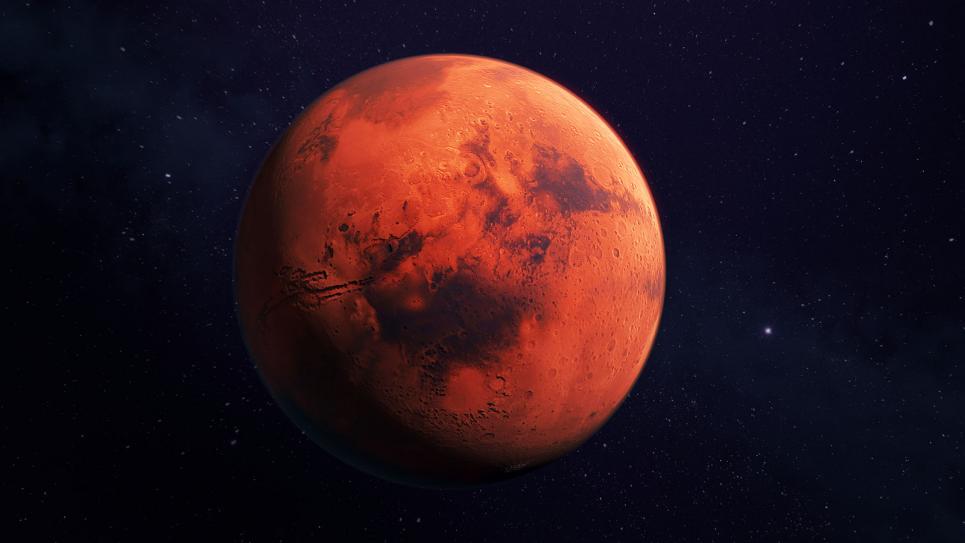
Traveling At the Speed of Light Towards Mars
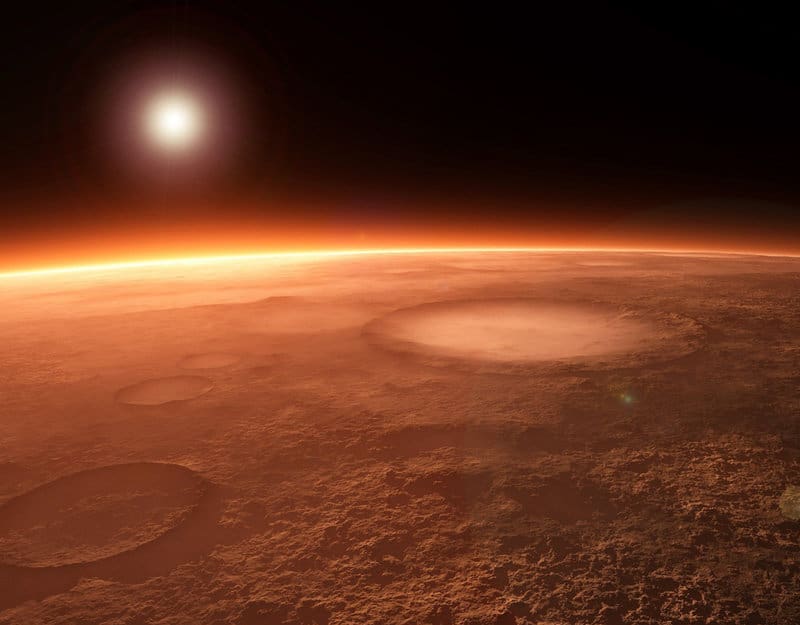
Traveling On One Of the Fastest Spacecraft Towards Mars
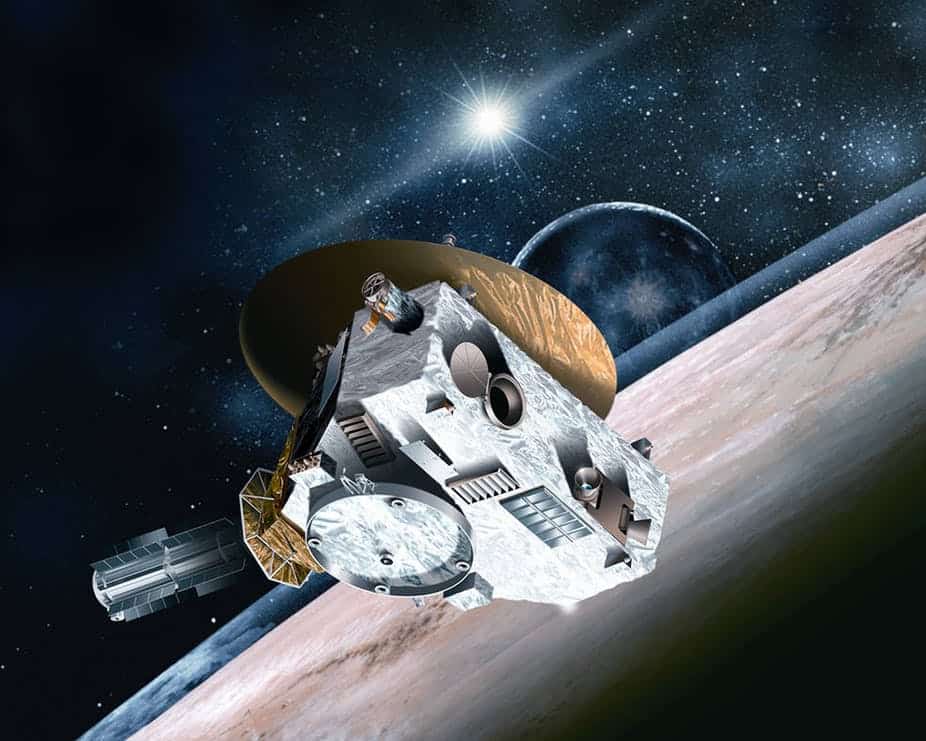
How Long Did It Take Other Spacecraft To Reach Mars?
The journey towards the Red Planet takes quite a bit of time, no matter how you look at it. But how long did it take for other probes or spacecraft to reach Mars? Here is a little list:
- Mars Science Laboratory – Launched in 2011 – 254 days
- Mars Reconnaissance Orbiter – 2005 – 210 days
- Mars Express Orbiter – 2003 – 201 days
- Mars Pathfinder – 1996 – 212 days
- Mars Global Surveyor – 1996 – 308 days
- Viking 2 – 1975 – 333 days
- Viking 1 – 1975 – 304 days
- Mariner 9 – 1971 – 168 days
- Mariner 7 – 1969 – 128 days
- Mariner 6 – 1969 – 155 days
- Mariner 4 – 1965 – 228 days
How Long Will It Take SpaceX To Get To Mars?
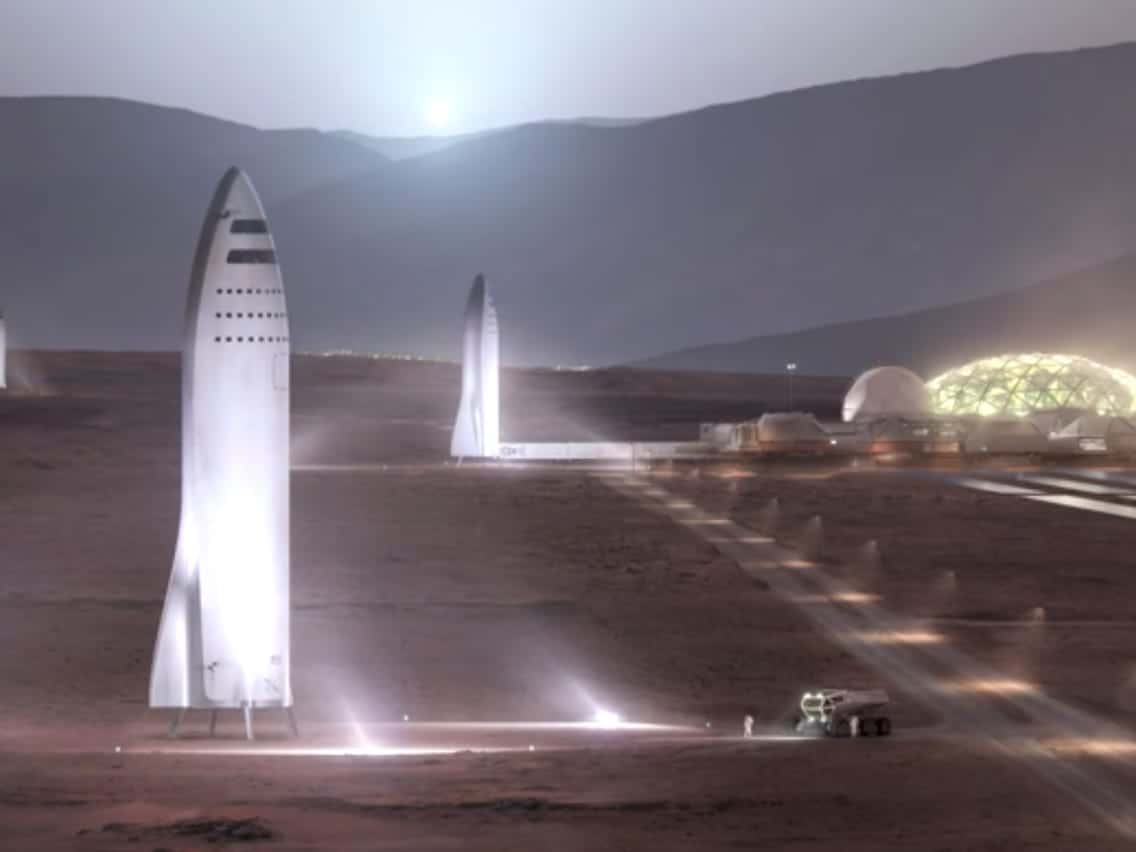
Who Is Going to Mars in 2020 and 2023?
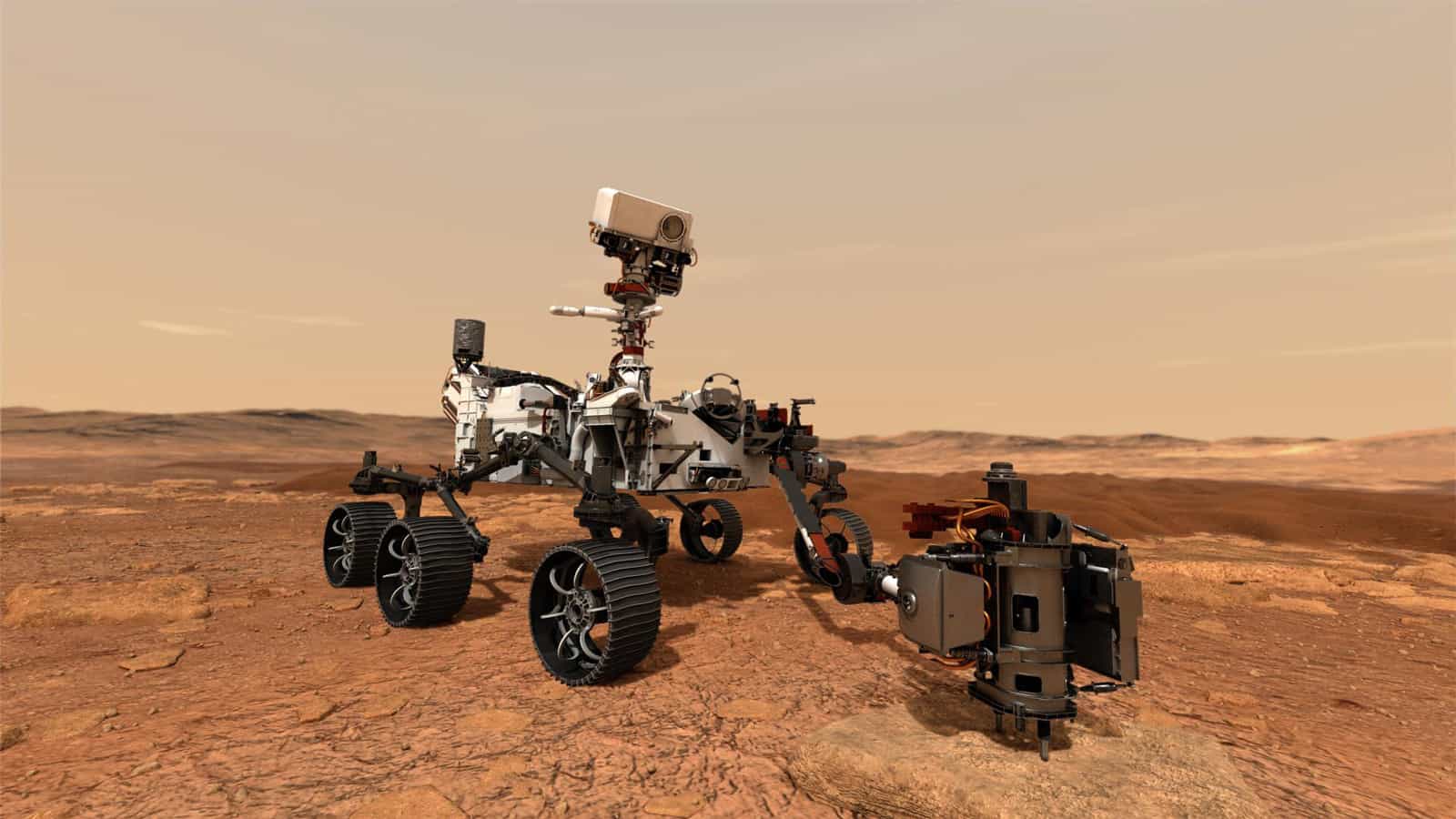
Can You Breathe on Mars?
Unfortunately, Mars’s atmosphere is made up of around 95% carbon dioxide. This means that you couldn’t breathe on the Red Planet, and you would almost instantly die of hypoxia. Apart from this, Mars is really a cold place with average surface temperatures reaching 21 degrees Celsius; however, in the night, temperatures drop to -62 degrees Celsius. The Martian dust is also dangerous to humans, as it is toxic, finely grained, and abrasive, which is terrible for our lungs if we were exposed to it.
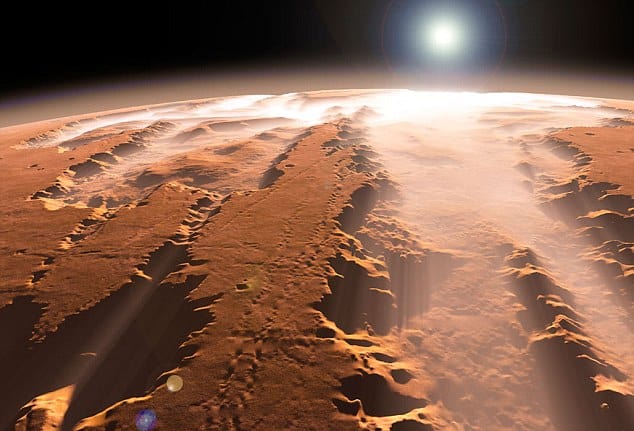
The last thing to worry about would be radiation. Mars is full of it since its atmosphere, and lack of a global magnetic field means that the planet is showered by radiation through high-energy cosmic rays and solar particles. Astronomers will have to face all of these things if they ever get to Mars, but with our current technology, some of these problems might be easily solved. It remains to be seen what other new technologies we will have in the near future that would increase our chances of colonizing Mars.
Did you know?
- The first spacecraft to orbit around Mars, was NASA’S Mariner 9 probe. It was sent to Mars in 1971, and it reached the Red Planet in just 168 days.
- The first U.S. spacecraft to land on Mars was Viking 1. This occurred in 1975.
- The first spacecraft to go to Mars was NASA’s Mariner 4. This happened in 1965, and it arrived at its destination in just 228 days.
- Mars has two moons, namely Phobos and Deimos, but they are very small, both of them put together would still be smaller than our Moon.
- Perseverance is headed towards Mars. The European Space Agency is preparing to send their own first rover to the Red Planet as well. The rover is named Rosalind Franklin, after the British DNA pioneer.
- China is also planning to send a spacecraft to Mars – both a rover and orbiter. The United Arab Emirates has plans to send an orbiter to Mars in 2020 as well, but the current COVID crisis might hinder this.
- Mars has only 11% of our Earth’s mass. It is the second-smallest planet in the Solar System , having a diameter of only 6.779 km / 4.212 mi (30% bigger than Mercury ), and a radius of 3.389 km / 2.105 mi.
- It would take around 7 million Mars-sized planets to fill the Sun.
Image Sources:
- https://www.vaisala.com/sites/default/files/styles/16_9_liftup_extra_large/public/images/LIFT-Mars%20the%20Red%20Planet-1600×900.jpg?itok=YXq-Cv1K
- https://advancedtech.airliquide.com/sites/abt_at/files/styles/800×625/public/2016/12/06/mars-short-read-overlay1.jpg?itok=tZPadBNH
- https://images.theconversation.com/files/88105/original/image-20150710-17473-idj453.jpg?ixlib=rb-1.1.0&q=45&auto=format&w=926&fit=clip
- https://i.insider.com/59dd480492406c2c768b4d7a?width=1136&format=jpeg
- https://www.jpl.nasa.gov/images/mars2020/20200727/PIA23491-16.jpg
- https://www.sciencealert.com/images/2019-02/processed/MarsOneBankrupt2019_1024.jpg
- https://planetary-science.org/wp-content/uploads/2014/12/6a00d8341bf7f753ef01b7c705f443970b-800wi.jpg
- Mars Webcam
- About this blog
- turned_in_not
Time delay between Mars and Earth
- access_time 05/08/2012
- chat_bubble_outline 68 comments
Spacecraft event time vs. Earth receive time

A photo of the Mars Express delay display on the control system, showing us the critical numbers of one-way light time, two-way light time and the distance from Earth.
One of the most difficult things about operating a spacecraft around Mars (not to mention the different time zones ), compared with the Earth, is that it’s so far away!
Mars is so far away in fact that it takes radio signals quite a long time to get from the spacecraft back to Earth. During Curiosity EDL, this delay will be 13 minutes, 48 seconds, about mid-way between the minimum delay of around 4 minutes and the maximum of around 24 minutes.
This makes it a challenge to operate Mars Express because it’s hard to have a conversation with the spacecraft, or react if anything happens on board. If there is a problem and the spacecraft tells us, we won’t know for 13 minutes, and then even if we react straight away it’ll be another 13 minutes before our instructions get back to Mars – there’s a lot that can happen in half an hour at Mars (for example a whole Curiosity landing)!
To keep Mars Express flying safely, we load all the commands for the mission in advance and built in lots of autonomy to let the spacecraft take care of itself – you could say that for the Curiosity landing we’re running completely on autopilot!
The delay is nothing to do with the spacecraft or the hardware on the ground – it can’t be improved by a faster computer or a more powerful radio. In fact it is obeying the fundamental speed limit of the universe – the speed of light.
At 1,079,000,000 km/hour, light is pretty quick; you could get from here to the Moon in a little over a second! But that just underlines how far away Mars is.
All light (or electromagnetic radiation, which includes radio signals) travels up to this speed, and radio waves from Earth to Mars Express and back are no exception. Take a look at the Wikipedia article on the speed of light and you’ll see how, in 1905, Einstein came upon the concept of this cosmic speed limit.
Above all, for tomorrow’s coverage of the Curiosity landing it makes it challenging for us to work out when to tell you what’s happening (as you’ve seen in our three column timeline )!
At ESOC, we talk about two different times – Spacecraft Event Time (SCET) and Earth Received Time (ERT). The former is what’s actually happening at Mars right now, although we won’t hear about it until over 13 minutes later, a time we call ERT.
The delay between the two is usually called the One-Way Light Time (OWLT) and the time for a message to go to Mars and come back is the Two-Way Light Time (TWLT), or round-trip time.
During all our coverage we’ll follow NASA’s lead and generally communicate events here and on Twitter to you in ERT because that’s when we’ll actually know what’s happened. If we do communicate something in SCET we’ll let you know so you (and us too) don’t get confused – it’s all part of the fun of exploring the Solar System!
Written by Thomas Ormston
Discussion: 68 comments
The distance from earth to sun is higher than that to Mars. It takes 8 minutes to suns light to reach earth. Why then signal takes 13 minutes to reach earth?
That’s because the light from the sun is photonic whereas the radio signals are electromagnetic radiation (sort of light), they don’t travel at the same speed as light.
Em, don’t radio waves travel at the speed of light in vacuum?
Yes radio signal is fast but light travels faster
Orbital distance is lower. Orbits are different. Therefore, whilst light speed = radio speed. distance travelled depends on orbital location distance!
Both travel at the speed of light, it takes 13 minutes for us to send a signal and get a signal back, it goes both ways so it takes a while. To just send a signal there, it takes 6 minutes and 30 seconds.
No, all parts of the electromagnetic spectrum travel at the speed of light in a vacuum; they simply have different wavelengths/frequencies.
No, all waves travel at the same speed. It takes light eight minutes on a one way trip, 16 minutes on a two way trip. Please learn to into physics
A “photon” is the carrier particle for both visible light AND radio waves, both of which are forms of electromagnetic energy, just at different frequencies. “Photonic energy” (which I’ve never heard of) would be synonymous with electromagnetic energy. Light, heat, gamma, radio, microwaves, ultraviolet – all are mediated by photon particles, but possess properties of waves as well, hence the “frequency” characteristic. Easiest to think of them as waves while they are traveling, but particles when they strike something.
And those numbers only apply to light traveling in vacuum. Light passing through matter travels measurably slower. I think some lab recently performed an experiment in which they “stopped light” inside a substance by slowing it waaaaaay down somehow. Don’t know how they did it, I didn’t read the whole thing.
would it stand to reason then, that certain frequencies of electromagnetic energy travel “faster” as they interact less with most forms of matter and thus have less interference when traveling large distances than other wavelengths traveling the same path and distance?
for example, inferred light compared to gamma-radiation, inferred light would have a higher chance of interacting with a medium compared to gammarays delaying the wavelength as it passes through minuscule amounts of matter. Could one say this would result in gammarays having a faster “net speed” on average?
Incorrect. Allow me to quote directly from the article you just read since you seem to have missed it.
“At 1,079,000,000 km/hour, light is pretty quick; you could get from here to the Moon in a little over a second! But that just underlines how far away Mars is.
All light (or electromagnetic radiation, which includes radio signals) travels up to this speed, and radio waves from Earth to Mars Express and back are no exception.”
The time from Earth to Mars varies between 4 and 24 minutes because earth (and mars) are both orbiting the sun, not each other. The distance between them therefore can change quite dramatically depending on where we are in our respective orbits.
When Mars is directly behind Earth at the closest possible point, it is only four minutes away. When it is at the farthes point opposite us behind the Sun, it is 24 minutes away. The Sun meanwhile, which we orbit, remains at roughly 8 minutes away since our orbit around the Sun is very nearly circular.
One more note, assuming Mars is also a circular orbit (which it is not) you could assume that the distance from mars to the sun is roughly 12 minutes and implying that the maximum distance would be 8 + 12 which would only be 20 minutes.
However this is not the case since Mars’ orbit is somewhat eliptical and in a slightly different plane from Earths orbit as well making it possible for them to be as distant as 24 minutes.
Just came across this: Radio signals are electromagnetic waves, such as light or X-ray. The speed of electromagnetic waves in vacuum, is 300000km/sec (approximately).
In order to calculate the time of travel with this speed from Earth to Mars, we need to know the distance.
When the Mars and the Earth are at the opposite sides of the Sun, the distance is the largest: approximately: 378 million km. The time needed for an electromagnetic wave to cover this distance is approximately: 21 minute.
The closest distance between Mars and Earth is 78 million km, the time in this case is: 4.3 min.
So the time of travel between Earth and Mars is between 4.3 minutes and 21 minutes, depending on the actual distance between the two planets.
Shab, you are calculating as if it is 2D plane, while DoctorZuber already mentioned the earth and mars elipses are of different plane.
So when Mars is at the exact opposite of Earth and the Sun is directly in between. Would it be possible for radio to even transmit to Earth Via right thru the sun?
You are wrong. It is because the earth is often much further from Mars than Mars is from the sun.
Usually I mean. The distances vary greatly, of course.
yo wassup guys whats lite
Guys guys guys u are over anylizing everything. It’s cause mars is further from earth than the sun sometimes cause of orbits
Yes they do. (Buy better science books.)
No, it takes 13 minutes round trip. Half that from Earth to Mars (depending on relative positions of both planets in their orbits). To my knowledge, there is no such thing as “photonic.” Light is electromagnet waves (or photons depending on the nature of the experiment you use to determine that – see “double slit light experiments”). All electromagnet waves travel at the same speed in space.
The article gives you the clue doesn’t it? Since the orbit of Mars is elliptical (not circular!), the epihelion and perihelion (i.e. shortest distance and the furthest Mars is from Earth) differs periodically.
The distance between the Earth and the Sun is based on our orbit and is relatively constant (about 92,960,00 miles). Since both the Earth and Mars orbit the sun at different distances and speed, the distance between us constantly changes. At times Mars is on the other side of the Sun from us and other times it is on the same side. When Mars is closest to Earth it can be as close as 34,000,000 miles, but when they are the furthest apart they can be almost 250,000,000 miles apart.
Hi, We gotta come to a common term for distance. Metric is proven to be easy and base of all science. When please switch to metric and use kilo meter. thanks
Just multiply miles by 1.8 to get equivalent kilometers. Or kilometers by .6 to get miles. Now you should be covered unless someone here starts talking about rods or leagues or something weird like that.
Actually, 1 mile = 1.625 km.
Just to assure accuracy for the people visiting. If you decide that you would like to do any maths related to this subject, here are the actual conversion values for U.S. and Metric measurements of distance:
1 mile = 1.609334 km (1.609 is close enough) 1km = 0.621371192 mile (0.621 is OK also)
No, we won’t use metric exclusively. Metric isn’t simpler, and miles are well established not only in the USA but in the UK too, and the UK helps to fund the ESA and the EU, so the ESA and the EU should use the BOTH measurement systems, instead of trying to impose metric on everyone.
Metric has been established in the UK for decades. School science has used SI and not Imperial for decades. Trying to use both systems would waste time and risk dangerous errors.
Meters are part of the SI system of units ( https://en.wikipedia.org/wiki/International_System_of_Units ). It becomes very complicated to use any standard derived unit such as Newton (Force) expressed by miles and pounds.
Further, 1 cubic decimeter equals 1 liter of water weighing 1kg which can also come in quite handy in everyday life. This is quite a trick in inches, fluid ounces, and pound 😉
No we don’t. You can use your metric system and we can use our British/American system.
We don’t speak one language, and we don’t need one system of measurement.
It’s good to be fluent in multiple systems.
There is a good reason to stick to metric when discussing scientific matters. Several space missions have failed disasterously due to mix-ups translating between the two 😛
Please not distance from earth to mars is about 225 million km (not miles).
the change in distances are also one reason they have to plan specific dates when launching satellites to Mars or any other planets.
It’s more like very different because mars also orbits the sun, but slower than earth, sometimes it is from our view behind the sun and other cases behind us
That is incorrect. Distance to sun 96 million miles. Distance to Mars, 140 million.
The distance to Mars varies because the Earth and Mars are both orbiting the sun, but not at the same speed or the same distance from the sun. Sometimes we are on the opposite side of the sun from Mars, and the sun is therefore closer to us than Mars is.
dude, shit happens
If the earth is on one side of the sun and mars is on the other side, then the distance from the earth to mars is greater than from the earth to the sun. Seems pretty straight forward. All electromagnetic radiation travels at the speed of light. Gladson is wrong.
Both earth and mars are in orbit around the sun. We make the trip in 265 earth days. Mars requires 669 earth days. Mars mean orbital radius to the sun is 1.6 times that of earth. We can be MUCH closer to Mars than the sun, or 2.6 times as far away, depending on our relative orbital positions.
Round trip radio time depends on where earth and mars are relative to the sun. If we are at our closest point to mars, R/T transit time is 4 minutes. If we are at opposite sides of the sun, R/T time is 24 minutes.
365 earth days
It varies, because Earth and Mars orbit the sun at different speeds. Sometimes they are on the same side of the sun and, at closest approach, light only takes about 3 minutes to travel between the two. Sometimes they are on opposite sides of the sun and it takes up to about 22 minutes. As to the other responses, the difference between speed of light and radio waves is negligible over these short distances.
Depends on the positionsame of earth and Mars. If we are on the same side of sun we are closer. If the planets are on opposite sides of sun. The sun is closer. The sun distance from Earth is relatively constant. Mars is not.
It’s a two way signal. Query and Response.
Because mars can be on the complete opposite side of the sun compared to the earth
Varges, we are not necessarily the same side of the sun at the same time – so the longest time is for when Earth and Mars are 180 degrees opposite each other and both at aphelion, and the shortest would be when we are both the same side, with Mars at perihelion and Earth at aphelion.:
o —————O——————-o o——-o————O
Now you are making sense, but at that point how much longer will it take the suns light to reach mars?
How much time could we have cut from our journey to mars if we timed it accordingly?
Well, you have to remember that both Earth and Mars are moving at different speeds while the rocket is en route. Google “hohmann transfer” for details on that if you’re interested.
Glad you didn’t bring in Einstein’s curved space theory! If you had then they’d be even more confused about how the Sun depresses Space/Time and therefore the distance light travels when Mars is on the opposite side of the sun as Earth then the curvilinear distance is actually greater than a straight line and the time for the message to get to Mars actually increases by the lending effect
Should be “Lensing effect!”
How do you determine the exact time when the sun spot is intitially emitted.
This is extremely important and could be cause fundament change in physics since Maxwell’s theory is justified by the relation between the velocity of light and the radio induction effect.
Nobody is suggesting that there need to be fundamental changes in physics here. I’m not sure where you would get that idea.
I don’t understand. Didn’t Khan do this and end up getting the enterprise destroyed at one point?
12 minutes and 60 seconds? 13 minutes!
I just want to establish some facts here for those who are confused about physics. 1) Electromagnetic radiation and light are the same thing. That includes visible light, radio waves, and so forth. There is no such thing as “Photonic energy”. 2) All light, regardless of frequency, travels at the same speed in a vacuum, known as the “speed of light”. The speed of light in matter can vary, but in this case that is not important since all the space between mars, the earth, and the sun is vacuum. There is no air in space.
If earth and Mars are traveling in different orbits around our sun ,their distances between them is continually changing and so will be the communication speed and all this makes it even more complicated on a permanent basis to figure this out (just a bit to much for my math capabilities) I really appreciate the skills of the modern scientists to make this all possible. You are all the frontiersmen and women of humanity……thanks!
I was having a discussion with my Circuits professor about the speed of communication to the Rover being faster than light. My professor and I wondered how that was possible. Thanks for all the great Info.
Bulldog6 Through quantum entanglement that would be possible however it has only been preformed on particles, scientists are yet to find a way for this to be used in a wave which is what would need to be done to communicate with the Rover at faster than light communication. For now communication with the Mars Rover happens at the speed of light until a better understanding of quantum entanglement comes into existence.
Can we discuss then through a light system rather than a radio system ?
Can We transmit using light? a laser light pointing to space satellites, and satellites to satellites by laser light ( like station to station ) then to the nearest satellites to the earth or mars…
using few laser light pointing at the same time to transmitt few data in the same time.. speed up the tranmittion.
laser light on going straight line.. so .. i guess not easy to aim..pointing from satellites to satellites.. or mars to satellites…..
its something like using scope on the satellite watch on top of the rover.. its kind like back to human early using light as signal.. but just by fire and now using laser gun which very command now..
Radio signals are a light wave and travel at the same speed as the light emitted from a laser. The advantage to radio waves is that they are more broad than a beam of light emitted from a laser so pin point accuracy is not needed to get a message from Earth to the rovers on Mars’ surface
Since we have established that light and radio waves go at the same speed, it would make no differences.
transmission time would still be the same
Wait until the planets about a hundred light years away pick up our 1960-2017 broadcasts. They will probably shoot us with some kind of deadly weapon.Earlier broadcasts before 1960 will probably be fine, even pleasant, but anything after 1960, especially 2008 on, we are going to be in big trouble with superior species
Leave a Reply Cancel reply
Your email address will not be published. All fields are mandatory.
Save my name, email, and website in this browser for the next time I comment.
MEX 10 years top links
Old mex blog, replay: google hangout.

REPLAY: ESAHangout

VMC Imaging Campaign
Want to travel to Mars? Here’s how long the trip could take.
Nuclear engines or not, you're gonna need a lot of PTO to get to the Red Planet.
By Eva Botkin-Kowacki | Published Feb 21, 2023 6:00 AM EST

Despite what Star Trek’s warp-speed journeys would have us believe, interplanetary travel is quite the hike. Take getting to Mars. Probes sent to the Red Planet by NASA and other space agencies spend about seven months in space before they arrive at their destination. A trip for humans would probably be longer—likely on the timescale of a few years.
There are a lot of things that a human crew needs to survive that robots don’t, such as food, water, oxygen, and enough supplies for a return—the weight of which can slow down a spacecraft. With current technology, NASA calculations estimate a crewed mission to Mars and back, plus time on the surface , could take somewhere between two and three years. “Three years we know for sure is feasible,” says Michelle Rucker, who leads NASA’s Mars Architecture Team in the agency’s Human Exploration and Operations Mission Directorate .
But NASA aims to shorten that timeline, in part because it would make a Mars mission safer for humans—we still don’t know how well the human body can withstand the environment of space for an extended period. (The record for most consecutive days in space is 437.) The agency is investing in projects to develop new propulsion technologies that might enable more expeditious space travel.
A crooked path to Mars
In a science-fictional world, a spacecraft would blast off Earth and head directly to Mars. That trajectory would certainly make for a speedier trip. But real space travel is a lot more complicated than going from point A to point B.
“If you had all the thrust you want, you could ignore the fact that there happens to be gravity in our universe and just plow all the way through the solar system,” says Mason Peck , a professor of astronautics at Cornell University who served as NASA’s chief technologist from 2011 to 2013. “But that’s not a scenario that’s possible right now.”
Such a direct trajectory has several challenges. As a spacecraft lifts off Earth, it needs to escape the planet’s gravitational pull, which requires quite a bit of thrust. Then, in space, the force of gravity from Earth, Mars, and the sun pulls the spacecraft in different directions. When it is far enough away, it will settle into orbit around the sun. Bucking that gravity requires fuel-intensive maneuvers.
[Related: Signs of past chemical reactions detected on Mars ]
The second challenge is that the planets do not stay in a fixed place. They orbit the sun, each at its own rate: Mars will not be at the same distance from Earth when the spacecraft launches as the Red Planet will be, say, seven months later.
As such, the most fuel-efficient route to Mars follows an elliptical orbit around the sun, Peck says. Just one-way, that route covers hundreds of millions of miles and takes over half a year, at best.
But designing a crewed mission to the Red Planet isn’t just about figuring out how fast a spacecraft can get there and back. It’s about “balance,” says Patrick Chai, in-space propulsion lead for NASA’s Mars Architecture Team . “There are a whole bunch of decisions we have to make in terms of how we optimize for certain things. Where do we trade performance for time?” Chai says. “If you just look at one single metric, you can end up making decisions that are really great for that particular metric, but can be problematic in other areas.”
One major trade-off for speed has to do with how much stuff is on board. With current technology, every maneuver to shorten the trip to Mars requires more fuel.
If you drive a car, you know that in order to accelerate the vehicle, you step on the gas. The same is true in a spacecraft, except that braking and turning also use fuel. To slow down, for instance, a spacecraft fires its thrusters in the opposite direction to its forward motion.
But there are no gas stations in space. More fuel means more mass on board. And more mass requires more fuel to propel that extra mass through the air… and so on. Trimming a round-trip mission down to two years is when this trade-off starts to become exponentially less efficient, Rucker says. At least, that’s with current technology.
New tech to speed up the trip
NASA would like to be able to significantly reduce that timeline. In 2018, the space agency requested proposals for technological systems that could enable small, uncrewed missions to fly from Earth to Mars in 45 days or less .
At the time, the proposals didn’t gain much traction. But the challenge inspired engineers to design innovative propulsion systems that don’t yet exist. And now, NASA has begun to fund the development of leading contenders. In particular, the space agency has its eye on nuclear propulsion.
Spacecraft currently rely largely on chemical propulsion. “You basically take an oxidizer and a fuel, combine them, and they combust, and that generates heat. You accelerate that heated product through a nozzle to generate thrust,” explains NASA’s Chai.
Engineers have known for decades that a nuclear-based system could generate more thrust using a significantly smaller amount of fuel than a chemical rocket. They just haven’t built one yet—though that might be about to change.
One of NASA’s nuclear investment projects aims to integrate a nuclear thermal engine into an experimental spacecraft. The Demonstration Rocket for Agile Cislunar Operations , or DRACO, program, is a collaboration with the Defense Advanced Research Projects Agency (DARPA), and aims to demonstrate the resulting technology as soon as 2027 .
[Related: Microbes could help us make rocket fuel on Mars ]
The speediest trip to Mars might come from another project, however. This concept, the brainchild of researchers at the University of Florida and supported by a NASA grant, seeks to achieve what Chai calls the “holy grail” of nuclear propulsion: a combination system that pairs nuclear thermal propulsion with an electric kind.
“We did some preliminary analysis, and it seems like we can get pretty close to [45 days],” says the leader of that project, Ryan Gosse, a professor of practice in the University of Florida’s in-house applied research program, Florida Applied Research in Engineering (FLARE). One caveat: That timeline is for a light payload and no humans on board. However, if the project is successful, the technology could potentially be scaled up in the future to support a crewed mission.

There are two types of nuclear propulsion, and both have their merits. Nuclear thermal propulsion, which uses heat, can generate a lot of thrust quickly from a small amount of fuel. Nuclear electric propulsion, which uses charged particles, is even more fuel-efficient but generates thrust much more slowly.
“While you’re in deep space, the electric propulsion is really great because you have all the time in the world to thrust. The efficiency, the miles per gallon, is far, far superior than the high-thrust,” Chai says. “But when you’re around planets, you want that oomph to get you out of the gravity well.”
The challenge, however, is that both technologies currently require different types of nuclear reactors, says Gosse. And that means two separate systems, which reduces the efficiency of having a nuclear propulsion system. So Gosse and his team are working to develop technology that can use the one system to generate both types of propulsion.
NASA’s Mars architecture team is also working with a bimodal concept that uses a chemical propulsion system to maneuver around planets and solar-powered electric propulsion to do the thrusting in deep space.
“What we are developing is different tools for the toolbox,” says NASA’s Rucker. “One tool isn’t going to be enough to do all of the exploration that we want to do. So we’re working on all of these.”
Like science, tech, and DIY projects?
Sign up to receive Popular Science's emails and get the highlights.

Distances in Light Time between Planets and the Sun
Light time introduces the concept of length associated with the distance traveled by the light itself over a period of time.
In particular, the light year is a unit of length measurement, defined as the distance traveled by electromagnetic radiation (with the term light referring to the spectral portion visible from the human eye) in the vacuum, in a sidereal year (365 Days, 6 hours, 9 minutes, and 10 seconds).
The speed of light (c) in the void is 299 792,458 (km/s) . To have that distance in miles, just multiply that value over the time range considered. Approximately 9461 billion kilometers (or 63 241 times the distance between Earth and the Sun, also called astronomical units, is 149 597 870,700 km ).
The light year, like parsec (about 3.26 light years), is mainly used for galactic distances. Below are the distances between the Sun and the planets belonging to the Solar System in light time .
- Mercury : 3,3 light minutes
- Venus : 6 light minutes
- Earth : 8,3 light minutes
- Mars : 12,7 light minutes
- Jupiter : 43 light minutes
- Saturn : 1,3 light hours
- Uranus : 2,7 light hours
- Neptune : 4,2 light hours
Pluto, the dwarf planet, is at 5.3 light hours from us. You must travel a distance of one light year to get out of the Solar System; While you should travel at the speed of light for just over 4 years before encountering another star, Proxima Centauri.
- distances in light time
- solar system
- speed of light

Related articles

A new way to study Magnetic Fields in Galaxy Clusters

SpaceX brings the US back to space after 9 years
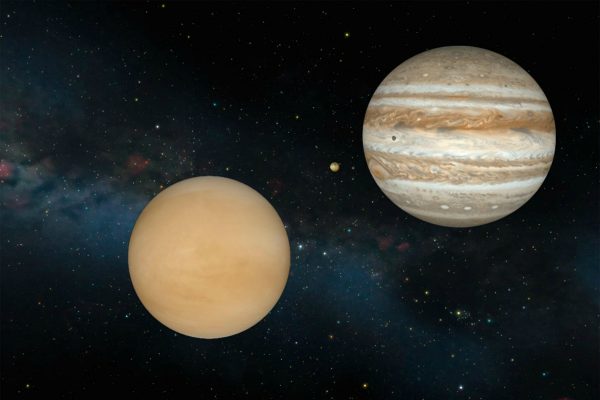
Conjunction of Venus and Jupiter between 12th and 13th November
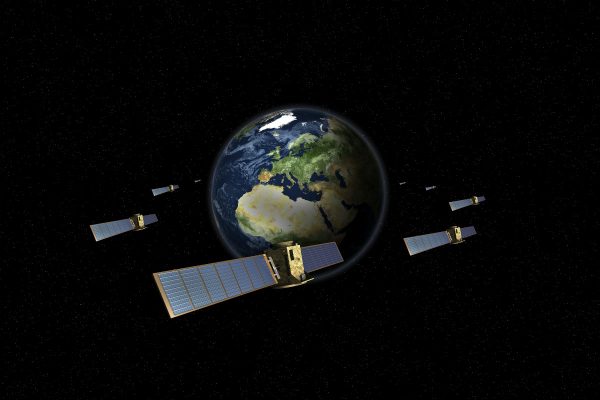
GPS satellites: “The largest Dark Matter detector ever built”
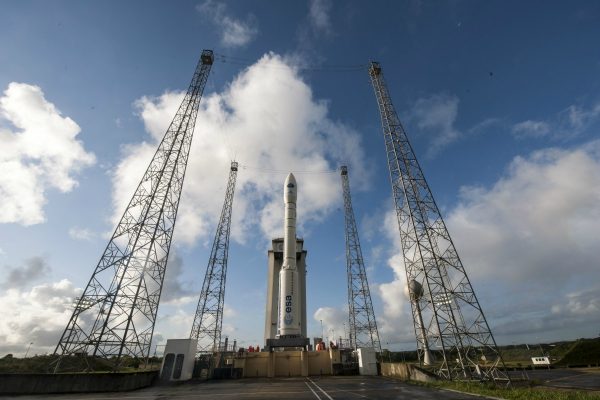
Vega: The 11th consecutive successful mission

60 Years Ago, Laika Died Alone in Space Aboard Sputnik 2
Lascia un commento annulla risposta.
Devi essere connesso per inviare un commento.
Recent Posts

Popular Posts

The Space Shuttle: How it works before and after launch

Brain Stimulation | Consciousness Restored in Man Who Was in a Vegetative State for 15 Years

Super Cute Home Robots are coming, but don’t trust them too much

NASA’s 2020 Mars Rover Will Have 23 Cameras

Ephemeris Calculator
Compute Mars ephemerides for any date and time between 01 Jan 1600 and 31 Dec 2499 and display the predicted position in an interactive sky map.
How Far Away is Mars from Earth?
The distance of Mars from Earth is currently 297,189,143 kilometers, equivalent to 1.986587 Astronomical Units . Light takes 16 minutes and 31.3163 seconds to travel from Mars and arrive to us.
- Mars Information on TheSkyLive.com
- Where is Mars?
- How far is Mars from Earth?
- When does Mars rise and set?
- How bright is Mars?
- Interactive sky map
- Live position tracker
Disclaimer: The following material is being kept online for archival purposes.
Although accurate at the time of publication, it is no longer being updated. the page may contain broken links or outdated information, and parts may not function in current web browsers., #21b flight to mars: how long along what path, above is background material for archival reference only..
The speed of light is torturously slow, and these 3 simple animations by a scientist at NASA prove it
- The speed of light in a vacuum is about 186,282 miles per second (299,792 kilometers per second).
- A scientist at NASA animated how long it takes light to travel around Earth, as well as between the planet, its moon, and Mars.
- The physics animations show just how fast (and slow) the speed limit of the universe can be.
A series of new animations by a NASA scientist show just how zippy — and also how torturously slow — the speed of light can be.
Light speed is the fastest that any material object can travel through space. That is, of course, barring the existence of theoretical shortcuts in the fabric of space called wormholes (and the ability to go through them without being destroyed).
In a perfectly empty vacuum, a particle of light, which is called a photon, can travel 186,282 miles per second (299,792 kilometers per second), or about 670.6 million mph (1.079 billion kilometers per hour).
This is incredibly fast. However, light speed can be frustratingly slow if you're trying to communicate with or reach other planets, especially any worlds beyond our solar system.
Read more : Astronomers found a 'cold super-Earth' less than 6 light-years away — and it may be the first rocky planet we'll photograph beyond the solar system
To depict the speed limit of the cosmos in a way anyone could understand, James O'Donoghue , a planetary scientist at NASA's Goddard Space Flight Center, took it upon himself to animate it.
"My animations were made to show as instantly as possible the whole context of what I'm trying to convey," O'Donoghue told Business Insider via Twitter . "When I revised for my exams, I used to draw complex concepts out by hand just to truly understand, so that's what I'm doing here."
O'Donoghue said he only recently learned how to create these animations — his first were for a NASA news release about Saturn's vanishing rings . After that, he moved on to animating other difficult-to-grasp space concepts, including a video illustrating the rotation speeds and sizes of the planets. He said that one "garnered millions of views" when he posted it on Twitter .
O'Donoghue's latest effort looks at three different light-speed scenarios to convey how fast (and how painfully slow) photons can be.
How fast light travels relative to Earth
One of O'Donoghue's first animations shows how fast light moves in relation to Earth.
Earth is 24,901 miles around at its center. If our world had no atmosphere (air refracts and slows down light a little bit), a photon skimming along its surface could lap the equator nearly 7.5 times every second.
In this depiction , the speed of light seems pretty fast — though the movie also shows how finite it is.
How fast light travels between Earth and the moon
A second animation by O'Donoghue takes a big step back from Earth to include the moon.
Related stories
On average, there is about 238,855 miles (384,400 kilometers) of distance between our planet and its large natural satellite.
This means all moonlight we see is 1.255 seconds old, and a round-trip between the Earth and moon at light speed takes about 2.51 seconds.
This timing is growing every day, however, as the moon is drifting farther from Earth at a rate of about 1.5 inches (3.8 centimeters) per year. (The moon is constantly sapping Earth's rotational energy via ocean tides , boosting its orbit to a greater and greater distance.)
How fast light travels between Earth and Mars
O'Donoghue's third speed-of-light animation illustrates the challenge that many planetary scientists deal with on a daily basis.
When NASA tries to talk to or download data from a spacecraft, such as the InSight probe on Mars , it can do so only at the speed of light. This is much too slow to operate a spacecraft in "live mode" as you would a remote-controlled car. So, commands must be carefully thought out, prepackaged, and aimed at the precise location in space at the precise time so that they don't miss their target.
Read more : NASA can hear the 'haunting' sound of dust devils tearing across Mars with its new $830 million lander
The fastest a conversation could ever happen between Earth and Mars is when the planets are at their nearest point to one another, an event called closest approach that happens once roughly every two years. On average, that best-case-scenario distance is about 33.9 million miles (54.6 million kilometers).
As that 60-second clip of O'Donoghue's full movie on YouTube shows, light takes 3 minutes 2 seconds to travel between Earth and Mars at closest approach. That's six minutes and four seconds for a light-speed round-trip.
But on average, Mars is about 158 million miles from Earth — so the average round-trip communication takes about 28 minutes and 12 seconds.
The speed of light gets more depressing the farther you go
The hurdle of light's finite speed gets even more challenging for spacecraft such as New Horizons, which is now more than 4 billion miles from Earth , and the Voyager 1 and 2 spacecraft, each of which have reached the space between stars .
The situation gets downright depressing when you start looking outside the solar system. The closest-known exoplanet , called Proxima b, is about 4.2 light-years away from us (a distance of about 24.7 trillion miles or 39.7 trillion kilometers).
However, the fastest any spacecraft has ever gone is NASA's Parker Solar Probe at about 213,200 mph ; at that speed, it'd take 13,211 years to reach Proxima b.
A Russian-American billionaire's Breakthrough Starshot project envisions a way to address this speed problem. The multidecade plan is to build and fly tiny "nanocraft" past such exoplanets via ultrapowerful laser blasts , ideally at a planned cruise velocity of 20% of the speed of light. Yet the entire concept is still theoretical, may end up not working, and would operate at a fraction of light-speed.
Space is impossibly vast. Although the universe is about 13.77 billion years old, its edge is about 45.34 billion light-years away in any direction and is increasing due to expansion .
That's far too big to illustrate in a simple animation. One illustration comes close, though: this image created by musician Pablo Carlos Budassi , which combines logarithmic maps of the universe from Princeton and images from NASA to capture it all in one picture.
This story has been updated.
Watch: What humans will look like on Mars
- Main content

Chapter 15: Galaxies
Chapter 1 how science works.
- The Scientific Method
- Measurements
- Units and the Metric System
- Measurement Errors
- Mass, Length, and Time
- Observations and Uncertainty
- Precision and Significant Figures
- Errors and Statistics
- Scientific Notation
- Ways of Representing Data
- Mathematics
- Testing a Hypothesis
- Case Study of Life on Mars
- Systems of Knowledge
- The Culture of Science
- Computer Simulations
- Modern Scientific Research
- The Scope of Astronomy
- Astronomy as a Science
- A Scale Model of Space
- A Scale Model of Time
Chapter 2 Early Astronomy
- The Night Sky
- Motions in the Sky
- Constellations and Seasons
- Cause of the Seasons
- The Magnitude System
- Angular Size and Linear Size
- Phases of the Moon
- Dividing Time
- Solar and Lunar Calendars
- History of Astronomy
- Ancient Observatories
- Counting and Measurement
- Greek Astronomy
- Aristotle and Geocentric Cosmology
- Aristarchus and Heliocentric Cosmology
- The Dark Ages
- Arab Astronomy
- Indian Astronomy
- Chinese Astronomy
- Mayan Astronomy
Chapter 3 The Copernican Revolution
- Ptolemy and the Geocentric Model
- The Renaissance
- Copernicus and the Heliocentric Model
- Tycho Brahe
- Johannes Kepler
- Elliptical Orbits
- Kepler's Laws
- Galileo Galilei
- The Trial of Galileo
- Isaac Newton
- Newton's Law of Gravity
- The Plurality of Worlds
- The Birth of Modern Science
- Layout of the Solar System
- Scale of the Solar System
- The Idea of Space Exploration
- History of Space Exploration
- Moon Landings
- International Space Station
- Manned versus Robotic Missions
- Commercial Space Flight
- Future of Space Exploration
- Living in Space
- Moon, Mars, and Beyond
- Societies in Space
Chapter 4 Matter and Energy in the Universe
- Matter and Energy
- Rutherford and Atomic Structure
- Early Greek Physics
- Dalton and Atoms
- The Periodic Table
- Structure of the Atom
- Heat and Temperature
- Potential and Kinetic Energy
- Conservation of Energy
- Velocity of Gas Particles
- States of Matter
- Thermodynamics
- Laws of Thermodynamics
- Heat Transfer
- Thermal Radiation
- Radiation from Planets and Stars
- Internal Heat in Planets and Stars
- Periodic Processes
- Random Processes
Chapter 5 The Earth-Moon System
- Earth and Moon
- Early Estimates of Earth's Age
- How the Earth Cooled
- Ages Using Radioactivity
- Radioactive Half-Life
- Ages of the Earth and Moon
- Geological Activity
- Internal Structure of the Earth and Moon
- Basic Rock Types
- Layers of the Earth and Moon
- Origin of Water on Earth
- The Evolving Earth
- Plate Tectonics
- Geological Processes
- Impact Craters
- The Geological Timescale
- Mass Extinctions
- Evolution and the Cosmic Environment
- Earth's Atmosphere and Oceans
- Weather Circulation
- Environmental Change on Earth
- The Earth-Moon System
- Geological History of the Moon
- Tidal Forces
- Effects of Tidal Forces
- Historical Studies of the Moon
- Lunar Surface
- Ice on the Moon
- Origin of the Moon
- Humans on the Moon
Chapter 6 The Terrestrial Planets
- Studying Other Planets
- The Planets
- The Terrestrial Planets
- Mercury's Orbit
- Mercury's Surface
- Volcanism on Venus
- Venus and the Greenhouse Effect
- Tectonics on Venus
- Exploring Venus
- Mars in Myth and Legend
- Early Studies of Mars
- Mars Close-Up
- Modern Views of Mars
- Missions to Mars
- Geology of Mars
- Water on Mars
- Polar Caps of Mars
- Climate Change on Mars
- Terraforming Mars
- Life on Mars
- The Moons of Mars
- Martian Meteorites
- Comparative Planetology
- Incidence of Craters
- Counting Craters
- Counting Statistics
- Internal Heat and Geological Activity
- Magnetic Fields of the Terrestrial Planets
- Mountains and Rifts
- Radar Studies of Planetary Surfaces
- Laser Ranging and Altimetry
- Gravity and Atmospheres
- Normal Atmospheric Composition
- The Significance of Oxygen
Chapter 7 The Giant Planets and Their Moons
- The Gas Giant Planets
- Atmospheres of the Gas Giant Planets
- Clouds and Weather on Gas Giant Planets
- Internal Structure of the Gas Giant Planets
- Thermal Radiation from Gas Giant Planets
- Life on Gas Giant Planets?
- Why Giant Planets are Giant
- Ring Systems of the Giant Planets
- Structure Within Ring Systems
- The Origin of Ring Particles
- The Roche Limit
- Resonance and Harmonics
- Tidal Forces in the Solar System
- Moons of Gas Giant Planets
- Geology of Large Moons
- The Voyager Missions
- Jupiter's Galilean Moons
- Jupiter's Ganymede
- Jupiter's Europa
- Jupiter's Callisto
- Jupiter's Io
- Volcanoes on Io
- Cassini Mission to Saturn
- Saturn's Titan
- Saturn's Enceladus
- Discovery of Uranus and Neptune
- Uranus' Miranda
- Neptune's Triton
- The Discovery of Pluto
- Pluto as a Dwarf Planet
- Dwarf Planets
Chapter 8 Interplanetary Bodies
- Interplanetary Bodies
- Early Observations of Comets
- Structure of the Comet Nucleus
- Comet Chemistry
- Oort Cloud and Kuiper Belt
- Kuiper Belt
- Comet Orbits
- Life Story of Comets
- The Largest Kuiper Belt Objects
- Meteors and Meteor Showers
- Gravitational Perturbations
- Surveys for Earth Crossing Asteroids
- Asteroid Shapes
- Composition of Asteroids
- Introduction to Meteorites
- Origin of Meteorites
- Types of Meteorites
- The Tunguska Event
- The Threat from Space
- Probability and Impacts
- Impact on Jupiter
- Interplanetary Opportunity
Chapter 9 Planet Formation and Exoplanets
- Formation of the Solar System
- Early History of the Solar System
- Conservation of Angular Momentum
- Angular Momentum in a Collapsing Cloud
- Helmholtz Contraction
- Safronov and Planet Formation
- Collapse of the Solar Nebula
- Why the Solar System Collapsed
- From Planetesimals to Planets
- Accretion and Solar System Bodies
- Differentiation
- Planetary Magnetic Fields
- The Origin of Satellites
- Solar System Debris and Formation
- Gradual Evolution and a Few Catastrophies
- Chaos and Determinism
- Extrasolar Planets
- Discoveries of Exoplanets
- Doppler Detection of Exoplanets
- Transit Detection of Exoplanets
- The Kepler Mission
- Direct Detection of Exoplanets
- Properties of Exoplanets
- Implications of Exoplanet Surveys
- Future Detection of Exoplanets
Chapter 10 Detecting Radiation from Space
- Observing the Universe
- Radiation and the Universe
- The Nature of Light
- The Electromagnetic Spectrum
- Properties of Waves
- Waves and Particles
- How Radiation Travels
- Properties of Electromagnetic Radiation
- The Doppler Effect
- Invisible Radiation
- Thermal Spectra
- The Quantum Theory
- The Uncertainty Principle
- Spectral Lines
- Emission Lines and Bands
- Absorption and Emission Spectra
- Kirchoff's Laws
- Astronomical Detection of Radiation
- The Telescope
- Optical Telescopes
- Optical Detectors
- Adaptive Optics
- Image Processing
- Digital Information
- Radio Telescopes
- Telescopes in Space
- Hubble Space Telescope
- Interferometry
- Collecting Area and Resolution
- Frontier Observatories
Chapter 11 Our Sun: The Nearest Star
- The Nearest Star
- Properties of the Sun
- Kelvin and the Sun's Age
- The Sun's Composition
- Energy From Atomic Nuclei
- Mass-Energy Conversion
- Examples of Mass-Energy Conversion
- Energy From Nuclear Fission
- Energy From Nuclear Fusion
- Nuclear Reactions in the Sun
- The Sun's Interior
- Energy Flow in the Sun
- Collisions and Opacity
- Solar Neutrinos
- Solar Oscillations
- The Sun's Atmosphere
- Solar Chromosphere and Corona
- The Solar Cycle
- The Solar Wind
- Effects of the Sun on the Earth
- Cosmic Energy Sources
Chapter 12 Properties of Stars
- Star Properties
- The Distance to Stars
- Apparent Brightness
- Absolute Brightness
- Measuring Star Distances
- Stellar Parallax
- Spectra of Stars
- Spectral Classification
- Temperature and Spectral Class
- Stellar Composition
- Stellar Motion
- Stellar Luminosity
- The Size of Stars
- Stefan-Boltzmann Law
- Stellar Mass
- Hydrostatic Equilibrium
- Stellar Classification
- The Hertzsprung-Russell Diagram
- Volume and Brightness Selected Samples
- Stars of Different Sizes
- Understanding the Main Sequence
- Stellar Structure
- Stellar Evolution
Chapter 13 Star Birth and Death
- Star Birth and Death
- Understanding Star Birth and Death
- Cosmic Abundance of Elements
- Star Formation
- Molecular Clouds
- Young Stars
- T Tauri Stars
- Mass Limits for Stars
- Brown Dwarfs
- Young Star Clusters
- Cauldron of the Elements
- Main Sequence Stars
- Nuclear Reactions in Main Sequence Stars
- Main Sequence Lifetimes
- Evolved Stars
- Cycles of Star Life and Death
- The Creation of Heavy Elements
- Horizontal Branch and Asymptotic Giant Branch Stars
- Variable Stars
- Magnetic Stars
- Stellar Mass Loss
- White Dwarfs
- Seeing the Death of a Star
- Supernova 1987A
- Neutron Stars and Pulsars
- Special Theory of Relativity
- General Theory of Relativity
- Black Holes
- Properties of Black Holes
Chapter 14 The Milky Way
- The Distribution of Stars in Space
- Stellar Companions
- Binary Star Systems
- Binary and Multiple Stars
- Mass Transfer in Binaries
- Binaries and Stellar Mass
- Nova and Supernova
- Exotic Binary Systems
- Gamma Ray Bursts
- How Multiple Stars Form
- Environments of Stars
- The Interstellar Medium
- Effects of Interstellar Material on Starlight
- Structure of the Interstellar Medium
- Dust Extinction and Reddening
- Groups of Stars
- Open Star Clusters
- Globular Star Clusters
- Distances to Groups of Stars
- Ages of Groups of Stars
- Layout of the Milky Way
- William Herschel
- Isotropy and Anisotropy
- Mapping the Milky Way
Chapter 15 Galaxies
- The Milky Way Galaxy
- Mapping the Galaxy Disk
- Spiral Structure in Galaxies
- Mass of the Milky Way
- Dark Matter in the Milky Way
- Galaxy Mass
- The Galactic Center
- Black Hole in the Galactic Center
- Stellar Populations
- Formation of the Milky Way
- The Shapley-Curtis Debate
- Edwin Hubble
- Distances to Galaxies
- Classifying Galaxies
- Spiral Galaxies
- Elliptical Galaxies
- Lenticular Galaxies
- Dwarf and Irregular Galaxies
- Overview of Galaxy Structures
- The Local Group
Light Travel Time
- Galaxy Size and Luminosity
- Mass to Light Ratios
- Dark Matter in Galaxies
- Gravity of Many Bodies
- Galaxy Evolution
- Galaxy Interactions
- Galaxy Formation
Chapter 16 The Expanding Universe
- Galaxy Redshifts
- The Expanding Universe
- Cosmological Redshifts
- The Hubble Relation
- Relating Redshift and Distance
- Galaxy Distance Indicators
- Size and Age of the Universe
- The Hubble Constant
- Large Scale Structure
- Galaxy Clustering
- Clusters of Galaxies
- Overview of Large Scale Structure
- Dark Matter on the Largest Scales
- The Most Distant Galaxies
- Black Holes in Nearby Galaxies
- Active Galaxies
- Radio Galaxies
- The Discovery of Quasars
- Types of Gravitational Lensing
- Properties of Quasars
- The Quasar Power Source
- Quasars as Probes of the Universe
- Star Formation History of the Universe
- Expansion History of the Universe
Chapter 17 Cosmology
- Early Cosmologies
- Relativity and Cosmology
- The Big Bang Model
- The Cosmological Principle
- Universal Expansion
- Cosmic Nucleosynthesis
- Cosmic Microwave Background Radiation
- Discovery of the Microwave Background Radiation
- Measuring Space Curvature
- Cosmic Evolution
- Evolution of Structure
- Mean Cosmic Density
- Critical Density
- Dark Matter and Dark Energy
- Age of the Universe
- Precision Cosmology
- The Future of the Contents of the Universe
- Fate of the Universe
- Alternatives to the Big Bang Model
- Particles and Radiation
- The Very Early Universe
- Mass and Energy in the Early Universe
- Matter and Antimatter
- The Forces of Nature
- Fine-Tuning in Cosmology
- The Anthropic Principle in Cosmology
- String Theory and Cosmology
- The Multiverse
- The Limits of Knowledge
Chapter 18 Life On Earth
- Nature of Life
- Chemistry of Life
- Molecules of Life
- The Origin of Life on Earth
- Origin of Complex Molecules
- Miller-Urey Experiment
- Pre-RNA World
- From Molecules to Cells
- Extremophiles
- Thermophiles
- Psychrophiles
- Acidophiles
- Alkaliphiles
- Radiation Resistant Biology
- Importance of Water for Life
- Hydrothermal Systems
- Silicon Versus Carbon
- DNA and Heredity
- Life as Digital Information
- Synthetic Biology
- Life in a Computer
- Natural Selection
- Tree Of Life
- Evolution and Intelligence
- Culture and Technology
- The Gaia Hypothesis
- Life and the Cosmic Environment
Chapter 19 Life in the Universe
- Life in the Universe
- Astrobiology
- Life Beyond Earth
- Sites for Life
- Complex Molecules in Space
- Life in the Solar System
- Lowell and Canals on Mars
- Implications of Life on Mars
- Extreme Environments in the Solar System
- Rare Earth Hypothesis
- Are We Alone?
- Unidentified Flying Objects or UFOs
- The Search for Extraterrestrial Intelligence
- The Drake Equation
- The History of SETI
- Recent SETI Projects
- Recognizing a Message
- The Best Way to Communicate
- The Fermi Question
- The Anthropic Principle
- Where Are They?
In the everyday world, as perceived by the human senses, light seems to travel instantaneously from one place to another. In fact, the speed of light is not infinite, and light doesn't instantly jump from your ceiling light to your desk and then to your eye. We perceive light as moving instantly because its actual velocity is almost unimaginably high; light travels at 300,000 km/s, denoted c. Using the equation Rate × Time = Distance, you can divide any distance by this number to figure out the time it would take light to cross that distance. In this way, we can see that light takes 1.5 × 10 8 / 3 × 10 5 = 500 seconds to reach Earth from the Sun, or just over 8 minutes. It takes light about 40 times longer ( Pluto at a distance of 39.4 A.U.) to leave the Solar System or about 5 hours.
The speed of light is a built-in quality of our universe . All evidence to date indicates that light has always traveled at this speed, that the speed is exact, and that the same speed is observed for all observers. The vast size of the universe, coupled with the finite (albeit large) speed of light, means that as we look out in space, we look back in time. Distant light is old light.
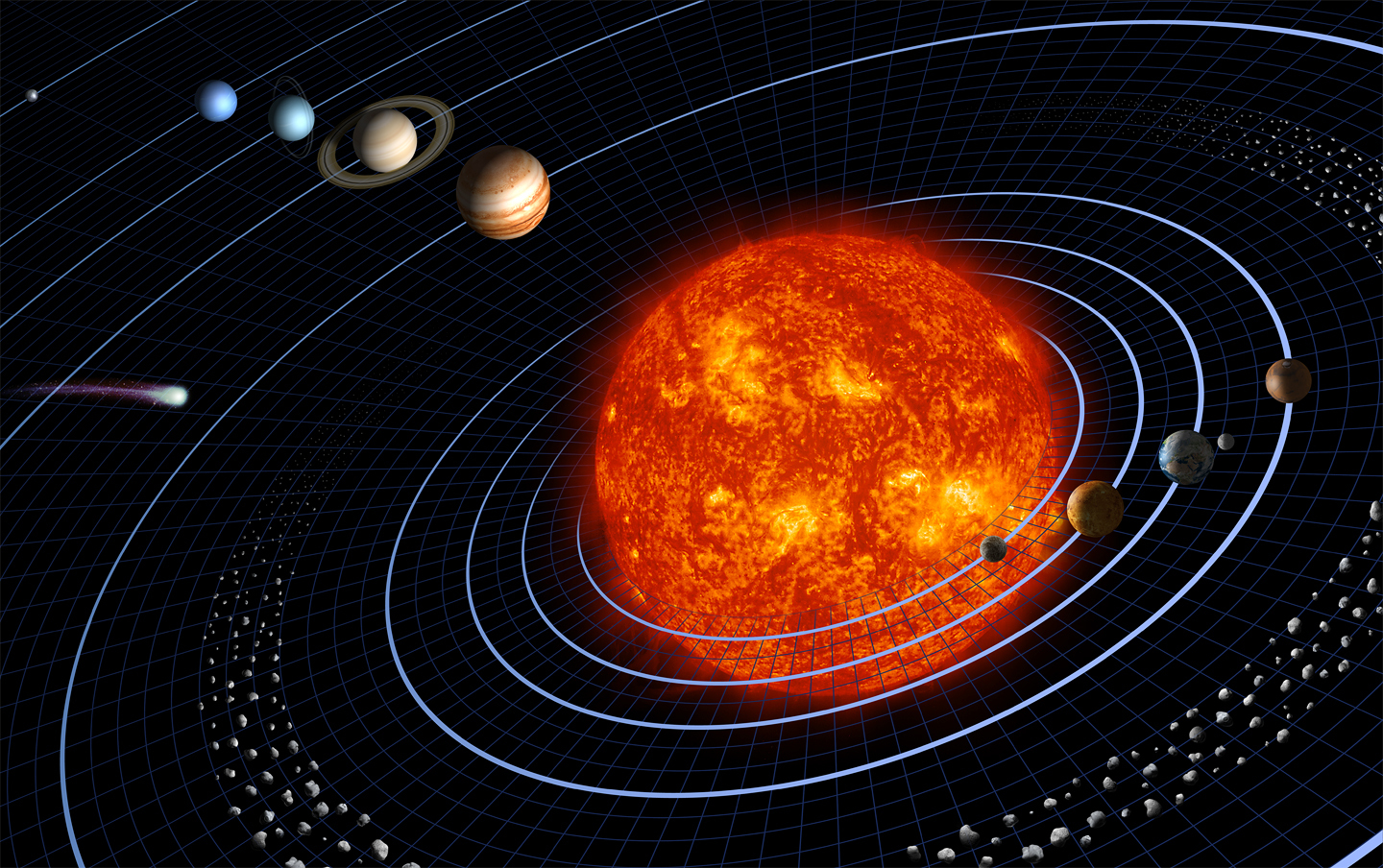
The 5 hours it takes light to travel across our Solar System may seem like a short period to cross such a large distance, but we have to think about scale. While distances within the Solar System are large to us, they are dwarfed by the distances between the stars. Considering larger regions of the Milky Way, a natural distance unit is the distance light travels in one year. This is called a light year. We can easily calculate the size of this unit by remembering that distance has the units of velocity times time. So:
D ly = vt = c x 1 year = 3 × 10 5 x (3600 × 24 × 365) = 9.5 × 10 12 km

A light year is the typical distance between stars in the neighborhood of the Sun. It is nearly 10 trillion kilometers or 6 trillion miles! The fundamental unit of distance defined by geometry is the 13 km; defined as the distance corresponding to a parallax of 1 second of arc.">parsec , equal to 3.1 × 10 13 km. This is described in more detail in the article on parallax . Geometrically, one parsec is the height of a right triangle with an angle of 1 arcsec describing its apex , and a distance of 1 AU describing its base. The units are related by a small numerical constant D ly = 3.26 D pc . So to roughly convert from parsecs to light years, multiply by 3.3.
The following list gives the distance to various points within the Milky Way and beyond, both in terms of parsecs and the light travel time in years (which is also the distance in light years or 3.3 times the distance in parsecs). To fully appreciate how isolated we are in space, remember that light is the fastest thing we know of. The fastest spacecraft can not reach 1% of the speed of light. So you would have to multiply the numbers on the right-hand side of the table by at least 100 to estimate how long it would take to send a probe through the Milky Way and into the Local Group with current technology.
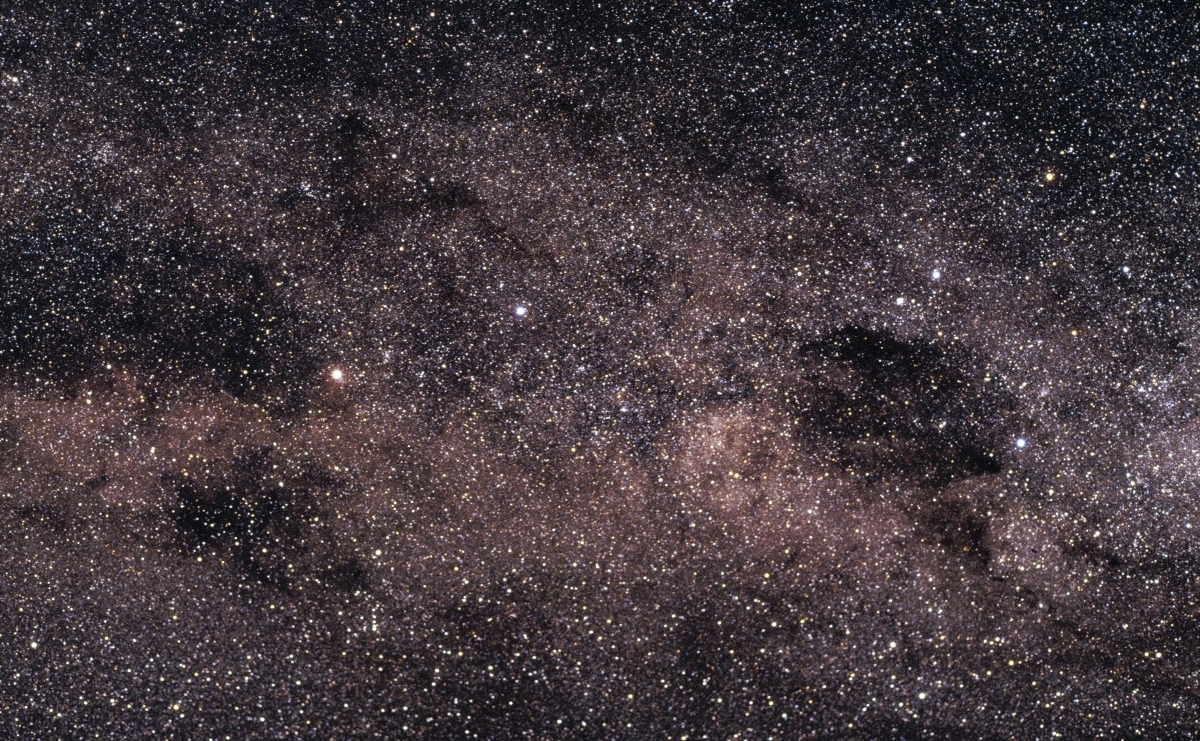
• Nearest star (α Centauri) - 1.3 pc, 4.2 years • Sirius - 2.7 pc, 8.8 years • Vega - 8.1 pc, 26 years • Hyades cluster - 42 pc, 134 years • Pleiades cluster - 125 pc, 411 years • Orion nebula - 460 pc, 1500 years • Nearest spiral arm - 1200 pc, 3900 years • Center of the 8 to 10 13 solar masses.">galaxy - 8500 pc, 29,000 years • Far edge of the galaxy - 24,000 pc, 78,000 years • Large Magellanic Cloud - 50,000 pc, 163,000 years • Andromeda galaxy (M31) - 670,000 pc, 2.2 million years
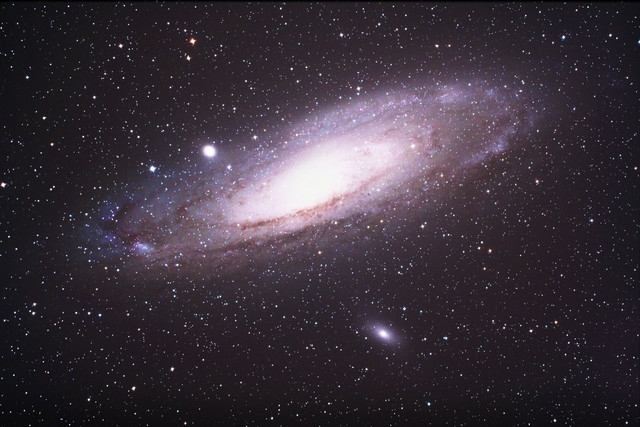
What does Andromeda look like now? Nobody knows. Since nothing travels faster than light (and this applies to all the colors of light across the electromagnetic spectrum ), there is no quicker way to send information from one place to another. We are stuck with collecting and measuring "old" light. While this seems like a limitation, scientists actually find that it turns out that light travel time is a wonderful tool. By looking further out in space we look further back in time. In this way, astronomers get to explore the earlier stages of the universe seeing firsthand (with a delay) what the early universe looked like.

Time Travel: Observing Cosmic History
By observing light from faraway cosmic objects, the Hubble Space Telescope is like a time machine. Light takes time to reach Hubble, because it travels great distances. That means images captured by Hubble today, show what the objects looked like years ago!

The Hubble Space Telescope is many things. It’s an observatory, a satellite, and an icon of cultural and scientific significance – but perhaps most interestingly, Hubble is also a time machine.
Hubble isn’t that far away, locked in a low-Earth orbit just a few hundred miles up that takes about 90 minutes to complete. But with its position just above Earth’s murky atmosphere, Hubble’s transformative view of our universe literally lets us witness our universe’s past. It allows us to effectively travel back in time.
How does that work? After all, Hubble doesn’t travel beyond our solar system, or even our home planet’s gravity. It certainly doesn’t have any sci-fi elements you might find in Doctor Who or Back to the Future.
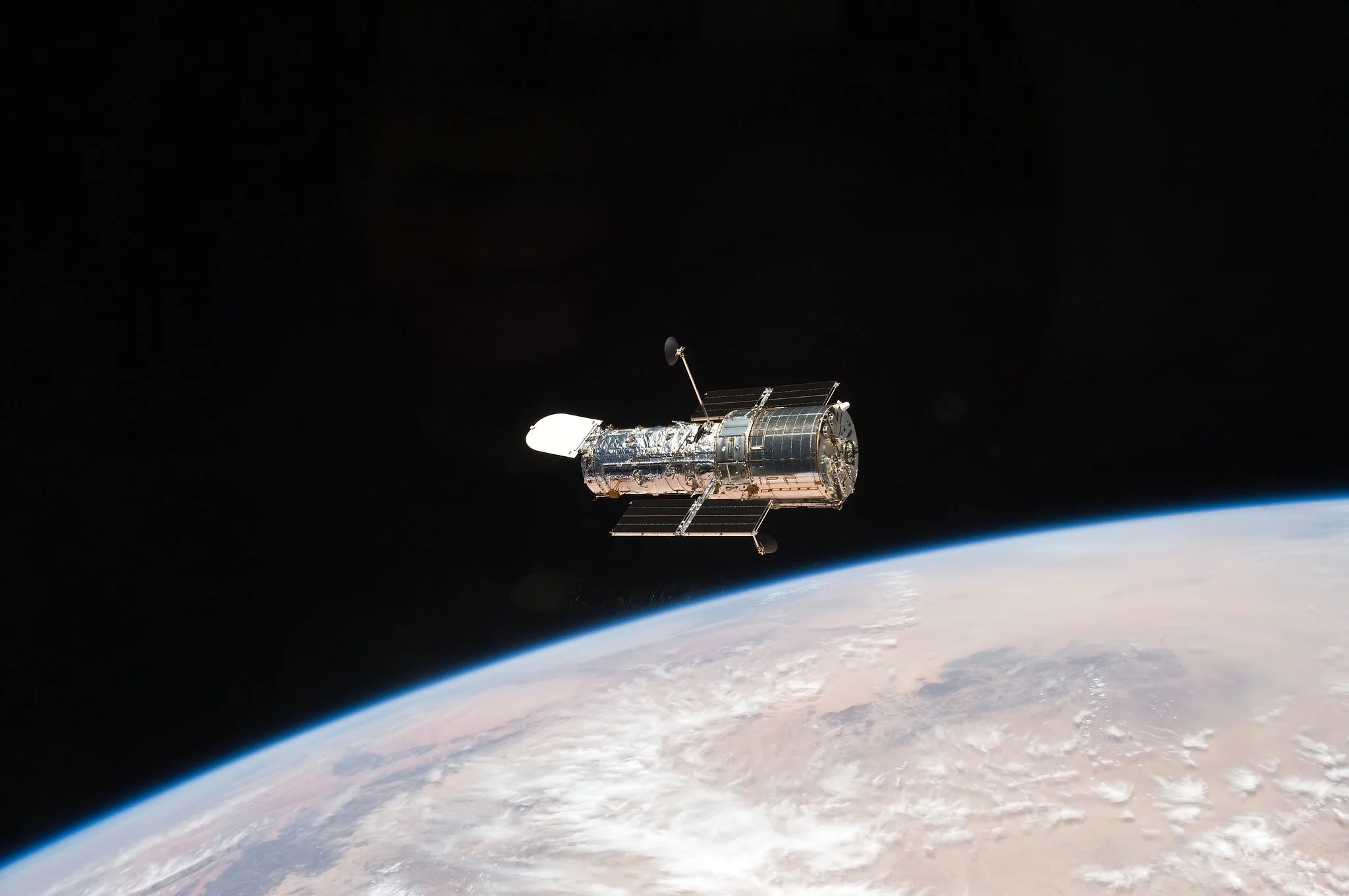
Light Travel
The answer is simply light.
The term “light-year” shows up a lot in astronomy. This is a measure of distance that means exactly what it says – the distance that light travels in one year. Given that the speed of light is 186,000 miles (299,000 kilometers) per second, light can cover some serious ground over the course of 365 days. To be precise, almost 6 trillion miles (9.5 trillion kilometers)!
Traveling Back in Time: 8 minutes
Hubble works by gathering light from objects in our universe – some as close as our Moon, and some as distant as galaxy clusters that are billions of light-years away. All that light takes time to reach the telescope, just as it takes time for light to travel from its source to our eyes. For example, our Sun is located about 93 million miles (150 million kilometers) from Earth. That means that it takes roughly eight minutes for its light to reach us here on our planet, so when we look at the Sun (though directly is never recommended!) we see it exactly as it was eight minutes in the past.
Cosmically speaking, the 93 million miles between us and the Sun are nothing. We orbit around just one of billions of stars in the Milky Way Galaxy, which is one of countless trillions of galaxies in the universe.
With that in mind, time travel gets more intense when Hubble observes objects beyond our star system.
Traveling Back in Time: 4 years
Aside from our Sun, the next closest star to us is named Proxima Centauri. It’s about four light-years away, which makes it a close neighbor on a universal scale. But even with Hubble’s sharp, powerful vision, Proxima Centauri remains a point-like object – demonstrating our universe’s unfathomably large size.
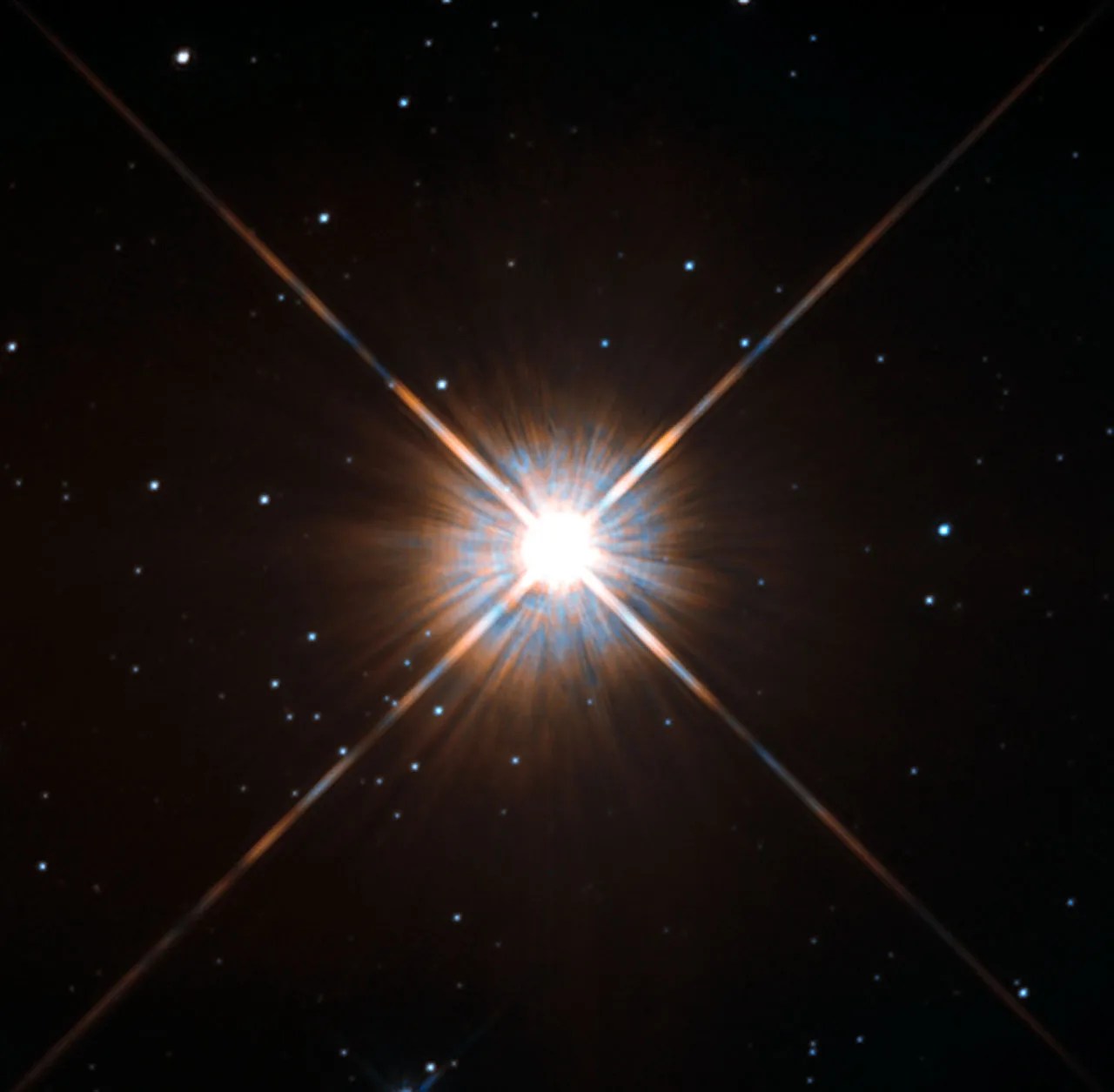
Traveling Back in Time: 700 years
Another stellar target of Hubble’s is named Betelgeuse, which is about 700 light-years from Earth. Again, this means that when Hubble looks at Betelgeuse, the star appears exactly as it was 700 years ago. As one of the brightest stars in our sky, astronomers believe it’s likely that even the earliest humans knew of it, as this star appears in stories from several cultures.
This red supergiant star began to dim significantly in the fall of 2019, losing about 60% of its brightness within months. But by April 2020, its regular brightness returned. Hubble studied Betelgeuse and found out that the star “blew its top” – it went through a surface mass ejection, in which the star spewed out a large amount of its surface material into space. When that material in space cooled down, it became a dust cloud that temporarily blocked some of the star’s light.
Hubble’s unique ability to observe in ultraviolet light helped reveal the details of this dimming event and its aftermath. In this range of light, Hubble can better observe the hot layers of atmosphere above a star’s surface.
The telescope continues to be the go-to observatory for scientists who study Betelgeuse. Because it’s taken this long for the light from Betelgeuse to reach us, only in very recent history have we witnessed a cosmic event unfolding that really occurred about 700 years ago!
Scientists also believe that Betelgeuse is on the verge of going supernova – dying in an explosive event. In fact, it may have already done so, but the light from the explosion still hasn’t reached us. There’s a good chance that Betelgeuse no longer exists, though we can still see it today from Earth.
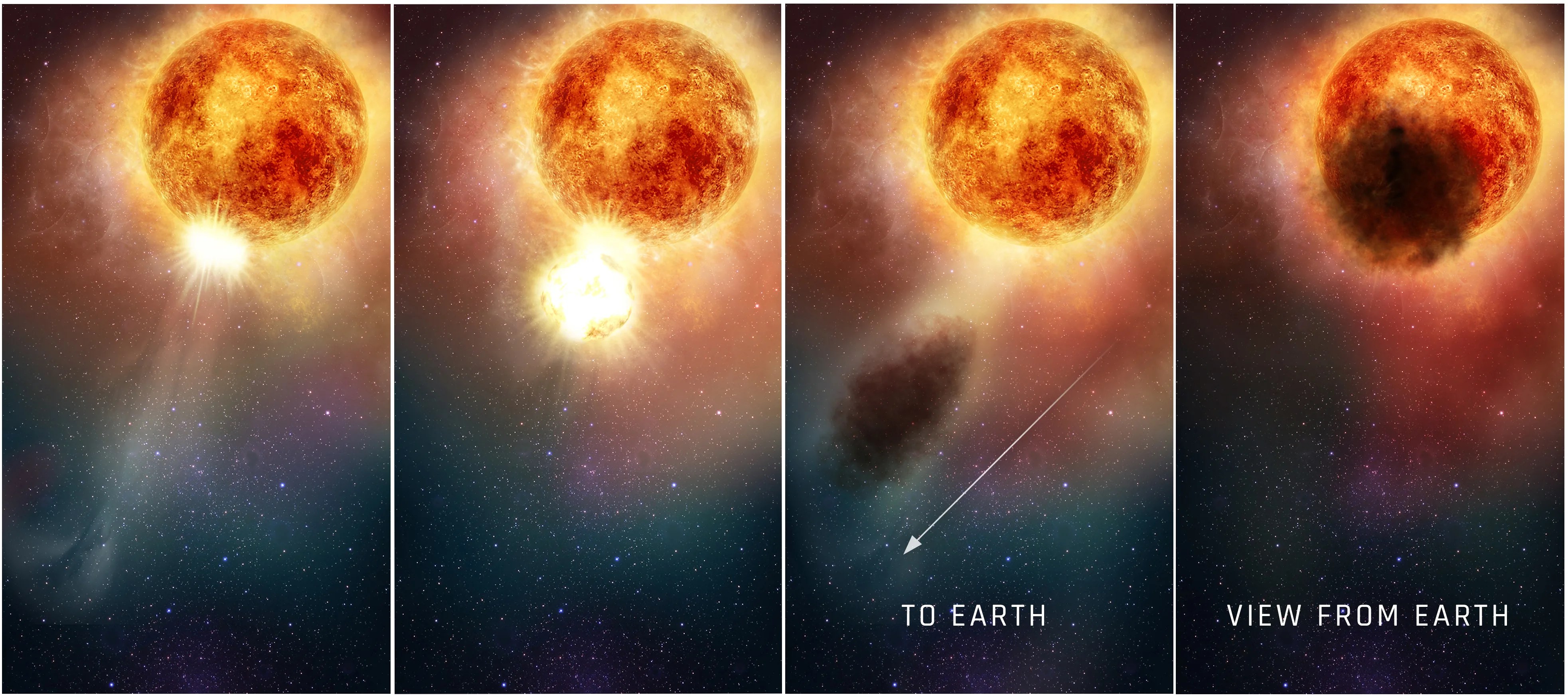
Traveling Back in Time: 6,500 years
Nebulae are clouds of gas and dust where stars are birthed, or the remnants of a dead or dying star itself. These beautiful, ethereal cosmic objects are the subject of some of Hubble’s most iconic images, but they can also teach us more about how our universe behaves and evolves.
For example, a favorite target for Hubble is the Crab Nebula, located about 6,500 light-years away. There are records from 1054 CE written by Chinese astronomers noting the new presence of a shockingly bright “guest” star in the sky, visible even during the daytime. Turns out, they actually saw a supernova – a star’s explosive death – which became the Crab Nebula, made up by the remnants of this violent event. Of course, those Chinese astronomers witnessed a supernova explosion that occurred about 5446 BCE, but it took the light from the explosion 6,500 years to reach Earth in the year 1054.

Traveling Back in Time: 2.5 million years
When Hubble looks beyond our own galaxy, we can watch cosmic history unfold over eons.
The Andromeda Galaxy is a whopping 2.5 million light-years away, but that’s just the closest major galaxy to us here in the Milky Way. Observing Andromeda is like staring into a vision from 2.5 million years ago – back during the Paleolithic period on Earth, when very early humans existed.
And if Andromeda is the closest major galaxy to us, it’s difficult to comprehend just how far the light from the most distant observed galaxies has traveled.

Traveling Back in Time: 12.9 billion years
Another Hubble record is for observing the most distant individual star ever detected, named Earendel. This faraway star emitted its light within the first billion years of the universe, which is about 13.8 billion years old, so it took quite a while to reach Hubble! In fact, that observation was only made possible by nature’s magnifying glass – an astronomical phenomenon known as gravitational lensing. When a massive cosmic object has enough gravity, its gravitational field can magnify and bend light coming from objects located behind it. The gravity of a galaxy cluster located between Hubble and Earendel magnified the star’s light, making it detectable. The type of star that Earendel seems to be typically have brief lives, only surviving about half a billion years. That means Earendel has ceased to exist for over 12 billion years, yet we are able to look back in time and watch Earendel during its short life.
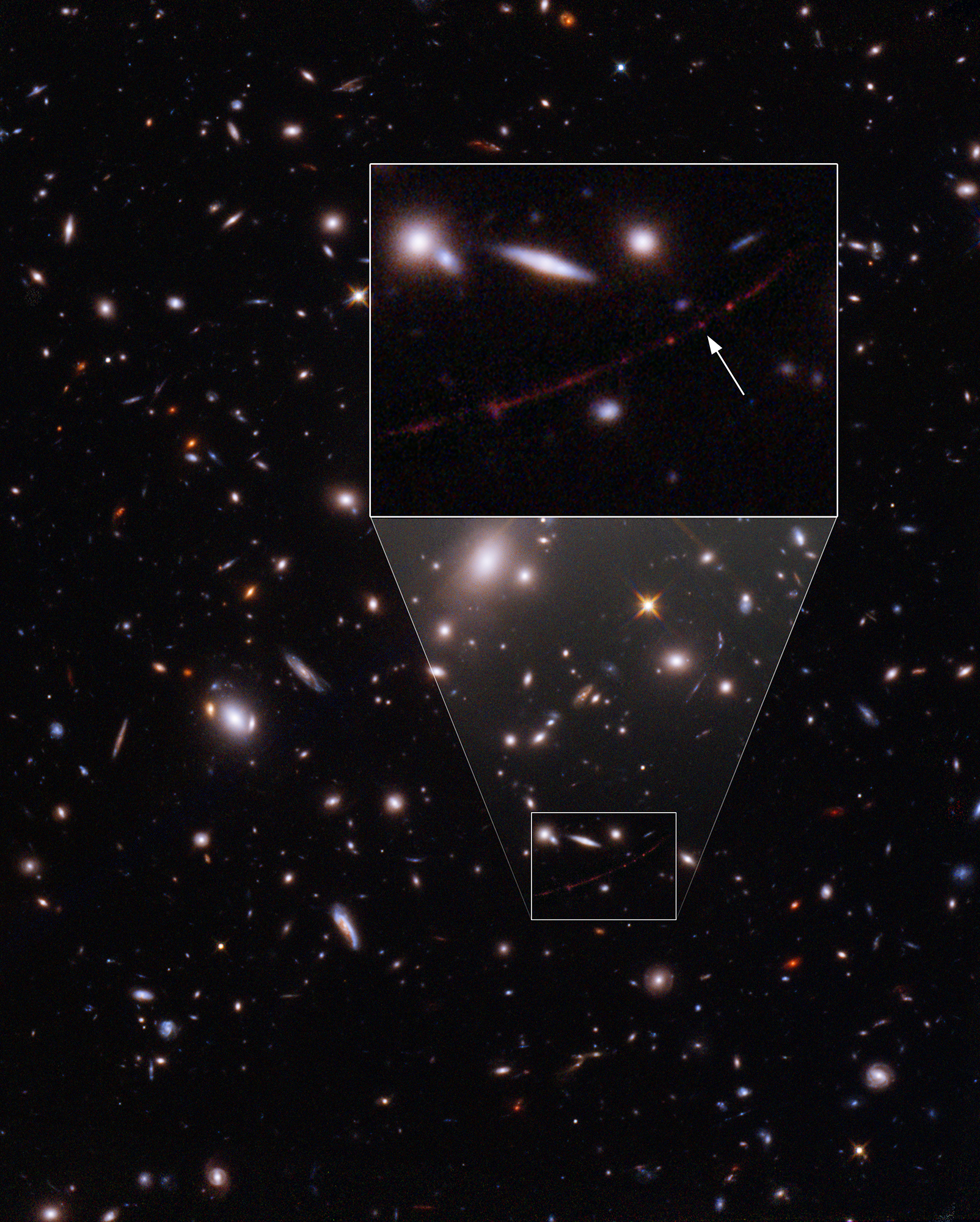
Traveling Back in Time: 13.4 billion years
Perhaps some of Hubble’s most legendary observations are its deep field images, which collect light from thousands of galaxies that are billions of light-years away.
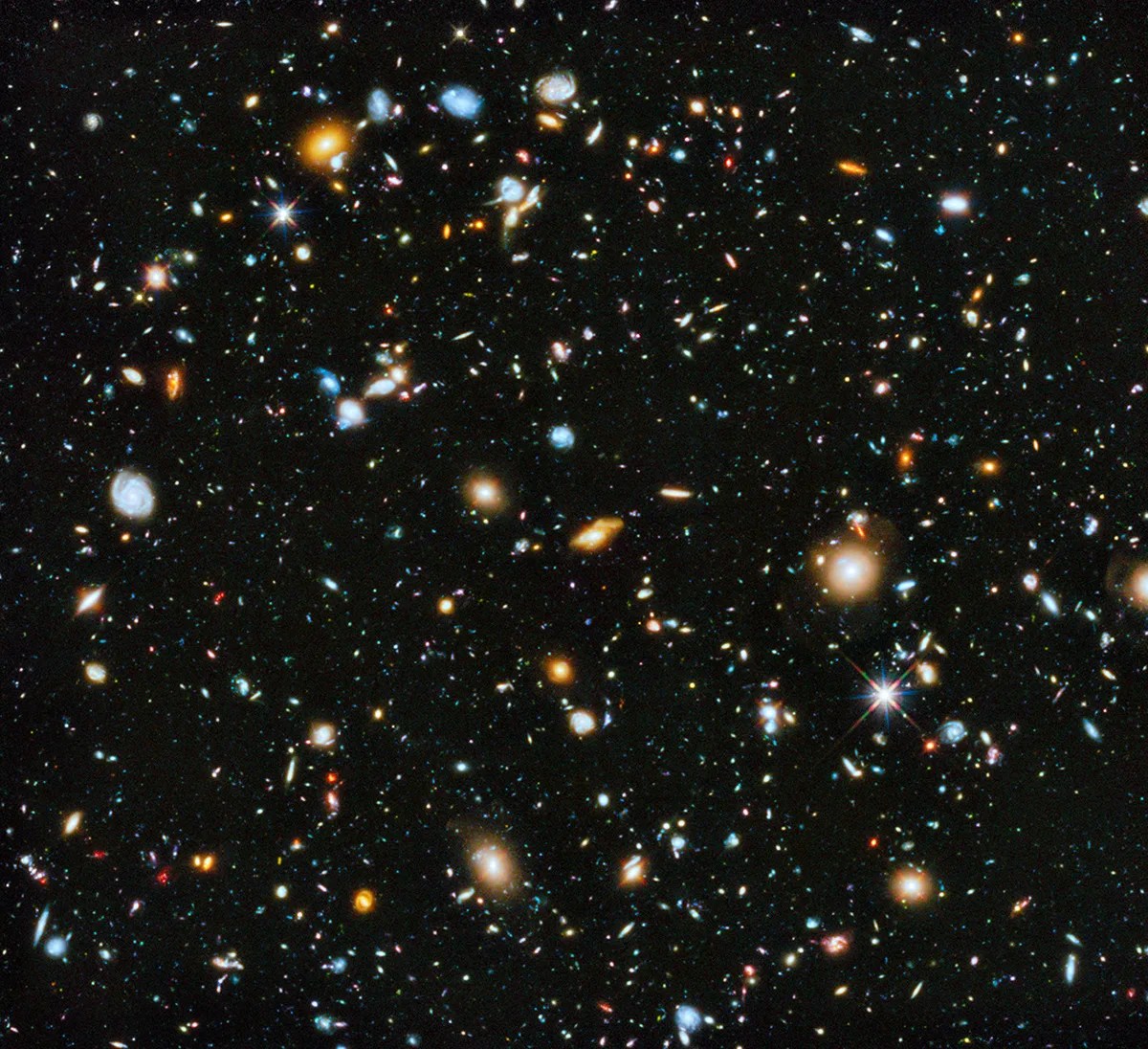
With this type of imagery, we can better understand how our universe changes over time by puzzling out how galaxies evolve. The farther back we look with Hubble, the closer we get to the the big bang, when the universe began – so the most distant galaxies observed by Hubble often appear to us as the “youngest” ones – giving us a sneak peek at the universe in its infancy. Because these galaxies emitted their light when they were young, we get to witness them in their early stages. These early galaxies often appear simpler and smaller than the grandiose spiral galaxies and merged galaxies we see closer to us in distance, and therefore in time. These young galaxies are actually old galaxies now as they have evolved over the time this light has taken to reach us.
Hubble’s farthest observation is of a galaxy named GN-z11, observed as it was 13.4 billion years in the past! This places it within just 400 million years of the big bang itself.
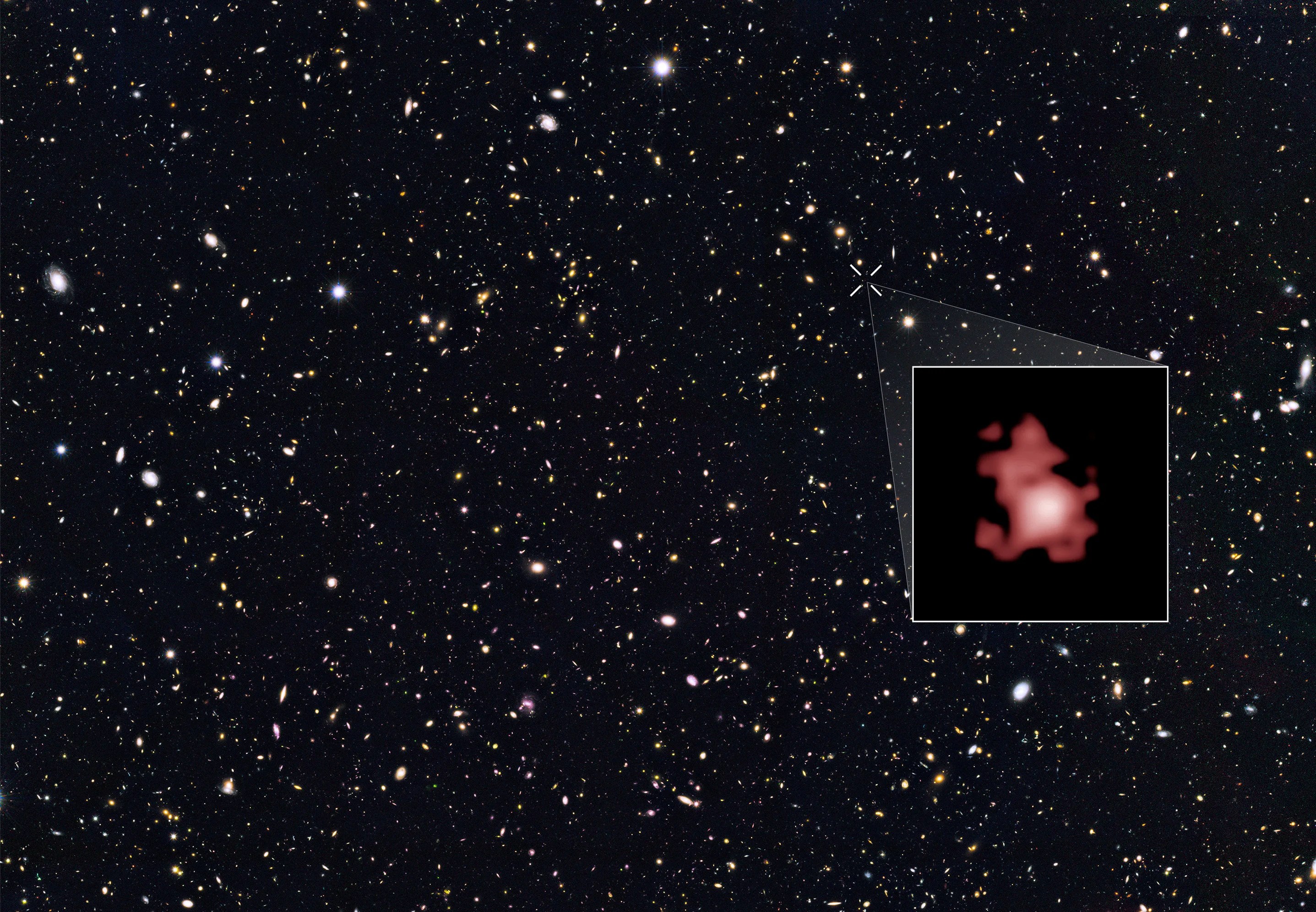
Watching Our Universe Over Time
Observations of the most distant objects, like GN-z11 and Earendel, give astronomers exciting insight into the environment of our early universe. The light we see literally traveled from all the way back then!
Our universe remains mysterious, mind-bendingly large, and ever-expanding, but by gathering light from near and far – from the recent past to the dawn of the universe itself – Hubble helps answer questions about where we are and how the universe works.
At its core, astronomy is really just archaeology. Cosmic objects give off light, letting us learn more about their lives. It can take a long, long time for light to reach Hubble – just one telescope orbiting just one planet in just one solar system in just one galaxy. Scientists use Hubble like the time machine that it is to piece together the history and mystery of the cosmos, giving us all a glimpse right up to the edge of the universe – and time itself.
Explore More Hubble

The Lost Universe
NASA's Hubble Space Telescope has vanished from Earth’s timeline. Only an ambitious crew of adventurers can uncover what was lost. Are you up to the challenge?
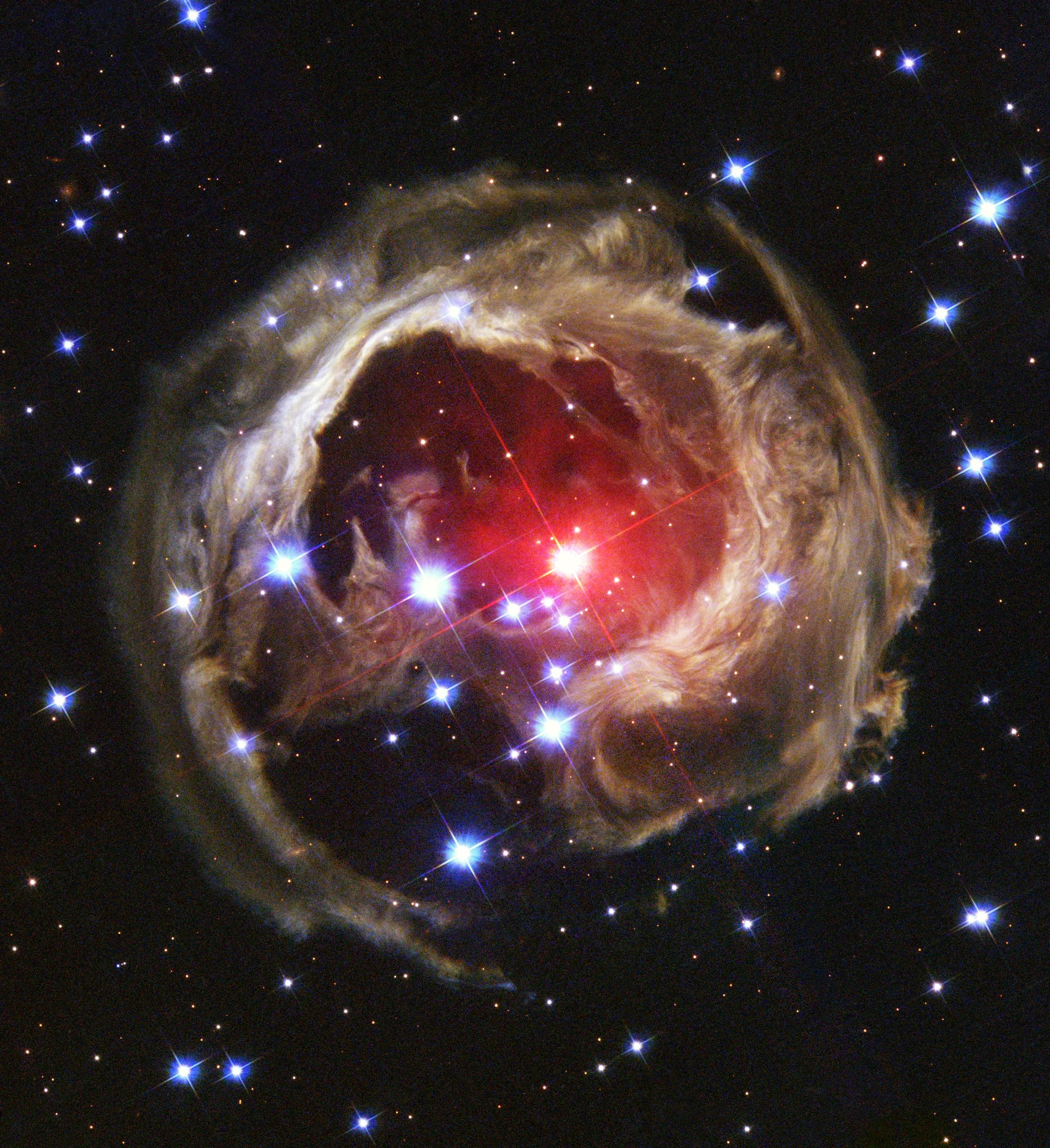

Hubble Science Highlights
Hubble has affected every area of astronomy. Its most notable scientific discoveries reflect the broad range of research and the breakthroughs it has achieved.

Hubble's Cultural Impact
Even if you don't know anything about the Hubble Space Telescope, its pictures have been a part of your life.
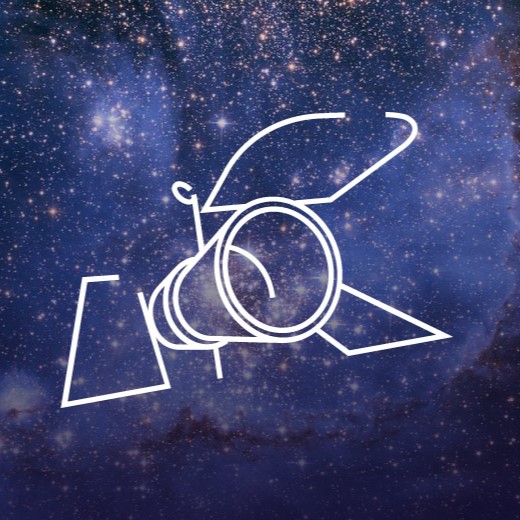
What is Hubble Observing?
See the area of sky Hubble is currently investigating or explore its upcoming and past targets.
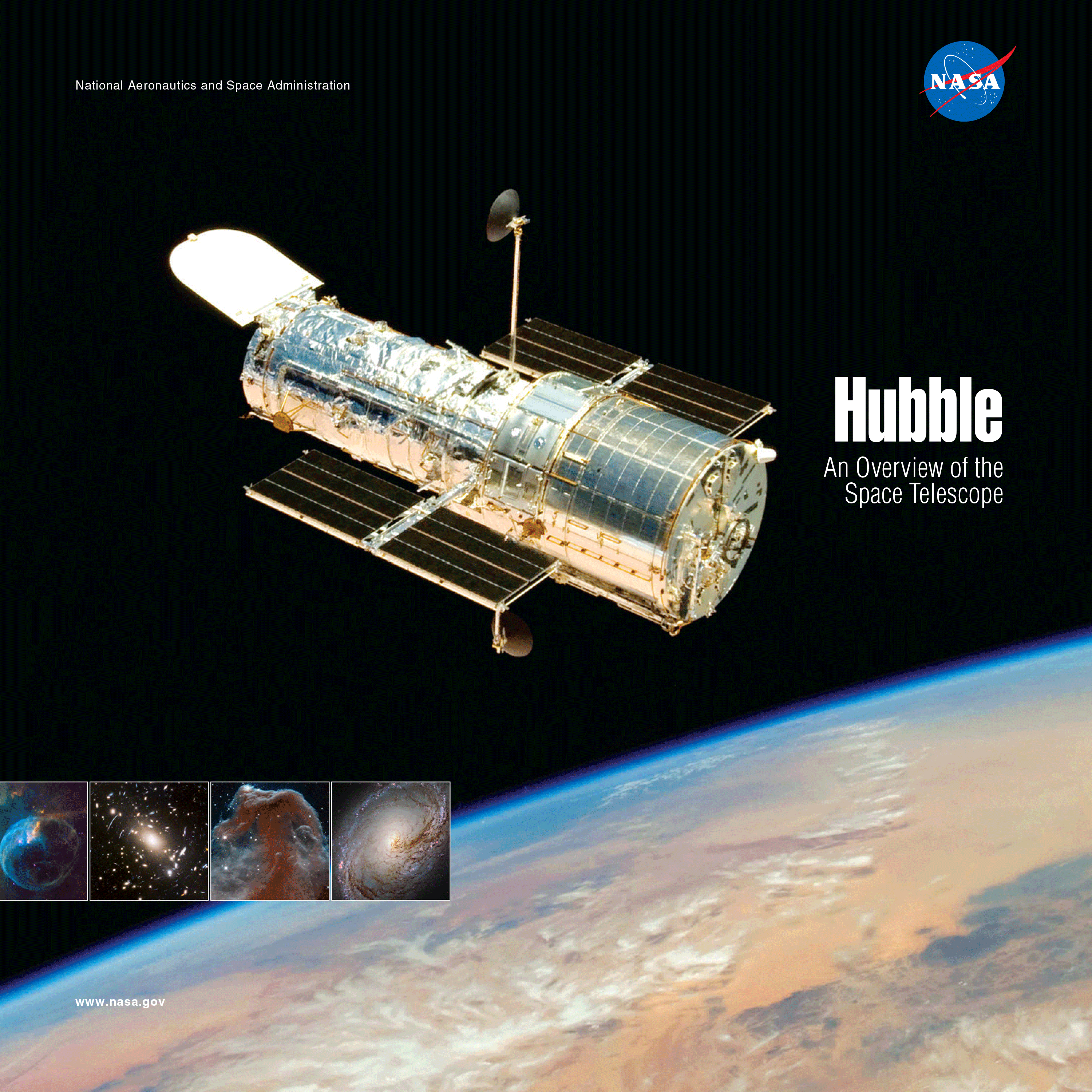
Hubble E-books
Investigate the mysteries of the universe with Hubble. Learn Hubble's history and dive deeper into its discoveries by downloading our e-books.
share this!
February 24, 2016
NASA thinks there's a way to get to Mars in three days
by Evan Gough, Universe Today
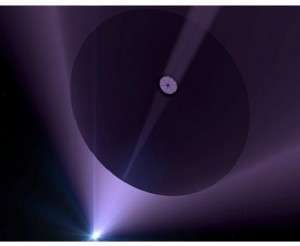
We've achieved amazing things by using chemical rockets to place satellites in orbit, land people on the moon, and place rovers on the surface of Mars. We've even used ion drives to reach destinations further afield in our solar system. But reaching other stars, or reducing our travel time to Mars or other planets, will require another method of travel. One that can approach relativistic speeds.
We can execute missions to Mars, but it takes several months for a vehicle to reach the Red Planet. Even then, those missions have to be launched during the most optimal launch windows, which only occur every 2 years. But the minds at NASA never stop thinking about this problem, and now Dr. Philip Lubin, Physics Professor at the University of California, Santa Barbara, may have come up with something: photonic propulsion, which he thinks could reduce the travel time from Earth to Mars to just 3 days, for a 100 kg craft.
The system is called DEEP IN, or Directed Propulsion for Interstellar Exploration. The general idea is that we have achieved relativistic speeds in the laboratory, but haven't taken that technology—which is electromagnetic in nature, rather than chemical—and used it outside of the laboratory. In short, we can propel individual particles to near light speed inside particle accelerators, but haven't expanded that technology to the macro level.
Directed Energy Propulsion differs from rocket technology in a fundamental way: the propulsion system stays at home, and the craft doesn't carry any fuel or propellant. Instead, the craft would carry a system of reflectors, which would be struck with an aimed stream of photons, propelling the craft forward. And the whole system is modular and scalable.
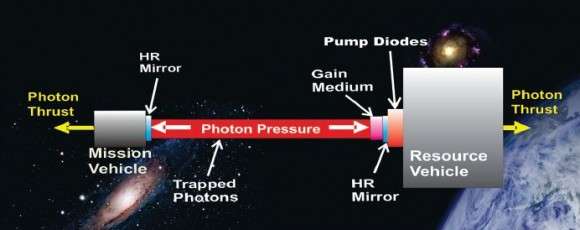
If that's not tantalizing enough, the system can also be used to deflect hazardous space debris, and to detect other technological civilizations. As talked about in this paper , detecting these types of systems in use by other civilizations may be our best hope for discovering those civilizations.
There's a roadmap for using this system, and it starts small. At first, DEEP IN would be used to launch small cube satellites. The feedback from this phase would then inform the next step, which would be to test a unit for defending the ISS from space debris . From then, the systems would meet goals of increasing complexity, from launching satellites to LEO (Low-Earth Orbit) and GEO (Geostationary Orbit), all the way up to asteroid deflection and planetary defense. After that, relativistic drives capable of interstellar travel is the goal.
There are lots of questions still to be answered of course, like what happens when a vehicle at near light-speed hits a tiny meteorite. But those questions will be asked and answered as the system is developed and its capabilities grow.
Obviously, DEEP IN has the potential to bring other stars into reach. This system could deliver probes to some of the more promising exo-planets, and give humanity its first detailed look at other solar systems. If DEEP IN can be successfully scaled up, as Lubin says, then it will be a transformational technology.
Source: Universe Today
Explore further
Feedback to editors

Global study shows a third more insects come out after dark
17 hours ago

Cicada-palooza! Billions of bugs to blanket America
19 hours ago

Getting dynamic information from static snapshots
20 hours ago

Ancient Maya blessed their ballcourts: Researchers find evidence of ceremonial offerings in Mexico

Optical barcodes expand range of high-resolution sensor
Apr 26, 2024

Ridesourcing platforms thrive on socio-economic inequality, say researchers

Did Vesuvius bury the home of the first Roman emperor?

Florida dolphin found with highly pathogenic avian flu: Report

A new way to study and help prevent landslides

New algorithm cuts through 'noisy' data to better predict tipping points
Relevant physicsforums posts, black holes colliding exactly head on.
28 minutes ago
Need help simplifying standard error formula for redshift
Our beautiful universe - photos and videos.
Apr 25, 2024
Solar Activity and Space Weather Update thread
'devil' comet visible tonight 21.04.24, waves in space.
More from Astronomy and Astrophysics
Related Stories

Team to investigate possibility of using directed energy propulsion for interstellar travel
Jun 23, 2015

Alpha Centauri—our first target for interstellar probes?
Feb 22, 2016

The feasibility of deflecting asteroids
Sep 1, 2015

Ion propulsion—the key to deep space exploration
Nov 4, 2015
NASA seeks proposals to develop capabilities for deep space exploration, journey to Mars
Oct 29, 2014

CubeSats in deep space
Nov 3, 2015
Recommended for you

Japan's moon lander wasn't built to survive a weekslong lunar night. It's still going after 3
Apr 24, 2024

NASA's Voyager 1 resumes sending engineering updates to Earth
Apr 22, 2024

Simulated microgravity affects sleep and physiological rhythms, study finds

'Tube map' around planets and moons made possible by knot theory
Apr 17, 2024

NASA's Ingenuity Mars helicopter team says goodbye—for now

NASA confirms mystery object that crashed through roof of Florida home came from space station
Apr 16, 2024
Let us know if there is a problem with our content
Use this form if you have come across a typo, inaccuracy or would like to send an edit request for the content on this page. For general inquiries, please use our contact form . For general feedback, use the public comments section below (please adhere to guidelines ).
Please select the most appropriate category to facilitate processing of your request
Thank you for taking time to provide your feedback to the editors.
Your feedback is important to us. However, we do not guarantee individual replies due to the high volume of messages.
E-mail the story
Your email address is used only to let the recipient know who sent the email. Neither your address nor the recipient's address will be used for any other purpose. The information you enter will appear in your e-mail message and is not retained by Phys.org in any form.
Newsletter sign up
Get weekly and/or daily updates delivered to your inbox. You can unsubscribe at any time and we'll never share your details to third parties.
More information Privacy policy
Donate and enjoy an ad-free experience
We keep our content available to everyone. Consider supporting Science X's mission by getting a premium account.
E-mail newsletter

- How Long Would It Take To Travel To Each Planet?
Our solar system is home to eight individual planets . Moving outwards from the sun , they are Mercury, Venus, Earth, Mars, Jupiter, Saturn, Uranus, and Neptune. Some of these worlds are far closer than others, and the time it would take to travel to each planet is different for every one of them. Just how long would it take to travel to each planet?
Mercury and Venus
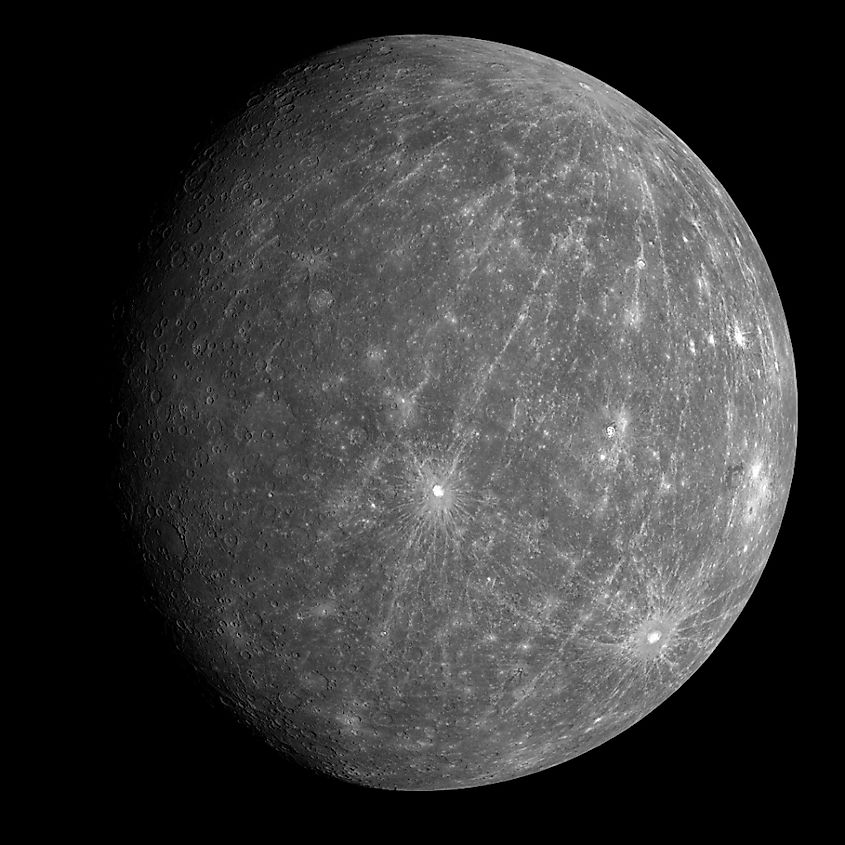
How long it would take to travel to the planets is dependent upon a number of factors, such as the route you take, the spacecraft you use, and where the planets are located in their respective orbits . To simplify things, we will assume that the route you take is a direct one and that the planets are at their closest approach to one another. Furthermore, we will assume that any spacecraft we use to travel to the planets is as fast as the New Horizons spacecraft, which happens to be one of the fastest human-made objects ever built. At its fastest, New Horizons reached a speed of about 50,000-miles per hour (80,000-kilometres per hour). Since Mercury and Venus are the closest planets to Earth , the time it would take to travel to them will be the shortest. At its closest approach, Mercury is about 48-million miles (77-million kilometres) from Earth. To calculate time, we simply divide distance by velocity, so in this case we divide 48-million miles by 50,000-miles per hour, giving us 960-hours of travel time. Divide this by 24-hours, and we get the number of days it would take to get to Mercury, which ends up being 40-days. When Venus is at its closest approach to Earth, it is about 38-million miles (61-million kilometres) away, and so it would take about 32-days to get to Venus.
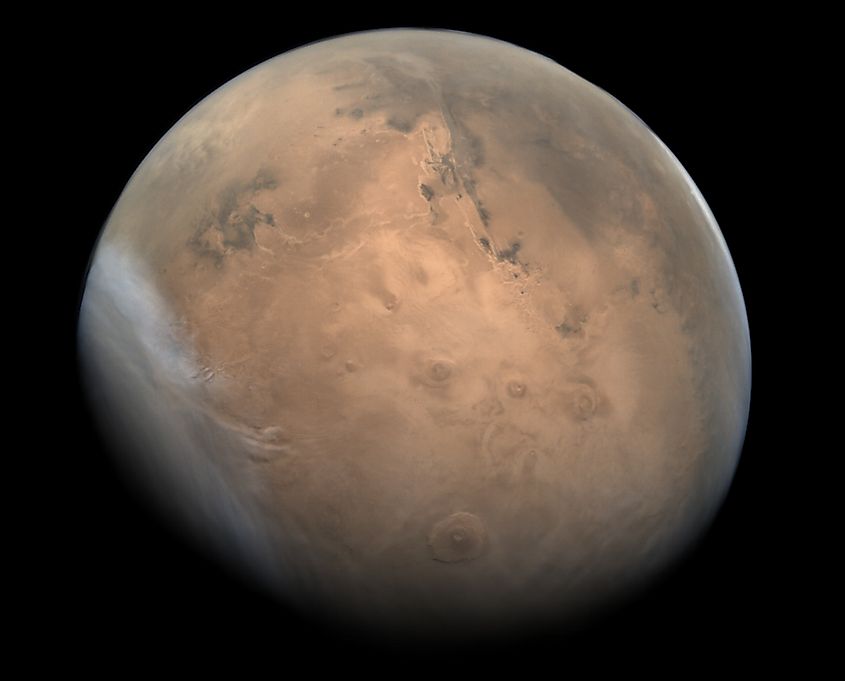
Mars is the most frequently visited planet in our solar system. While humans have yet to land on the Martian surface, space agencies have sent a number of rovers , landers, and satellites to study the Red Planet. During its closest approach, Mars is about 51-million miles (82-million kilometres) away from Earth. Moving at a speed of 50,000-miles per hour, it would take you about 42.5-days to reach Mars.
Jupiter and Saturn
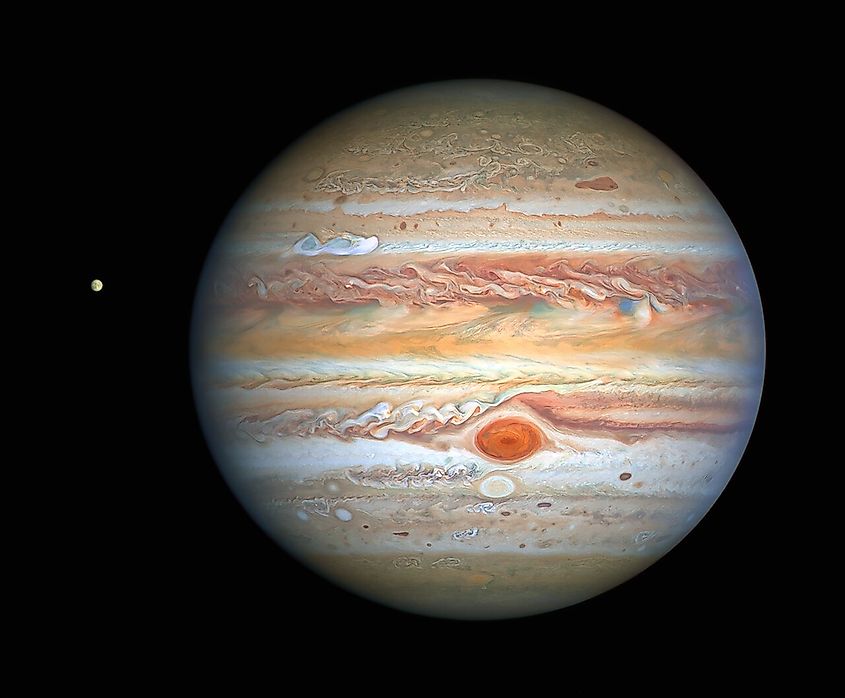
Beyond the orbit of Mars is the realm of the gas giants . Beyond Mars, the gas giants are much further away than their rocky counterparts. Jupiter is the closest gas giant to Earth, yet even at its closest approach it is still 367-million miles (590-million kilometres) away from our world. At this distance and moving at a speed of 50,000-miles per hour, it would take you 306-days to reach Jupiter. Saturn , meanwhile, is much further away than even Jupiter. At its closest approach to Earth, Saturn is 746-million miles (1.2-billion kilometres) away. At this distance, it would take you 622-days or 1.7-years to reach Saturn.
Uranus and Neptune
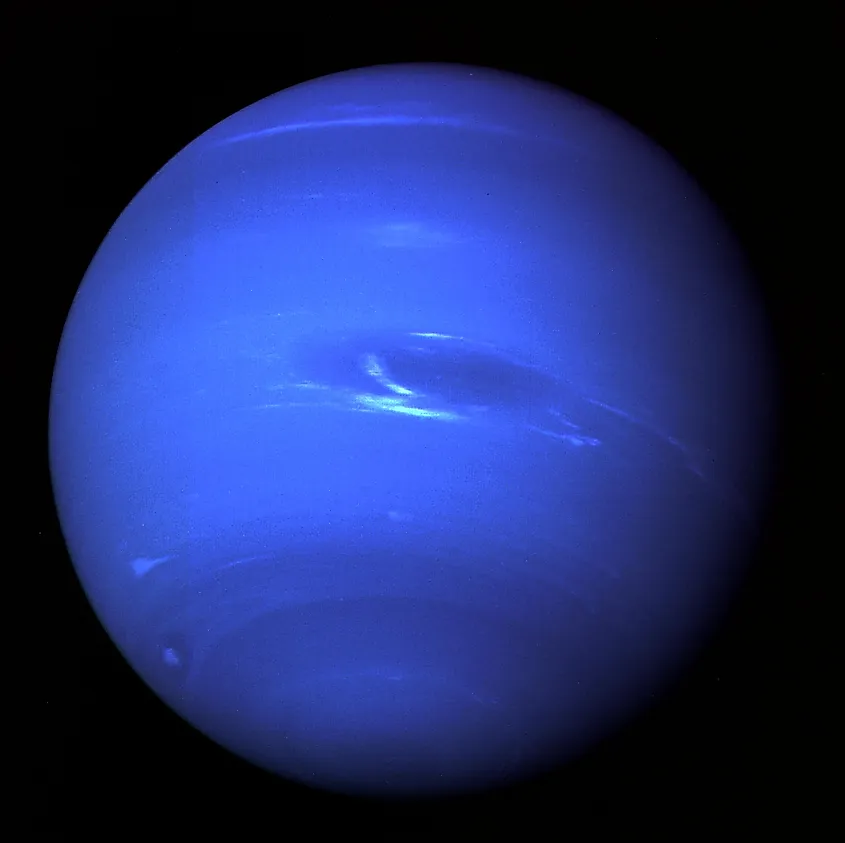
Beyond Jupiter and Saturn are the two outermost planets of our solar system, Uranus and Neptune . These two worlds are so far away from us that they are the only two planets not visible to the naked eye. At its closest approach to the Earth, Uranus is located a staggering 1.7-billion miles (2.7-billion kilometres) away. Travelling in a spacecraft moving at 50,000-miles per hour, it would take you 1,416-days or 3.88-years to reach Uranus. When Neptune is at its closest approach, the distance between Earth and Neptune is 2.7-billion miles (4.3-billion kilometres), and so it would take 2,250-days or 6.16-years.
Planetary Travel Time
More in science.

Where Do Most Earthquakes Occur In The US?
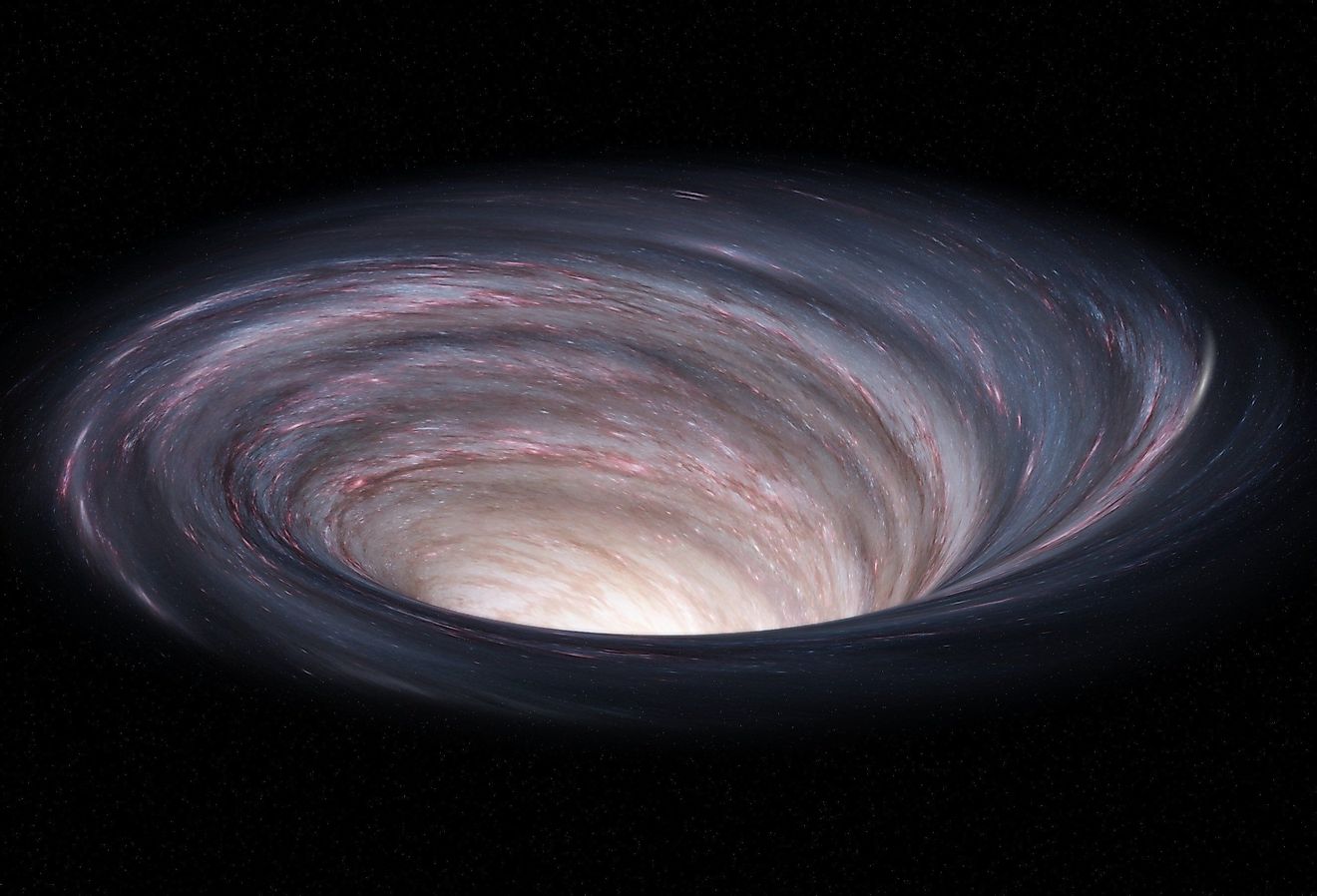
Black Holes Might be Defects in Space and Time

How Are Earthquakes Measured Using The Richter Scale?

How Many New Species Are Discovered Every Year?

Where Does The Sun Rise And Set?
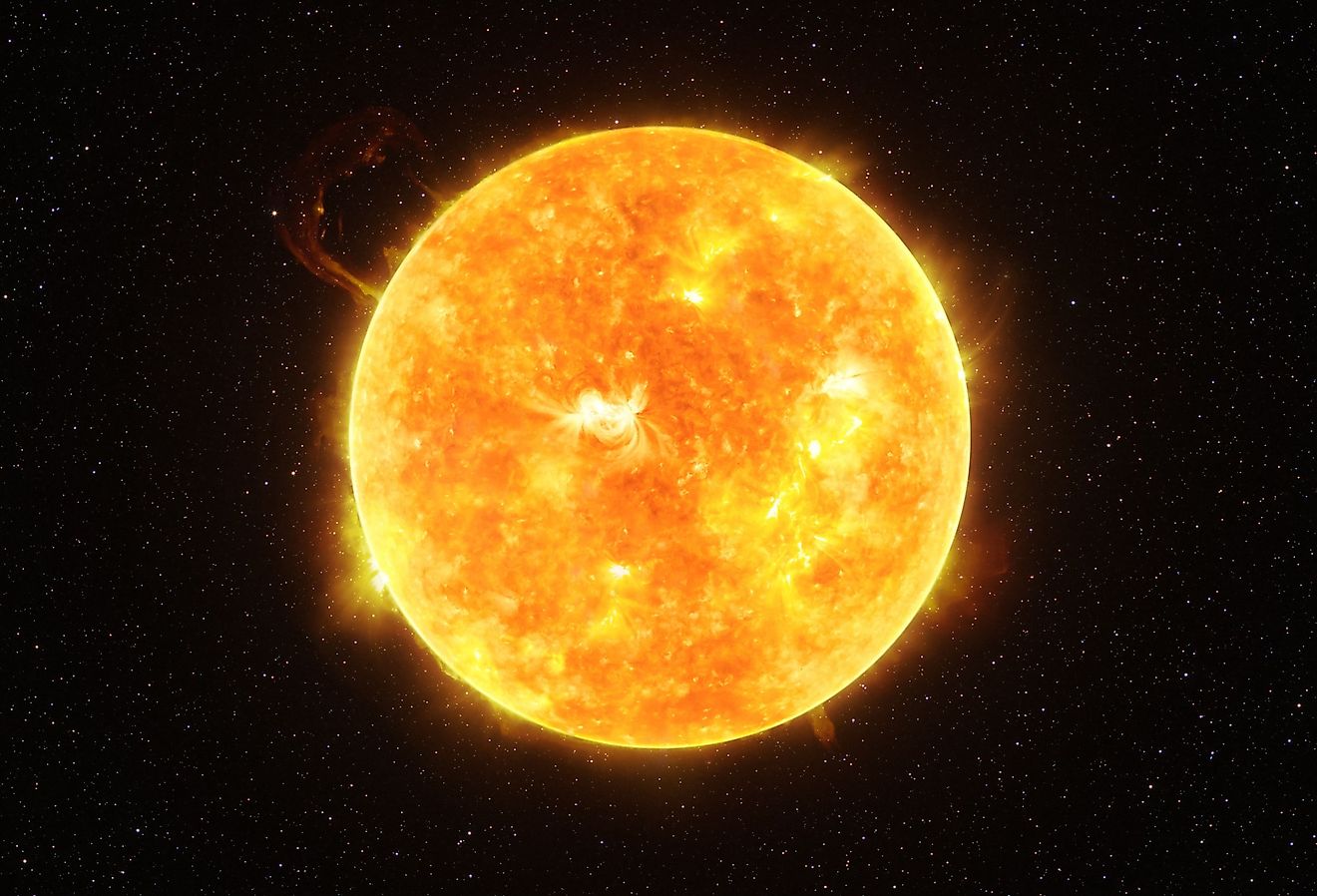
How Hot Is The Sun?

How Many Planets Are In The Milky Way?
Switch to the dark mode that's kinder on your eyes at night time.
Switch to the light mode that's kinder on your eyes at day time.
Measuring Cosmic Distances: Mars in Light Years
by Alexander August 15, 2023, 9:29 am 1.5k Views
Ever gazed at the night sky and spotted the Red Planet, Mars, twinkling back at you? It’s a sight to behold indeed. But how close is this neighboring planet? One frequently asked question is how many light years away is Mars? This article aims to shed light on this intriguing subject.
Light Years: A Measure of Cosmic Distances
To comprehend the distance to Mars, we need to understand the concept of light years. A light year is a measure of distance that depicts how far light can travel in an entire year. It’s a standard unit used by astronomers to measure astronomical distances on a grand scale.
Defining a Light Year
Simply put, a light year is the distance that light can travel in one year. With light speeding through the vacuum of space at approximately 186,282 miles per second, in a year, it can cover nearly 5.88 trillion miles. In metric units, it’s roughly 9.5×10^12 kilometers.
Mars: The Red Planet
Mars, the fourth planet in our solar system, is often referred to as the “Red Planet” due to its reddish appearance. This rocky planet, about half the size of Earth, has a day duration of 24.6 hours. Mars is also known for its two small moons, Phobos and Deimos.
Mars’ Distance from Earth
The distance between Earth and Mars is not fixed. It changes as both Earth and Mars orbit the Sun, following elliptical (oval-shaped) paths. At its closest, Mars can be about 34.8 million miles (approximately 56 million kilometers) away from Earth. At its farthest, it could be as distant as 250 million miles (about 400 million kilometers).
Calculating the Light Years to Mars
To calculate the distance between Earth and Mars in light years, we need to consider the average distance between the two planets and the speed of light. On average, Mars is about 140 million miles away from Earth.
Given the speed of light is about 186,282 miles per second, we can calculate the time it takes for light to travel from Mars to Earth. The average light travel time from Mars to Earth is about 12.5 minutes. Hence, the distance between Earth and Mars in light years is approximately 0.00000236.
Importance of the Distance to Mars
Understanding the distance between Earth and Mars is not just an interesting fact. It’s also a crucial piece of information for space exploration. Space agencies like NASA use this knowledge to plan missions to Mars and calculate travel times for spacecraft.
For instance, if we assume a spacecraft traveling at an average speed of 60,000 miles per hour, it would take about 233 days to journey from Earth to Mars. However, the actual travel time can vary depending on the launch window, the period when the distance between the two planets is the shortest.
Understanding this distance also aids in studying the properties of Mars and its potential for supporting life. It is vital for planning and executing space missions, such as NASA’s Mars Perseverance Rover, which is currently exploring the planet’s surface and collecting data on its geology, climate, and potential for habitability.
How is the Distance to Mars Measured?
Astronomers and scientists use several techniques to measure the distance between Earth and Mars. These include radar ranging, astrometry, and occultation.
Radar Ranging
Radar ranging involves sending a signal to Mars and timing how long it takes for the signal to bounce back to Earth. This method is highly accurate and is often used for studying other planets within our solar system.
Astrometry involves observing the position of Mars relative to the background stars and measuring its apparent shift in position over time. This method is often used for studying more distant objects in the universe.
Occultation
Occultation involves observing the passage of Mars in front of a background star and measuring the timing and duration of the occultation from different locations on Earth. This method can provide accurate measurements of the planet’s distance and other properties.
Wrapping Up
In conclusion, when we ask how many light years away is Mars , we find that the answer isn’t a straightforward, fixed value. Due to the elliptical orbits of both Earth and Mars, the distance between them varies. On average, the light from Mars takes about 12.5 minutes to reach Earth. Hence, the distance between Earth and Mars in light years is about 0.00000236.
The distance to Mars has significant implications for space exploration and our understanding of the solar system. It influences the planning and execution of space missions, the study of Mars and its potential for life, and our comprehension of the dynamics of the solar system.
Frequently Asked Questions
1. what is a light year.
A light year is a unit of measurement used in astronomy to describe the distance that light travels in one year. It is equivalent to about 5.88 trillion miles (9.46 trillion kilometers).
2. How far is Mars from Earth in light years?
Mars is approximately 0.00000236 light years away from Earth. This means that it takes about 12.5 minutes for light to travel from Mars to Earth.
3. How far is Mars from the sun in light years?
Mars is approximately 0.0000003 light years (or about 3 light minutes) away from the sun. This means that it takes about 3 minutes for light to travel from the sun to Mars.
4. How does the distance between Mars and Earth vary over time?
The distance between Mars and Earth varies depending on their positions in their respective orbits around the sun. When they are at their closest approach, Mars can be about 34 million miles (55 million kilometers) away from Earth. At their farthest distance, Mars can be about 250 million miles (400 million kilometers) away from Earth.
5. How long would it take to travel to Mars in a spacecraft?
The time it takes to travel to Mars in a spacecraft can vary depending on the specific mission and approach used. On average, it might take anywhere from 6-8 months to travel from Earth to Mars.
6. Why is the distance between Mars and Earth important?
The distance between Mars and Earth is important for many reasons. It is crucial for planning and executing space missions, studying the properties of Mars and its potential for supporting life, and understanding the dynamics of the solar system.
Written by Alexander
© 2024 Gazetteday
Best time for humans to travel to Mars is when the sun is roaring, scientists say
Maybe book your SpaceX Starship ticket for 2030 to avoid some of the worst space radiation.

Clouds and ice caps on the red planet.
Humanity is set on the idea of visiting Mars in person, but there's the pesky problem of hazardous radiation during long-duration spaceflights to get there. Scientists have raised concerns about brain damage , gastrointestinal issues and cancer on a journey to the red planet. All in all, it sounds pretty off-putting, but it's not impossible to pull off.
A new study has some suggestions for dealing with the safety issues, and it could partly come down to strategically picking the best time to travel.
"This study shows that while space radiation imposes strict limitations and presents technological difficulties for the human mission to Mars, such a mission is still viable," says the paper published this month in the journal Space Weather . It covers simulations that point to the optimal time to travel to Mars.
The paper calls out two main types of hazardous particle radiation: solar energetic particles (SEP) from our sun and galactic cosmic rays (GCR) from outside the solar system. The researchers point to a time known as solar maximum -- when our sun is at its highest activity level -- as an ideal time for humans to head to Mars.
"The scientists' calculations demonstrate that it would be possible to shield a Mars-bound spacecraft from energetic particles from the sun because, during solar maximum, the most dangerous and energetic particles from distant galaxies are deflected by the enhanced solar activity," UCLA said in a statement on Wednesday .
NASA's wildest rides: Extreme vehicles for Earth and beyond
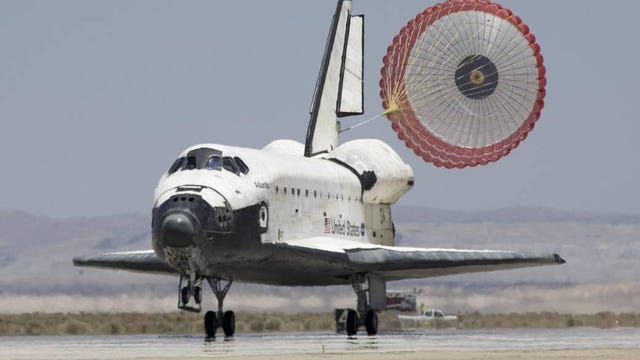
Spacecraft designers would need to focus on shielding astronauts from SEP, but there would be a reduced impact from damaging GCR during solar maximum. The team also recommends keeping a Mars round trip to less than four years in duration, though the study acknowledges this could change based on the development of new shielding materials.
The travel time to Mars can vary (it took NASA's Perseverance mission about seven months to get there), but there are a couple of prime times coming up in the mid-2030s and 2050 when shorter Earth-to-Mars journeys will coincide with periods of solar maximum. Hopefully that will help with your Martian vacation planning.
Follow CNET's 2021 Space Calendar to stay up to date with all the latest space news this year. You can even add it to your own Google Calendar.
- Skip to main content
- Keyboard shortcuts for audio player
Here is the first livestream from Mars — a rare, almost real-time look into space

Juliana Kim
Taking a picture of Mars is not easy.
Once light bounces off the planet, it can take between 3 to 22 minutes to travel to Earth — so there aren't truly "live" images of Mars.
But on Friday afternoon, the European Space Agency offered the closest thing: the first "livestream" of Mars on YouTube , which posted pictures of the planet every 50 seconds as they beamed down directly from the camera mounted on the agency's Mars Express orbiter. The livestream was about an hour long.

In this handout image supplied by the European Space Agency on July 16, 2008, the Echus Chasma, one of the largest water source regions on Mars, is pictured from ESA's Mars Express. ESA/Getty Images hide caption
In this handout image supplied by the European Space Agency on July 16, 2008, the Echus Chasma, one of the largest water source regions on Mars, is pictured from ESA's Mars Express.
"Normally, we see images from Mars and know that they were taken days before. I'm excited to see Mars as it is now – as close to a martian 'now' as we can possibly get!" James Godfrey, the spacecraft operations manager at the ESA's mission control center, said in a statement.
In 50-second intervals, the camera panned across Mars, showing a side of the planet entering night, as well as some clouds billowing out on the corner.
The livestream celebrates the 20th anniversary of the Mars Express mission, which launched in 2003 to better understand the planet, as well as search for traces of water.
It's with this camera, originally meant for engineering purposes, that we'll get 'live' images this evening from 18:00 CEST in the first #MarsLIVE What makes this unique, is that it's a one-hour livestream from Mars - but don't expect a detailed view of the #RedPlanet ! pic.twitter.com/9BkL9elZRB — ESA Operations (@esaoperations) June 2, 2023
Live footage from deep space is rare
There are only a few examples of "live" footage in space, including the famous Apollo missions showing astronauts walk on the moon's surface, as well as the DART and LCROSS missions where NASA intentionally crashed spacecrafts into asteroids and the moon, respectively, the ESA said in a news release .
"These missions were all pretty close to home and others farther away sent perhaps an image or two in near real-time," the ESA said. "When it comes to a lengthy livestream from deep space, this is a first."

What a decade of Curiosity has taught us about life on Mars
Most observations and data gathered by spacecrafts are beamed down to Earth a few hours or even days later — which isn't generally an issue for scientists.
In fact, though the speed of light can make livestreams difficult, in other cases, it has been a boon for scientific discovery.
Take the Euclid mission. The telescope will capture light that has been traveling for 10 billion years, allowing scientists to see 10 billion years into the past, the ESA said.
Space Travel Calculator
Table of contents
Ever since the dawn of civilization, the idea of space travel has fascinated humans! Haven't we all looked up into the night sky and dreamed about space?
With the successful return of the first all-civilian crew of SpaceX's Inspiration4 mission after orbiting the Earth for three days, the dream of space travel looks more and more realistic now.
While traveling deep into space is still something out of science fiction movies like Star Trek and Star Wars, the tremendous progress made by private space companies so far seems very promising. Someday, space travel (or even interstellar travel) might be accessible to everyone!
It's never too early to start planning for a trip of a lifetime (or several lifetimes). You can also plan your own space trip and celebrate World Space Week in your own special way!
This space travel calculator is a comprehensive tool that allows you to estimate many essential parameters in theoretical interstellar space travel . Have you ever wondered how fast we can travel in space, how much time it will take to get to the nearest star or galaxy, or how much fuel it requires? In the following article, using a relativistic rocket equation, we'll try to answer questions like "Is interstellar travel possible?" , and "Can humans travel at the speed of light?"
Explore the world of light-speed travel of (hopefully) future spaceships with our relativistic space travel calculator!
If you're interested in astrophysics, check out our other calculators. Find out the speed required to leave the surface of any planet with the escape velocity calculator or estimate the parameters of the orbital motion of planets using the orbital velocity calculator .
One small step for man, one giant leap for humanity
Although human beings have been dreaming about space travel forever, the first landmark in the history of space travel is Russia's launch of Sputnik 2 into space in November 1957. The spacecraft carried the first earthling, the Russian dog Laika , into space.
Four years later, on 12 April 1961, Soviet cosmonaut Yuri A. Gagarin became the first human in space when his spacecraft, the Vostok 1, completed one orbit of Earth.
The first American astronaut to enter space was Alan Shepard (May 1961). During the Apollo 11 mission in July 1969, Neil Armstrong and Buzz Aldrin became the first men to land on the moon. Between 1969 and 1972, a total of 12 astronauts walked the moon, marking one of the most outstanding achievements for NASA.
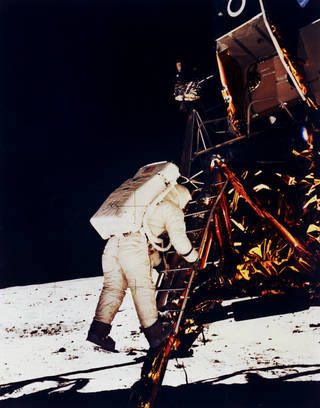
In recent decades, space travel technology has seen some incredible advancements. Especially with the advent of private space companies like SpaceX, Virgin Galactic, and Blue Origin, the dream of space tourism is looking more and more realistic for everyone!
However, when it comes to including women, we are yet to make great strides. So far, 566 people have traveled to space. Only 65 of them were women .
Although the first woman in space, a Soviet astronaut Valentina Tereshkova , who orbited Earth 48 times, went into orbit in June 1963. It was only in October 2019 that the first all-female spacewalk was completed by NASA astronauts Jessica Meir and Christina Koch.
Women's access to space is still far from equal, but there are signs of progress, like NASA planning to land the first woman and first person of color on the moon by 2024 with its Artemis missions. World Space Week is also celebrating the achievements and contributions of women in space this year!
In the following sections, we will explore the feasibility of space travel and its associated challenges.
How fast can we travel in space? Is interstellar travel possible?
Interstellar space is a rather empty place. Its temperature is not much more than the coldest possible temperature, i.e., an absolute zero. It equals about 3 kelvins – minus 270 °C or minus 455 °F. You can't find air there, and therefore there is no drag or friction. On the one hand, humans can't survive in such a hostile place without expensive equipment like a spacesuit or a spaceship, but on the other hand, we can make use of space conditions and its emptiness.
The main advantage of future spaceships is that, since they are moving through a vacuum, they can theoretically accelerate to infinite speeds! However, this is only possible in the classical world of relatively low speeds, where Newtonian physics can be applied. Even if it's true, let's imagine, just for a moment, that we live in a world where any speed is allowed. How long will it take to visit the Andromeda Galaxy, the nearest galaxy to the Milky Way?

We will begin our intergalactic travel with a constant acceleration of 1 g (9.81 m/s² or 32.17 ft/s²) because it ensures that the crew experiences the same comfortable gravitational field as the one on Earth. By using this space travel calculator in Newton's universe mode, you can find out that you need about 2200 years to arrive at the nearest galaxy! And, if you want to stop there, you need an additional 1000 years . Nobody lives for 3000 years! Is intergalactic travel impossible for us, then? Luckily, we have good news. We live in a world of relativistic effects, where unusual phenomena readily occur.
Can humans travel at the speed of light? – relativistic space travel
In the previous example, where we traveled to Andromeda Galaxy, the maximum velocity was almost 3000 times greater than the speed of light c = 299,792,458 m/s , or about c = 3 × 10 8 m/s using scientific notation.
However, as velocity increases, relativistic effects start to play an essential role. According to special relativity proposed by Albert Einstein, nothing can exceed the speed of light. How can it help us with interstellar space travel? Doesn't it mean we will travel at a much lower speed? Yes, it does, but there are also a few new relativistic phenomena, including time dilation and length contraction, to name a few. The former is crucial in relativistic space travel.
Time dilation is a difference of time measured by two observers, one being in motion and the second at rest (relative to each other). It is something we are not used to on Earth. Clocks in a moving spaceship tick slower than the same clocks on Earth ! Time passing in a moving spaceship T T T and equivalent time observed on Earth t t t are related by the following formula:
where γ \gamma γ is the Lorentz factor that comprises the speed of the spaceship v v v and the speed of light c c c :
where β = v / c \beta = v/c β = v / c .
For example, if γ = 10 \gamma = 10 γ = 10 ( v = 0.995 c v = 0.995c v = 0.995 c ), then every second passing on Earth corresponds to ten seconds passing in the spaceship. Inside the spacecraft, events take place 90 percent slower; the difference can be even greater for higher velocities. Note that both observers can be in motion, too. In that case, to calculate the relative relativistic velocity, you can use our velocity addition calculator .
Let's go back to our example again, but this time we're in Einstein's universe of relativistic effects trying to reach Andromeda. The time needed to get there, measured by the crew of the spaceship, equals only 15 years ! Well, this is still a long time, but it is more achievable in a practical sense. If you would like to stop at the destination, you should start decelerating halfway through. In this situation, the time passed in the spaceship will be extended by about 13 additional years .
Unfortunately, this is only a one-way journey. You can, of course, go back to Earth, but nothing will be the same. During your interstellar space travel to the Andromeda Galaxy, about 2,500,000 years have passed on Earth. It would be a completely different planet, and nobody could foresee the fate of our civilization.
A similar problem was considered in the first Planet of the Apes movie, where astronauts crash-landed back on Earth. While these astronauts had only aged by 18 months, 2000 years had passed on Earth (sorry for the spoilers, but the film is over 50 years old at this point, you should have seen it by now). How about you? Would you be able to leave everything you know and love about our galaxy forever and begin a life of space exploration?
Space travel calculator – relativistic rocket equation
Now that you know whether interstellar travel is possible and how fast we can travel in space, it's time for some formulas. In this section, you can find the "classical" and relativistic rocket equations that are included in the relativistic space travel calculator.
There could be four combinations since we want to estimate how long it takes to arrive at the destination point at full speed as well as arrive at the destination point and stop. Every set contains distance, time passing on Earth and in the spaceship (only relativity approach), expected maximum velocity and corresponding kinetic energy (on the additional parameters section), and the required fuel mass (see Intergalactic travel — fuel problem section for more information). The notation is:
- a a a — Spaceship acceleration (by default 1 g 1\rm\, g 1 g ). We assume it is positive a > 0 a > 0 a > 0 (at least until halfway) and constant.
- m m m — Spaceship mass. It is required to calculate kinetic energy (and fuel).
- d d d — Distance to the destination. Note that you can select it from the list or type in any other distance to the desired object.
- T T T — Time that passed in a spaceship, or, in other words, how much the crew has aged.
- t t t — Time that passed in a resting frame of reference, e.g., on Earth.
- v v v — Maximum velocity reached by the spaceship.
- K E \rm KE KE — Maximum kinetic energy reached by the spaceship.
The relativistic space travel calculator is dedicated to very long journeys, interstellar or even intergalactic, in which we can neglect the influence of the gravitational field, e.g., from Earth. We didn't include our closest celestial bodies, like the Moon or Mars, in the destination list because it would be pointless. For them, we need different equations that also take into consideration gravitational force.
Newton's universe — arrive at the destination at full speed
It's the simplest case because here, T T T equals t t t for any speed. To calculate the distance covered at constant acceleration during a certain time, you can use the following classical formula:
Since acceleration is constant, and we assume that the initial velocity equals zero, you can estimate the maximum velocity using this equation:
and the corresponding kinetic energy:
Newton's universe — arrive at the destination and stop
In this situation, we accelerate to the halfway point, reach maximum velocity, and then decelerate to stop at the destination point. Distance covered during the same time is, as you may expect, smaller than before:
Acceleration remains positive until we're halfway there (then it is negative – deceleration), so the maximum velocity is:
and the kinetic energy equation is the same as the previous one.
Einstein's universe — arrive at the destination at full speed
The relativistic rocket equation has to consider the effects of light-speed travel. These are not only speed limitations and time dilation but also how every length becomes shorter for a moving observer, which is a phenomenon of special relativity called length contraction. If l l l is the proper length observed in the rest frame and L L L is the length observed by a crew in a spaceship, then:
What does it mean? If a spaceship moves with the velocity of v = 0.995 c v = 0.995c v = 0.995 c , then γ = 10 \gamma = 10 γ = 10 , and the length observed by a moving object is ten times smaller than the real length. For example, the distance to the Andromeda Galaxy equals about 2,520,000 light years with Earth as the frame of reference. For a spaceship moving with v = 0.995 c v = 0.995c v = 0.995 c , it will be "only" 252,200 light years away. That's a 90 percent decrease or a 164 percent difference!
Now you probably understand why special relativity allows us to intergalactic travel. Below you can find the relativistic rocket equation for the case in which you want to arrive at the destination point at full speed (without stopping). You can find its derivation in the book by Messrs Misner, Thorne ( Co-Winner of the 2017 Nobel Prize in Physics ) and Wheller titled Gravitation , section §6.2. Hyperbolic motion. More accessible formulas are in the mathematical physicist John Baez's article The Relativistic Rocket :
- Time passed on Earth:
- Time passed in the spaceship:
- Maximum velocity:
- Relativistic kinetic energy remains the same:
The symbols sh \sh sh , ch \ch ch , and th \th th are, respectively, sine, cosine, and tangent hyperbolic functions, which are analogs of the ordinary trigonometric functions. In turn, sh − 1 \sh^{-1} sh − 1 and ch − 1 \ch^{-1} ch − 1 are the inverse hyperbolic functions that can be expressed with natural logarithms and square roots, according to the article Inverse hyperbolic functions on Wikipedia.
Einstein's universe – arrive at destination point and stop
Most websites with relativistic rocket equations consider only arriving at the desired place at full speed. If you want to stop there, you should start decelerating at the halfway point. Below, you can find a set of equations estimating interstellar space travel parameters in the situation when you want to stop at the destination point :
Intergalactic travel – fuel problem
So, after all of these considerations, can humans travel at the speed of light, or at least at a speed close to it? Jet-rocket engines need a lot of fuel per unit of weight of the rocket. You can use our rocket equation calculator to see how much fuel you need to obtain a certain velocity (e.g., with an effective exhaust velocity of 4500 m/s).
Hopefully, future spaceships will be able to produce energy from matter-antimatter annihilation. This process releases energy from two particles that have mass (e.g., electron and positron) into photons. These photons may then be shot out at the back of the spaceship and accelerate the spaceship due to the conservation of momentum. If you want to know how much energy is contained in matter, check out our E = mc² calculator , which is about the famous Albert Einstein equation.
Now that you know the maximum amount of energy you can acquire from matter, it's time to estimate how much of it you need for intergalactic travel. Appropriate formulas are derived from the conservation of momentum and energy principles. For the relativistic case:
where e x e^x e x is an exponential function, and for classical case:
Remember that it assumes 100% efficiency! One of the promising future spaceships' power sources is the fusion of hydrogen into helium, which provides energy of 0.008 mc² . As you can see, in this reaction, efficiency equals only 0.8%.
Let's check whether the fuel mass amount is reasonable for sending a mass of 1 kg to the nearest galaxy. With a space travel calculator, you can find out that, even with 100% efficiency, you would need 5,200 tons of fuel to send only 1 kilogram of your spaceship . That's a lot!
So can humans travel at the speed of light? Right now, it seems impossible, but technology is still developing. For example, a photonic laser thruster is a good candidate since it doesn't require any matter to work, only photons. Infinity and beyond is actually within our reach!
How do I calculate the travel time to other planets?
To calculate the time it takes to travel to a specific star or galaxy using the space travel calculator, follow these steps:
- Choose the acceleration : the default mode is 1 g (gravitational field similar to Earth's).
- Enter the spaceship mass , excluding fuel.
- Select the destination : pick the star, planet, or galaxy you want to travel to from the dropdown menu.
- The distance between the Earth and your chosen stars will automatically appear. You can also input the distance in light-years directly if you select the Custom distance option in the previous dropdown.
- Define the aim : select whether you aim to " Arrive at destination and stop " or “ Arrive at destination at full speed ”.
- Pick the calculation mode : opt for either " Einstein's universe " mode for relativistic effects or " Newton's universe " for simpler calculations.
- Time passed in spaceship : estimated time experienced by the crew during the journey. (" Einstein's universe " mode)
- Time passed on Earth : estimated time elapsed on Earth during the trip. (" Einstein's universe " mode)
- Time passed : depends on the frame of reference, e.g., on Earth. (" Newton's universe " mode)
- Required fuel mass : estimated fuel quantity needed for the journey.
- Maximum velocity : maximum speed achieved by the spaceship.
How long does it take to get to space?
It takes about 8.5 minutes for a space shuttle or spacecraft to reach Earth's orbit, i.e., the limit of space where the Earth's atmosphere ends. This dividing line between the Earth's atmosphere and space is called the Kármán line . It happens so quickly because the shuttle goes from zero to around 17,500 miles per hour in those 8.5 minutes .
How fast does the space station travel?
The International Space Station travels at an average speed of 28,000 km/h or 17,500 mph . In a single day, the ISS can make several complete revolutions as it circumnavigates the globe in just 90 minutes . Placed in orbit at an altitude of 350 km , the station is visible to the naked eye, looking like a dot crossing the sky due to its very bright solar panels.
How do I reach the speed of light?
To reach the speed of light, you would have to overcome several obstacles, including:
Mass limit : traveling at the speed of light would mean traveling at 299,792,458 meters per second. But, thanks to Einstein's theory of relativity, we know that an object with non-zero mass cannot reach this speed.
Energy : accelerating to the speed of light would require infinite energy.
Effects of relativity : from the outside, time would slow down, and you would shrink.
Why can't sound travel in space?
Sound can’t travel in space because it is a mechanical wave that requires a medium to propagate — this medium can be solid, liquid, or gas. In space, there is no matter, or at least not enough for sound to propagate. The density of matter in space is of the order 1 particle per cubic centimeter . While on Earth , it's much denser at around 10 20 particles per cubic centimeter .
Dreaming of traveling into space? 🌌 Plan your interstellar travel (even to a Star Trek destination) using this calculator 👨🚀! Estimate how fast you can reach your destination and how much fuel you would need 🚀
.css-slt4t3.css-slt4t3{color:#2B3148;background-color:transparent;font-family:"Roboto","Helvetica","Arial",sans-serif;font-size:20px;line-height:24px;overflow:visible;padding-top:0px;position:relative;}.css-slt4t3.css-slt4t3:after{content:'';-webkit-transform:scale(0);-moz-transform:scale(0);-ms-transform:scale(0);transform:scale(0);position:absolute;border:2px solid #EA9430;border-radius:2px;inset:-8px;z-index:1;}.css-slt4t3 .js-external-link-button.link-like,.css-slt4t3 .js-external-link-anchor{color:inherit;border-radius:1px;-webkit-text-decoration:underline;text-decoration:underline;}.css-slt4t3 .js-external-link-button.link-like:hover,.css-slt4t3 .js-external-link-anchor:hover,.css-slt4t3 .js-external-link-button.link-like:active,.css-slt4t3 .js-external-link-anchor:active{text-decoration-thickness:2px;text-shadow:1px 0 0;}.css-slt4t3 .js-external-link-button.link-like:focus-visible,.css-slt4t3 .js-external-link-anchor:focus-visible{outline:transparent 2px dotted;box-shadow:0 0 0 2px #6314E6;}.css-slt4t3 p,.css-slt4t3 div{margin:0px;display:block;}.css-slt4t3 pre{margin:0px;display:block;}.css-slt4t3 pre code{display:block;width:-webkit-fit-content;width:-moz-fit-content;width:fit-content;}.css-slt4t3 pre:not(:first-child){padding-top:8px;}.css-slt4t3 ul,.css-slt4t3 ol{display:block margin:0px;padding-left:20px;}.css-slt4t3 ul li,.css-slt4t3 ol li{padding-top:8px;}.css-slt4t3 ul ul,.css-slt4t3 ol ul,.css-slt4t3 ul ol,.css-slt4t3 ol ol{padding-top:0px;}.css-slt4t3 ul:not(:first-child),.css-slt4t3 ol:not(:first-child){padding-top:4px;} .css-4okk7a{margin:auto;background-color:white;overflow:auto;overflow-wrap:break-word;word-break:break-word;}.css-4okk7a code,.css-4okk7a kbd,.css-4okk7a pre,.css-4okk7a samp{font-family:monospace;}.css-4okk7a code{padding:2px 4px;color:#444;background:#ddd;border-radius:4px;}.css-4okk7a figcaption,.css-4okk7a caption{text-align:center;}.css-4okk7a figcaption{font-size:12px;font-style:italic;overflow:hidden;}.css-4okk7a h3{font-size:1.75rem;}.css-4okk7a h4{font-size:1.5rem;}.css-4okk7a .mathBlock{font-size:24px;-webkit-padding-start:4px;padding-inline-start:4px;}.css-4okk7a .mathBlock .katex{font-size:24px;text-align:left;}.css-4okk7a .math-inline{background-color:#f0f0f0;display:inline-block;font-size:inherit;padding:0 3px;}.css-4okk7a .videoBlock,.css-4okk7a .imageBlock{margin-bottom:16px;}.css-4okk7a .imageBlock__image-align--left,.css-4okk7a .videoBlock__video-align--left{float:left;}.css-4okk7a .imageBlock__image-align--right,.css-4okk7a .videoBlock__video-align--right{float:right;}.css-4okk7a .imageBlock__image-align--center,.css-4okk7a .videoBlock__video-align--center{display:block;margin-left:auto;margin-right:auto;clear:both;}.css-4okk7a .imageBlock__image-align--none,.css-4okk7a .videoBlock__video-align--none{clear:both;margin-left:0;margin-right:0;}.css-4okk7a .videoBlock__video--wrapper{position:relative;padding-bottom:56.25%;height:0;}.css-4okk7a .videoBlock__video--wrapper iframe{position:absolute;top:0;left:0;width:100%;height:100%;}.css-4okk7a .videoBlock__caption{text-align:left;}@font-face{font-family:'KaTeX_AMS';src:url(/katex-fonts/KaTeX_AMS-Regular.woff2) format('woff2'),url(/katex-fonts/KaTeX_AMS-Regular.woff) format('woff'),url(/katex-fonts/KaTeX_AMS-Regular.ttf) format('truetype');font-weight:normal;font-style:normal;}@font-face{font-family:'KaTeX_Caligraphic';src:url(/katex-fonts/KaTeX_Caligraphic-Bold.woff2) format('woff2'),url(/katex-fonts/KaTeX_Caligraphic-Bold.woff) format('woff'),url(/katex-fonts/KaTeX_Caligraphic-Bold.ttf) format('truetype');font-weight:bold;font-style:normal;}@font-face{font-family:'KaTeX_Caligraphic';src:url(/katex-fonts/KaTeX_Caligraphic-Regular.woff2) format('woff2'),url(/katex-fonts/KaTeX_Caligraphic-Regular.woff) format('woff'),url(/katex-fonts/KaTeX_Caligraphic-Regular.ttf) format('truetype');font-weight:normal;font-style:normal;}@font-face{font-family:'KaTeX_Fraktur';src:url(/katex-fonts/KaTeX_Fraktur-Bold.woff2) format('woff2'),url(/katex-fonts/KaTeX_Fraktur-Bold.woff) format('woff'),url(/katex-fonts/KaTeX_Fraktur-Bold.ttf) format('truetype');font-weight:bold;font-style:normal;}@font-face{font-family:'KaTeX_Fraktur';src:url(/katex-fonts/KaTeX_Fraktur-Regular.woff2) format('woff2'),url(/katex-fonts/KaTeX_Fraktur-Regular.woff) format('woff'),url(/katex-fonts/KaTeX_Fraktur-Regular.ttf) format('truetype');font-weight:normal;font-style:normal;}@font-face{font-family:'KaTeX_Main';src:url(/katex-fonts/KaTeX_Main-Bold.woff2) format('woff2'),url(/katex-fonts/KaTeX_Main-Bold.woff) format('woff'),url(/katex-fonts/KaTeX_Main-Bold.ttf) format('truetype');font-weight:bold;font-style:normal;}@font-face{font-family:'KaTeX_Main';src:url(/katex-fonts/KaTeX_Main-BoldItalic.woff2) format('woff2'),url(/katex-fonts/KaTeX_Main-BoldItalic.woff) format('woff'),url(/katex-fonts/KaTeX_Main-BoldItalic.ttf) format('truetype');font-weight:bold;font-style:italic;}@font-face{font-family:'KaTeX_Main';src:url(/katex-fonts/KaTeX_Main-Italic.woff2) format('woff2'),url(/katex-fonts/KaTeX_Main-Italic.woff) format('woff'),url(/katex-fonts/KaTeX_Main-Italic.ttf) format('truetype');font-weight:normal;font-style:italic;}@font-face{font-family:'KaTeX_Main';src:url(/katex-fonts/KaTeX_Main-Regular.woff2) format('woff2'),url(/katex-fonts/KaTeX_Main-Regular.woff) format('woff'),url(/katex-fonts/KaTeX_Main-Regular.ttf) format('truetype');font-weight:normal;font-style:normal;}@font-face{font-family:'KaTeX_Math';src:url(/katex-fonts/KaTeX_Math-BoldItalic.woff2) format('woff2'),url(/katex-fonts/KaTeX_Math-BoldItalic.woff) format('woff'),url(/katex-fonts/KaTeX_Math-BoldItalic.ttf) format('truetype');font-weight:bold;font-style:italic;}@font-face{font-family:'KaTeX_Math';src:url(/katex-fonts/KaTeX_Math-Italic.woff2) format('woff2'),url(/katex-fonts/KaTeX_Math-Italic.woff) format('woff'),url(/katex-fonts/KaTeX_Math-Italic.ttf) format('truetype');font-weight:normal;font-style:italic;}@font-face{font-family:'KaTeX_SansSerif';src:url(/katex-fonts/KaTeX_SansSerif-Bold.woff2) format('woff2'),url(/katex-fonts/KaTeX_SansSerif-Bold.woff) format('woff'),url(/katex-fonts/KaTeX_SansSerif-Bold.ttf) format('truetype');font-weight:bold;font-style:normal;}@font-face{font-family:'KaTeX_SansSerif';src:url(/katex-fonts/KaTeX_SansSerif-Italic.woff2) format('woff2'),url(/katex-fonts/KaTeX_SansSerif-Italic.woff) format('woff'),url(/katex-fonts/KaTeX_SansSerif-Italic.ttf) format('truetype');font-weight:normal;font-style:italic;}@font-face{font-family:'KaTeX_SansSerif';src:url(/katex-fonts/KaTeX_SansSerif-Regular.woff2) format('woff2'),url(/katex-fonts/KaTeX_SansSerif-Regular.woff) format('woff'),url(/katex-fonts/KaTeX_SansSerif-Regular.ttf) format('truetype');font-weight:normal;font-style:normal;}@font-face{font-family:'KaTeX_Script';src:url(/katex-fonts/KaTeX_Script-Regular.woff2) format('woff2'),url(/katex-fonts/KaTeX_Script-Regular.woff) format('woff'),url(/katex-fonts/KaTeX_Script-Regular.ttf) format('truetype');font-weight:normal;font-style:normal;}@font-face{font-family:'KaTeX_Size1';src:url(/katex-fonts/KaTeX_Size1-Regular.woff2) format('woff2'),url(/katex-fonts/KaTeX_Size1-Regular.woff) format('woff'),url(/katex-fonts/KaTeX_Size1-Regular.ttf) format('truetype');font-weight:normal;font-style:normal;}@font-face{font-family:'KaTeX_Size2';src:url(/katex-fonts/KaTeX_Size2-Regular.woff2) format('woff2'),url(/katex-fonts/KaTeX_Size2-Regular.woff) format('woff'),url(/katex-fonts/KaTeX_Size2-Regular.ttf) format('truetype');font-weight:normal;font-style:normal;}@font-face{font-family:'KaTeX_Size3';src:url(/katex-fonts/KaTeX_Size3-Regular.woff2) format('woff2'),url(/katex-fonts/KaTeX_Size3-Regular.woff) format('woff'),url(/katex-fonts/KaTeX_Size3-Regular.ttf) format('truetype');font-weight:normal;font-style:normal;}@font-face{font-family:'KaTeX_Size4';src:url(/katex-fonts/KaTeX_Size4-Regular.woff2) format('woff2'),url(/katex-fonts/KaTeX_Size4-Regular.woff) format('woff'),url(/katex-fonts/KaTeX_Size4-Regular.ttf) format('truetype');font-weight:normal;font-style:normal;}@font-face{font-family:'KaTeX_Typewriter';src:url(/katex-fonts/KaTeX_Typewriter-Regular.woff2) format('woff2'),url(/katex-fonts/KaTeX_Typewriter-Regular.woff) format('woff'),url(/katex-fonts/KaTeX_Typewriter-Regular.ttf) format('truetype');font-weight:normal;font-style:normal;}.css-4okk7a .katex{font:normal 1.21em KaTeX_Main,Times New Roman,serif;line-height:1.2;text-indent:0;text-rendering:auto;}.css-4okk7a .katex *{-ms-high-contrast-adjust:none!important;border-color:currentColor;}.css-4okk7a .katex .katex-version::after{content:'0.13.13';}.css-4okk7a .katex .katex-mathml{position:absolute;clip:rect(1px, 1px, 1px, 1px);padding:0;border:0;height:1px;width:1px;overflow:hidden;}.css-4okk7a .katex .katex-html>.newline{display:block;}.css-4okk7a .katex .base{position:relative;display:inline-block;white-space:nowrap;width:-webkit-min-content;width:-moz-min-content;width:-webkit-min-content;width:-moz-min-content;width:min-content;}.css-4okk7a .katex .strut{display:inline-block;}.css-4okk7a .katex .textbf{font-weight:bold;}.css-4okk7a .katex .textit{font-style:italic;}.css-4okk7a .katex .textrm{font-family:KaTeX_Main;}.css-4okk7a .katex .textsf{font-family:KaTeX_SansSerif;}.css-4okk7a .katex .texttt{font-family:KaTeX_Typewriter;}.css-4okk7a .katex .mathnormal{font-family:KaTeX_Math;font-style:italic;}.css-4okk7a .katex .mathit{font-family:KaTeX_Main;font-style:italic;}.css-4okk7a .katex .mathrm{font-style:normal;}.css-4okk7a .katex .mathbf{font-family:KaTeX_Main;font-weight:bold;}.css-4okk7a .katex .boldsymbol{font-family:KaTeX_Math;font-weight:bold;font-style:italic;}.css-4okk7a .katex .amsrm{font-family:KaTeX_AMS;}.css-4okk7a .katex .mathbb,.css-4okk7a .katex .textbb{font-family:KaTeX_AMS;}.css-4okk7a .katex .mathcal{font-family:KaTeX_Caligraphic;}.css-4okk7a .katex .mathfrak,.css-4okk7a .katex .textfrak{font-family:KaTeX_Fraktur;}.css-4okk7a .katex .mathtt{font-family:KaTeX_Typewriter;}.css-4okk7a .katex .mathscr,.css-4okk7a .katex .textscr{font-family:KaTeX_Script;}.css-4okk7a .katex .mathsf,.css-4okk7a .katex .textsf{font-family:KaTeX_SansSerif;}.css-4okk7a .katex .mathboldsf,.css-4okk7a .katex .textboldsf{font-family:KaTeX_SansSerif;font-weight:bold;}.css-4okk7a .katex .mathitsf,.css-4okk7a .katex .textitsf{font-family:KaTeX_SansSerif;font-style:italic;}.css-4okk7a .katex .mainrm{font-family:KaTeX_Main;font-style:normal;}.css-4okk7a .katex .vlist-t{display:inline-table;table-layout:fixed;border-collapse:collapse;}.css-4okk7a .katex .vlist-r{display:table-row;}.css-4okk7a .katex .vlist{display:table-cell;vertical-align:bottom;position:relative;}.css-4okk7a .katex .vlist>span{display:block;height:0;position:relative;}.css-4okk7a .katex .vlist>span>span{display:inline-block;}.css-4okk7a .katex .vlist>span>.pstrut{overflow:hidden;width:0;}.css-4okk7a .katex .vlist-t2{margin-right:-2px;}.css-4okk7a .katex .vlist-s{display:table-cell;vertical-align:bottom;font-size:1px;width:2px;min-width:2px;}.css-4okk7a .katex .vbox{display:-webkit-inline-box;display:-webkit-inline-flex;display:-ms-inline-flexbox;display:inline-flex;-webkit-flex-direction:column;-ms-flex-direction:column;flex-direction:column;-webkit-align-items:baseline;-webkit-box-align:baseline;-ms-flex-align:baseline;align-items:baseline;}.css-4okk7a .katex .hbox{display:-webkit-inline-box;display:-webkit-inline-flex;display:-ms-inline-flexbox;display:inline-flex;-webkit-flex-direction:row;-ms-flex-direction:row;flex-direction:row;width:100%;}.css-4okk7a .katex .thinbox{display:-webkit-inline-box;display:-webkit-inline-flex;display:-ms-inline-flexbox;display:inline-flex;-webkit-flex-direction:row;-ms-flex-direction:row;flex-direction:row;width:0;max-width:0;}.css-4okk7a .katex .msupsub{text-align:left;}.css-4okk7a .katex .mfrac>span>span{text-align:center;}.css-4okk7a .katex .mfrac .frac-line{display:inline-block;width:100%;border-bottom-style:solid;}.css-4okk7a .katex .mfrac .frac-line,.css-4okk7a .katex .overline .overline-line,.css-4okk7a .katex .underline .underline-line,.css-4okk7a .katex .hline,.css-4okk7a .katex .hdashline,.css-4okk7a .katex .rule{min-height:1px;}.css-4okk7a .katex .mspace{display:inline-block;}.css-4okk7a .katex .llap,.css-4okk7a .katex .rlap,.css-4okk7a .katex .clap{width:0;position:relative;}.css-4okk7a .katex .llap>.inner,.css-4okk7a .katex .rlap>.inner,.css-4okk7a .katex .clap>.inner{position:absolute;}.css-4okk7a .katex .llap>.fix,.css-4okk7a .katex .rlap>.fix,.css-4okk7a .katex .clap>.fix{display:inline-block;}.css-4okk7a .katex .llap>.inner{right:0;}.css-4okk7a .katex .rlap>.inner,.css-4okk7a .katex .clap>.inner{left:0;}.css-4okk7a .katex .clap>.inner>span{margin-left:-50%;margin-right:50%;}.css-4okk7a .katex .rule{display:inline-block;border:solid 0;position:relative;}.css-4okk7a .katex .overline .overline-line,.css-4okk7a .katex .underline .underline-line,.css-4okk7a .katex .hline{display:inline-block;width:100%;border-bottom-style:solid;}.css-4okk7a .katex .hdashline{display:inline-block;width:100%;border-bottom-style:dashed;}.css-4okk7a .katex .sqrt>.root{margin-left:0.27777778em;margin-right:-0.55555556em;}.css-4okk7a .katex .sizing.reset-size1.size1,.css-4okk7a .katex .fontsize-ensurer.reset-size1.size1{font-size:1em;}.css-4okk7a .katex .sizing.reset-size1.size2,.css-4okk7a .katex .fontsize-ensurer.reset-size1.size2{font-size:1.2em;}.css-4okk7a .katex .sizing.reset-size1.size3,.css-4okk7a .katex .fontsize-ensurer.reset-size1.size3{font-size:1.4em;}.css-4okk7a .katex .sizing.reset-size1.size4,.css-4okk7a .katex .fontsize-ensurer.reset-size1.size4{font-size:1.6em;}.css-4okk7a .katex .sizing.reset-size1.size5,.css-4okk7a .katex .fontsize-ensurer.reset-size1.size5{font-size:1.8em;}.css-4okk7a .katex .sizing.reset-size1.size6,.css-4okk7a .katex .fontsize-ensurer.reset-size1.size6{font-size:2em;}.css-4okk7a .katex .sizing.reset-size1.size7,.css-4okk7a .katex .fontsize-ensurer.reset-size1.size7{font-size:2.4em;}.css-4okk7a .katex .sizing.reset-size1.size8,.css-4okk7a .katex .fontsize-ensurer.reset-size1.size8{font-size:2.88em;}.css-4okk7a .katex .sizing.reset-size1.size9,.css-4okk7a .katex .fontsize-ensurer.reset-size1.size9{font-size:3.456em;}.css-4okk7a .katex .sizing.reset-size1.size10,.css-4okk7a .katex .fontsize-ensurer.reset-size1.size10{font-size:4.148em;}.css-4okk7a .katex .sizing.reset-size1.size11,.css-4okk7a .katex .fontsize-ensurer.reset-size1.size11{font-size:4.976em;}.css-4okk7a .katex .sizing.reset-size2.size1,.css-4okk7a .katex .fontsize-ensurer.reset-size2.size1{font-size:0.83333333em;}.css-4okk7a .katex .sizing.reset-size2.size2,.css-4okk7a .katex .fontsize-ensurer.reset-size2.size2{font-size:1em;}.css-4okk7a .katex .sizing.reset-size2.size3,.css-4okk7a .katex .fontsize-ensurer.reset-size2.size3{font-size:1.16666667em;}.css-4okk7a .katex .sizing.reset-size2.size4,.css-4okk7a .katex .fontsize-ensurer.reset-size2.size4{font-size:1.33333333em;}.css-4okk7a .katex .sizing.reset-size2.size5,.css-4okk7a .katex .fontsize-ensurer.reset-size2.size5{font-size:1.5em;}.css-4okk7a .katex .sizing.reset-size2.size6,.css-4okk7a .katex .fontsize-ensurer.reset-size2.size6{font-size:1.66666667em;}.css-4okk7a .katex .sizing.reset-size2.size7,.css-4okk7a .katex .fontsize-ensurer.reset-size2.size7{font-size:2em;}.css-4okk7a .katex .sizing.reset-size2.size8,.css-4okk7a .katex .fontsize-ensurer.reset-size2.size8{font-size:2.4em;}.css-4okk7a .katex .sizing.reset-size2.size9,.css-4okk7a .katex .fontsize-ensurer.reset-size2.size9{font-size:2.88em;}.css-4okk7a .katex .sizing.reset-size2.size10,.css-4okk7a .katex .fontsize-ensurer.reset-size2.size10{font-size:3.45666667em;}.css-4okk7a .katex .sizing.reset-size2.size11,.css-4okk7a .katex .fontsize-ensurer.reset-size2.size11{font-size:4.14666667em;}.css-4okk7a .katex .sizing.reset-size3.size1,.css-4okk7a .katex .fontsize-ensurer.reset-size3.size1{font-size:0.71428571em;}.css-4okk7a .katex .sizing.reset-size3.size2,.css-4okk7a .katex .fontsize-ensurer.reset-size3.size2{font-size:0.85714286em;}.css-4okk7a .katex .sizing.reset-size3.size3,.css-4okk7a .katex .fontsize-ensurer.reset-size3.size3{font-size:1em;}.css-4okk7a .katex .sizing.reset-size3.size4,.css-4okk7a .katex .fontsize-ensurer.reset-size3.size4{font-size:1.14285714em;}.css-4okk7a .katex .sizing.reset-size3.size5,.css-4okk7a .katex .fontsize-ensurer.reset-size3.size5{font-size:1.28571429em;}.css-4okk7a .katex .sizing.reset-size3.size6,.css-4okk7a .katex .fontsize-ensurer.reset-size3.size6{font-size:1.42857143em;}.css-4okk7a .katex .sizing.reset-size3.size7,.css-4okk7a .katex .fontsize-ensurer.reset-size3.size7{font-size:1.71428571em;}.css-4okk7a .katex .sizing.reset-size3.size8,.css-4okk7a .katex .fontsize-ensurer.reset-size3.size8{font-size:2.05714286em;}.css-4okk7a .katex .sizing.reset-size3.size9,.css-4okk7a .katex .fontsize-ensurer.reset-size3.size9{font-size:2.46857143em;}.css-4okk7a .katex .sizing.reset-size3.size10,.css-4okk7a .katex .fontsize-ensurer.reset-size3.size10{font-size:2.96285714em;}.css-4okk7a .katex .sizing.reset-size3.size11,.css-4okk7a .katex .fontsize-ensurer.reset-size3.size11{font-size:3.55428571em;}.css-4okk7a .katex .sizing.reset-size4.size1,.css-4okk7a .katex .fontsize-ensurer.reset-size4.size1{font-size:0.625em;}.css-4okk7a .katex .sizing.reset-size4.size2,.css-4okk7a .katex .fontsize-ensurer.reset-size4.size2{font-size:0.75em;}.css-4okk7a .katex .sizing.reset-size4.size3,.css-4okk7a .katex .fontsize-ensurer.reset-size4.size3{font-size:0.875em;}.css-4okk7a .katex .sizing.reset-size4.size4,.css-4okk7a .katex .fontsize-ensurer.reset-size4.size4{font-size:1em;}.css-4okk7a .katex .sizing.reset-size4.size5,.css-4okk7a .katex .fontsize-ensurer.reset-size4.size5{font-size:1.125em;}.css-4okk7a .katex .sizing.reset-size4.size6,.css-4okk7a .katex .fontsize-ensurer.reset-size4.size6{font-size:1.25em;}.css-4okk7a .katex .sizing.reset-size4.size7,.css-4okk7a .katex .fontsize-ensurer.reset-size4.size7{font-size:1.5em;}.css-4okk7a .katex .sizing.reset-size4.size8,.css-4okk7a .katex .fontsize-ensurer.reset-size4.size8{font-size:1.8em;}.css-4okk7a .katex .sizing.reset-size4.size9,.css-4okk7a .katex .fontsize-ensurer.reset-size4.size9{font-size:2.16em;}.css-4okk7a .katex .sizing.reset-size4.size10,.css-4okk7a .katex .fontsize-ensurer.reset-size4.size10{font-size:2.5925em;}.css-4okk7a .katex .sizing.reset-size4.size11,.css-4okk7a .katex .fontsize-ensurer.reset-size4.size11{font-size:3.11em;}.css-4okk7a .katex .sizing.reset-size5.size1,.css-4okk7a .katex .fontsize-ensurer.reset-size5.size1{font-size:0.55555556em;}.css-4okk7a .katex .sizing.reset-size5.size2,.css-4okk7a .katex .fontsize-ensurer.reset-size5.size2{font-size:0.66666667em;}.css-4okk7a .katex .sizing.reset-size5.size3,.css-4okk7a .katex .fontsize-ensurer.reset-size5.size3{font-size:0.77777778em;}.css-4okk7a .katex .sizing.reset-size5.size4,.css-4okk7a .katex .fontsize-ensurer.reset-size5.size4{font-size:0.88888889em;}.css-4okk7a .katex .sizing.reset-size5.size5,.css-4okk7a .katex .fontsize-ensurer.reset-size5.size5{font-size:1em;}.css-4okk7a .katex .sizing.reset-size5.size6,.css-4okk7a .katex .fontsize-ensurer.reset-size5.size6{font-size:1.11111111em;}.css-4okk7a .katex .sizing.reset-size5.size7,.css-4okk7a .katex .fontsize-ensurer.reset-size5.size7{font-size:1.33333333em;}.css-4okk7a .katex .sizing.reset-size5.size8,.css-4okk7a .katex .fontsize-ensurer.reset-size5.size8{font-size:1.6em;}.css-4okk7a .katex .sizing.reset-size5.size9,.css-4okk7a .katex .fontsize-ensurer.reset-size5.size9{font-size:1.92em;}.css-4okk7a .katex .sizing.reset-size5.size10,.css-4okk7a .katex .fontsize-ensurer.reset-size5.size10{font-size:2.30444444em;}.css-4okk7a .katex .sizing.reset-size5.size11,.css-4okk7a .katex .fontsize-ensurer.reset-size5.size11{font-size:2.76444444em;}.css-4okk7a .katex .sizing.reset-size6.size1,.css-4okk7a .katex .fontsize-ensurer.reset-size6.size1{font-size:0.5em;}.css-4okk7a .katex .sizing.reset-size6.size2,.css-4okk7a .katex .fontsize-ensurer.reset-size6.size2{font-size:0.6em;}.css-4okk7a .katex .sizing.reset-size6.size3,.css-4okk7a .katex .fontsize-ensurer.reset-size6.size3{font-size:0.7em;}.css-4okk7a .katex .sizing.reset-size6.size4,.css-4okk7a .katex .fontsize-ensurer.reset-size6.size4{font-size:0.8em;}.css-4okk7a .katex .sizing.reset-size6.size5,.css-4okk7a .katex .fontsize-ensurer.reset-size6.size5{font-size:0.9em;}.css-4okk7a .katex .sizing.reset-size6.size6,.css-4okk7a .katex .fontsize-ensurer.reset-size6.size6{font-size:1em;}.css-4okk7a .katex .sizing.reset-size6.size7,.css-4okk7a .katex .fontsize-ensurer.reset-size6.size7{font-size:1.2em;}.css-4okk7a .katex .sizing.reset-size6.size8,.css-4okk7a .katex .fontsize-ensurer.reset-size6.size8{font-size:1.44em;}.css-4okk7a .katex .sizing.reset-size6.size9,.css-4okk7a .katex .fontsize-ensurer.reset-size6.size9{font-size:1.728em;}.css-4okk7a .katex .sizing.reset-size6.size10,.css-4okk7a .katex .fontsize-ensurer.reset-size6.size10{font-size:2.074em;}.css-4okk7a .katex .sizing.reset-size6.size11,.css-4okk7a .katex .fontsize-ensurer.reset-size6.size11{font-size:2.488em;}.css-4okk7a .katex .sizing.reset-size7.size1,.css-4okk7a .katex .fontsize-ensurer.reset-size7.size1{font-size:0.41666667em;}.css-4okk7a .katex .sizing.reset-size7.size2,.css-4okk7a .katex .fontsize-ensurer.reset-size7.size2{font-size:0.5em;}.css-4okk7a .katex .sizing.reset-size7.size3,.css-4okk7a .katex .fontsize-ensurer.reset-size7.size3{font-size:0.58333333em;}.css-4okk7a .katex .sizing.reset-size7.size4,.css-4okk7a .katex .fontsize-ensurer.reset-size7.size4{font-size:0.66666667em;}.css-4okk7a .katex .sizing.reset-size7.size5,.css-4okk7a .katex .fontsize-ensurer.reset-size7.size5{font-size:0.75em;}.css-4okk7a .katex .sizing.reset-size7.size6,.css-4okk7a .katex .fontsize-ensurer.reset-size7.size6{font-size:0.83333333em;}.css-4okk7a .katex .sizing.reset-size7.size7,.css-4okk7a .katex .fontsize-ensurer.reset-size7.size7{font-size:1em;}.css-4okk7a .katex .sizing.reset-size7.size8,.css-4okk7a .katex .fontsize-ensurer.reset-size7.size8{font-size:1.2em;}.css-4okk7a .katex .sizing.reset-size7.size9,.css-4okk7a .katex .fontsize-ensurer.reset-size7.size9{font-size:1.44em;}.css-4okk7a .katex .sizing.reset-size7.size10,.css-4okk7a .katex .fontsize-ensurer.reset-size7.size10{font-size:1.72833333em;}.css-4okk7a .katex .sizing.reset-size7.size11,.css-4okk7a .katex .fontsize-ensurer.reset-size7.size11{font-size:2.07333333em;}.css-4okk7a .katex .sizing.reset-size8.size1,.css-4okk7a .katex .fontsize-ensurer.reset-size8.size1{font-size:0.34722222em;}.css-4okk7a .katex .sizing.reset-size8.size2,.css-4okk7a .katex .fontsize-ensurer.reset-size8.size2{font-size:0.41666667em;}.css-4okk7a .katex .sizing.reset-size8.size3,.css-4okk7a .katex .fontsize-ensurer.reset-size8.size3{font-size:0.48611111em;}.css-4okk7a .katex .sizing.reset-size8.size4,.css-4okk7a .katex .fontsize-ensurer.reset-size8.size4{font-size:0.55555556em;}.css-4okk7a .katex .sizing.reset-size8.size5,.css-4okk7a .katex .fontsize-ensurer.reset-size8.size5{font-size:0.625em;}.css-4okk7a .katex .sizing.reset-size8.size6,.css-4okk7a .katex .fontsize-ensurer.reset-size8.size6{font-size:0.69444444em;}.css-4okk7a .katex .sizing.reset-size8.size7,.css-4okk7a .katex .fontsize-ensurer.reset-size8.size7{font-size:0.83333333em;}.css-4okk7a .katex .sizing.reset-size8.size8,.css-4okk7a .katex .fontsize-ensurer.reset-size8.size8{font-size:1em;}.css-4okk7a .katex .sizing.reset-size8.size9,.css-4okk7a .katex .fontsize-ensurer.reset-size8.size9{font-size:1.2em;}.css-4okk7a .katex .sizing.reset-size8.size10,.css-4okk7a .katex .fontsize-ensurer.reset-size8.size10{font-size:1.44027778em;}.css-4okk7a .katex .sizing.reset-size8.size11,.css-4okk7a .katex .fontsize-ensurer.reset-size8.size11{font-size:1.72777778em;}.css-4okk7a .katex .sizing.reset-size9.size1,.css-4okk7a .katex .fontsize-ensurer.reset-size9.size1{font-size:0.28935185em;}.css-4okk7a .katex .sizing.reset-size9.size2,.css-4okk7a .katex .fontsize-ensurer.reset-size9.size2{font-size:0.34722222em;}.css-4okk7a .katex .sizing.reset-size9.size3,.css-4okk7a .katex .fontsize-ensurer.reset-size9.size3{font-size:0.40509259em;}.css-4okk7a .katex .sizing.reset-size9.size4,.css-4okk7a .katex .fontsize-ensurer.reset-size9.size4{font-size:0.46296296em;}.css-4okk7a .katex .sizing.reset-size9.size5,.css-4okk7a .katex .fontsize-ensurer.reset-size9.size5{font-size:0.52083333em;}.css-4okk7a .katex .sizing.reset-size9.size6,.css-4okk7a .katex .fontsize-ensurer.reset-size9.size6{font-size:0.5787037em;}.css-4okk7a .katex .sizing.reset-size9.size7,.css-4okk7a .katex .fontsize-ensurer.reset-size9.size7{font-size:0.69444444em;}.css-4okk7a .katex .sizing.reset-size9.size8,.css-4okk7a .katex .fontsize-ensurer.reset-size9.size8{font-size:0.83333333em;}.css-4okk7a .katex .sizing.reset-size9.size9,.css-4okk7a .katex .fontsize-ensurer.reset-size9.size9{font-size:1em;}.css-4okk7a .katex .sizing.reset-size9.size10,.css-4okk7a .katex .fontsize-ensurer.reset-size9.size10{font-size:1.20023148em;}.css-4okk7a .katex .sizing.reset-size9.size11,.css-4okk7a .katex .fontsize-ensurer.reset-size9.size11{font-size:1.43981481em;}.css-4okk7a .katex .sizing.reset-size10.size1,.css-4okk7a .katex .fontsize-ensurer.reset-size10.size1{font-size:0.24108004em;}.css-4okk7a .katex .sizing.reset-size10.size2,.css-4okk7a .katex .fontsize-ensurer.reset-size10.size2{font-size:0.28929605em;}.css-4okk7a .katex .sizing.reset-size10.size3,.css-4okk7a .katex .fontsize-ensurer.reset-size10.size3{font-size:0.33751205em;}.css-4okk7a .katex .sizing.reset-size10.size4,.css-4okk7a .katex .fontsize-ensurer.reset-size10.size4{font-size:0.38572806em;}.css-4okk7a .katex .sizing.reset-size10.size5,.css-4okk7a .katex .fontsize-ensurer.reset-size10.size5{font-size:0.43394407em;}.css-4okk7a .katex .sizing.reset-size10.size6,.css-4okk7a .katex .fontsize-ensurer.reset-size10.size6{font-size:0.48216008em;}.css-4okk7a .katex .sizing.reset-size10.size7,.css-4okk7a .katex .fontsize-ensurer.reset-size10.size7{font-size:0.57859209em;}.css-4okk7a .katex .sizing.reset-size10.size8,.css-4okk7a .katex .fontsize-ensurer.reset-size10.size8{font-size:0.69431051em;}.css-4okk7a .katex .sizing.reset-size10.size9,.css-4okk7a .katex .fontsize-ensurer.reset-size10.size9{font-size:0.83317261em;}.css-4okk7a .katex .sizing.reset-size10.size10,.css-4okk7a .katex .fontsize-ensurer.reset-size10.size10{font-size:1em;}.css-4okk7a .katex .sizing.reset-size10.size11,.css-4okk7a .katex .fontsize-ensurer.reset-size10.size11{font-size:1.19961427em;}.css-4okk7a .katex .sizing.reset-size11.size1,.css-4okk7a .katex .fontsize-ensurer.reset-size11.size1{font-size:0.20096463em;}.css-4okk7a .katex .sizing.reset-size11.size2,.css-4okk7a .katex .fontsize-ensurer.reset-size11.size2{font-size:0.24115756em;}.css-4okk7a .katex .sizing.reset-size11.size3,.css-4okk7a .katex .fontsize-ensurer.reset-size11.size3{font-size:0.28135048em;}.css-4okk7a .katex .sizing.reset-size11.size4,.css-4okk7a .katex .fontsize-ensurer.reset-size11.size4{font-size:0.32154341em;}.css-4okk7a .katex .sizing.reset-size11.size5,.css-4okk7a .katex .fontsize-ensurer.reset-size11.size5{font-size:0.36173633em;}.css-4okk7a .katex .sizing.reset-size11.size6,.css-4okk7a .katex .fontsize-ensurer.reset-size11.size6{font-size:0.40192926em;}.css-4okk7a .katex .sizing.reset-size11.size7,.css-4okk7a .katex .fontsize-ensurer.reset-size11.size7{font-size:0.48231511em;}.css-4okk7a .katex .sizing.reset-size11.size8,.css-4okk7a .katex .fontsize-ensurer.reset-size11.size8{font-size:0.57877814em;}.css-4okk7a .katex .sizing.reset-size11.size9,.css-4okk7a .katex .fontsize-ensurer.reset-size11.size9{font-size:0.69453376em;}.css-4okk7a .katex .sizing.reset-size11.size10,.css-4okk7a .katex .fontsize-ensurer.reset-size11.size10{font-size:0.83360129em;}.css-4okk7a .katex .sizing.reset-size11.size11,.css-4okk7a .katex .fontsize-ensurer.reset-size11.size11{font-size:1em;}.css-4okk7a .katex .delimsizing.size1{font-family:KaTeX_Size1;}.css-4okk7a .katex .delimsizing.size2{font-family:KaTeX_Size2;}.css-4okk7a .katex .delimsizing.size3{font-family:KaTeX_Size3;}.css-4okk7a .katex .delimsizing.size4{font-family:KaTeX_Size4;}.css-4okk7a .katex .delimsizing.mult .delim-size1>span{font-family:KaTeX_Size1;}.css-4okk7a .katex .delimsizing.mult .delim-size4>span{font-family:KaTeX_Size4;}.css-4okk7a .katex .nulldelimiter{display:inline-block;width:0.12em;}.css-4okk7a .katex .delimcenter{position:relative;}.css-4okk7a .katex .op-symbol{position:relative;}.css-4okk7a .katex .op-symbol.small-op{font-family:KaTeX_Size1;}.css-4okk7a .katex .op-symbol.large-op{font-family:KaTeX_Size2;}.css-4okk7a .katex .op-limits>.vlist-t{text-align:center;}.css-4okk7a .katex .accent>.vlist-t{text-align:center;}.css-4okk7a .katex .accent .accent-body{position:relative;}.css-4okk7a .katex .accent .accent-body:not(.accent-full){width:0;}.css-4okk7a .katex .overlay{display:block;}.css-4okk7a .katex .mtable .vertical-separator{display:inline-block;min-width:1px;}.css-4okk7a .katex .mtable .arraycolsep{display:inline-block;}.css-4okk7a .katex .mtable .col-align-c>.vlist-t{text-align:center;}.css-4okk7a .katex .mtable .col-align-l>.vlist-t{text-align:left;}.css-4okk7a .katex .mtable .col-align-r>.vlist-t{text-align:right;}.css-4okk7a .katex .svg-align{text-align:left;}.css-4okk7a .katex svg{display:block;position:absolute;width:100%;height:inherit;fill:currentColor;stroke:currentColor;fill-rule:nonzero;fill-opacity:1;stroke-width:1;stroke-linecap:butt;stroke-linejoin:miter;stroke-miterlimit:4;stroke-dasharray:none;stroke-dashoffset:0;stroke-opacity:1;}.css-4okk7a .katex svg path{stroke:none;}.css-4okk7a .katex img{border-style:none;min-width:0;min-height:0;max-width:none;max-height:none;}.css-4okk7a .katex .stretchy{width:100%;display:block;position:relative;overflow:hidden;}.css-4okk7a .katex .stretchy::before,.css-4okk7a .katex .stretchy::after{content:'';}.css-4okk7a .katex .hide-tail{width:100%;position:relative;overflow:hidden;}.css-4okk7a .katex .halfarrow-left{position:absolute;left:0;width:50.2%;overflow:hidden;}.css-4okk7a .katex .halfarrow-right{position:absolute;right:0;width:50.2%;overflow:hidden;}.css-4okk7a .katex .brace-left{position:absolute;left:0;width:25.1%;overflow:hidden;}.css-4okk7a .katex .brace-center{position:absolute;left:25%;width:50%;overflow:hidden;}.css-4okk7a .katex .brace-right{position:absolute;right:0;width:25.1%;overflow:hidden;}.css-4okk7a .katex .x-arrow-pad{padding:0 0.5em;}.css-4okk7a .katex .cd-arrow-pad{padding:0 0.55556em 0 0.27778em;}.css-4okk7a .katex .x-arrow,.css-4okk7a .katex .mover,.css-4okk7a .katex .munder{text-align:center;}.css-4okk7a .katex .boxpad{padding:0 0.3em 0 0.3em;}.css-4okk7a .katex .fbox,.css-4okk7a .katex .fcolorbox{box-sizing:border-box;border:0.04em solid;}.css-4okk7a .katex .cancel-pad{padding:0 0.2em 0 0.2em;}.css-4okk7a .katex .cancel-lap{margin-left:-0.2em;margin-right:-0.2em;}.css-4okk7a .katex .sout{border-bottom-style:solid;border-bottom-width:0.08em;}.css-4okk7a .katex .angl{box-sizing:border-box;border-top:0.049em solid;border-right:0.049em solid;margin-right:0.03889em;}.css-4okk7a .katex .anglpad{padding:0 0.03889em 0 0.03889em;}.css-4okk7a .katex .eqn-num::before{counter-increment:katexEqnNo;content:'(' counter(katexEqnNo) ')';}.css-4okk7a .katex .mml-eqn-num::before{counter-increment:mmlEqnNo;content:'(' counter(mmlEqnNo) ')';}.css-4okk7a .katex .mtr-glue{width:50%;}.css-4okk7a .katex .cd-vert-arrow{display:inline-block;position:relative;}.css-4okk7a .katex .cd-label-left{display:inline-block;position:absolute;right:calc(50% + 0.3em);text-align:left;}.css-4okk7a .katex .cd-label-right{display:inline-block;position:absolute;left:calc(50% + 0.3em);text-align:right;}.css-4okk7a .katex-display{display:block;margin:1em 0;text-align:center;}.css-4okk7a .katex-display>.katex{display:block;white-space:nowrap;}.css-4okk7a .katex-display>.katex>.katex-html{display:block;position:relative;}.css-4okk7a .katex-display>.katex>.katex-html>.tag{position:absolute;right:0;}.css-4okk7a .katex-display.leqno>.katex>.katex-html>.tag{left:0;right:auto;}.css-4okk7a .katex-display.fleqn>.katex{text-align:left;padding-left:2em;}.css-4okk7a body{counter-reset:katexEqnNo mmlEqnNo;}.css-4okk7a table{width:-webkit-max-content;width:-moz-max-content;width:max-content;}.css-4okk7a .tableBlock{max-width:100%;margin-bottom:1rem;overflow-y:scroll;}.css-4okk7a .tableBlock thead,.css-4okk7a .tableBlock thead th{border-bottom:1px solid #333!important;}.css-4okk7a .tableBlock th,.css-4okk7a .tableBlock td{padding:10px;text-align:left;}.css-4okk7a .tableBlock th{font-weight:bold!important;}.css-4okk7a .tableBlock caption{caption-side:bottom;color:#555;font-size:12px;font-style:italic;text-align:center;}.css-4okk7a .tableBlock caption>p{margin:0;}.css-4okk7a .tableBlock th>p,.css-4okk7a .tableBlock td>p{margin:0;}.css-4okk7a .tableBlock [data-background-color='aliceblue']{background-color:#f0f8ff;color:#000;}.css-4okk7a .tableBlock [data-background-color='black']{background-color:#000;color:#fff;}.css-4okk7a .tableBlock [data-background-color='chocolate']{background-color:#d2691e;color:#fff;}.css-4okk7a .tableBlock [data-background-color='cornflowerblue']{background-color:#6495ed;color:#fff;}.css-4okk7a .tableBlock [data-background-color='crimson']{background-color:#dc143c;color:#fff;}.css-4okk7a .tableBlock [data-background-color='darkblue']{background-color:#00008b;color:#fff;}.css-4okk7a .tableBlock [data-background-color='darkseagreen']{background-color:#8fbc8f;color:#000;}.css-4okk7a .tableBlock [data-background-color='deepskyblue']{background-color:#00bfff;color:#000;}.css-4okk7a .tableBlock [data-background-color='gainsboro']{background-color:#dcdcdc;color:#000;}.css-4okk7a .tableBlock [data-background-color='grey']{background-color:#808080;color:#fff;}.css-4okk7a .tableBlock [data-background-color='lemonchiffon']{background-color:#fffacd;color:#000;}.css-4okk7a .tableBlock [data-background-color='lightpink']{background-color:#ffb6c1;color:#000;}.css-4okk7a .tableBlock [data-background-color='lightsalmon']{background-color:#ffa07a;color:#000;}.css-4okk7a .tableBlock [data-background-color='lightskyblue']{background-color:#87cefa;color:#000;}.css-4okk7a .tableBlock [data-background-color='mediumblue']{background-color:#0000cd;color:#fff;}.css-4okk7a .tableBlock [data-background-color='omnigrey']{background-color:#f0f0f0;color:#000;}.css-4okk7a .tableBlock [data-background-color='white']{background-color:#fff;color:#000;}.css-4okk7a .tableBlock [data-text-align='center']{text-align:center;}.css-4okk7a .tableBlock [data-text-align='left']{text-align:left;}.css-4okk7a .tableBlock [data-text-align='right']{text-align:right;}.css-4okk7a .tableBlock [data-vertical-align='bottom']{vertical-align:bottom;}.css-4okk7a .tableBlock [data-vertical-align='middle']{vertical-align:middle;}.css-4okk7a .tableBlock [data-vertical-align='top']{vertical-align:top;}.css-4okk7a .tableBlock__font-size--xxsmall{font-size:10px;}.css-4okk7a .tableBlock__font-size--xsmall{font-size:12px;}.css-4okk7a .tableBlock__font-size--small{font-size:14px;}.css-4okk7a .tableBlock__font-size--large{font-size:18px;}.css-4okk7a .tableBlock__border--some tbody tr:not(:last-child){border-bottom:1px solid #e2e5e7;}.css-4okk7a .tableBlock__border--bordered td,.css-4okk7a .tableBlock__border--bordered th{border:1px solid #e2e5e7;}.css-4okk7a .tableBlock__border--borderless tbody+tbody,.css-4okk7a .tableBlock__border--borderless td,.css-4okk7a .tableBlock__border--borderless th,.css-4okk7a .tableBlock__border--borderless tr,.css-4okk7a .tableBlock__border--borderless thead,.css-4okk7a .tableBlock__border--borderless thead th{border:0!important;}.css-4okk7a .tableBlock:not(.tableBlock__table-striped) tbody tr{background-color:unset!important;}.css-4okk7a .tableBlock__table-striped tbody tr:nth-of-type(odd){background-color:#f9fafc!important;}.css-4okk7a .tableBlock__table-compactl th,.css-4okk7a .tableBlock__table-compact td{padding:3px!important;}.css-4okk7a .tableBlock__full-size{width:100%;}.css-4okk7a .textBlock{margin-bottom:16px;}.css-4okk7a .textBlock__text-formatting--finePrint{font-size:12px;}.css-4okk7a .textBlock__text-infoBox{padding:0.75rem 1.25rem;margin-bottom:1rem;border:1px solid transparent;border-radius:0.25rem;}.css-4okk7a .textBlock__text-infoBox p{margin:0;}.css-4okk7a .textBlock__text-infoBox--primary{background-color:#cce5ff;border-color:#b8daff;color:#004085;}.css-4okk7a .textBlock__text-infoBox--secondary{background-color:#e2e3e5;border-color:#d6d8db;color:#383d41;}.css-4okk7a .textBlock__text-infoBox--success{background-color:#d4edda;border-color:#c3e6cb;color:#155724;}.css-4okk7a .textBlock__text-infoBox--danger{background-color:#f8d7da;border-color:#f5c6cb;color:#721c24;}.css-4okk7a .textBlock__text-infoBox--warning{background-color:#fff3cd;border-color:#ffeeba;color:#856404;}.css-4okk7a .textBlock__text-infoBox--info{background-color:#d1ecf1;border-color:#bee5eb;color:#0c5460;}.css-4okk7a .textBlock__text-infoBox--dark{background-color:#d6d8d9;border-color:#c6c8ca;color:#1b1e21;}.css-4okk7a .text-overline{-webkit-text-decoration:overline;text-decoration:overline;}.css-4okk7a.css-4okk7a{color:#2B3148;background-color:transparent;font-family:"Roboto","Helvetica","Arial",sans-serif;font-size:20px;line-height:24px;overflow:visible;padding-top:0px;position:relative;}.css-4okk7a.css-4okk7a:after{content:'';-webkit-transform:scale(0);-moz-transform:scale(0);-ms-transform:scale(0);transform:scale(0);position:absolute;border:2px solid #EA9430;border-radius:2px;inset:-8px;z-index:1;}.css-4okk7a .js-external-link-button.link-like,.css-4okk7a .js-external-link-anchor{color:inherit;border-radius:1px;-webkit-text-decoration:underline;text-decoration:underline;}.css-4okk7a .js-external-link-button.link-like:hover,.css-4okk7a .js-external-link-anchor:hover,.css-4okk7a .js-external-link-button.link-like:active,.css-4okk7a .js-external-link-anchor:active{text-decoration-thickness:2px;text-shadow:1px 0 0;}.css-4okk7a .js-external-link-button.link-like:focus-visible,.css-4okk7a .js-external-link-anchor:focus-visible{outline:transparent 2px dotted;box-shadow:0 0 0 2px #6314E6;}.css-4okk7a p,.css-4okk7a div{margin:0px;display:block;}.css-4okk7a pre{margin:0px;display:block;}.css-4okk7a pre code{display:block;width:-webkit-fit-content;width:-moz-fit-content;width:fit-content;}.css-4okk7a pre:not(:first-child){padding-top:8px;}.css-4okk7a ul,.css-4okk7a ol{display:block margin:0px;padding-left:20px;}.css-4okk7a ul li,.css-4okk7a ol li{padding-top:8px;}.css-4okk7a ul ul,.css-4okk7a ol ul,.css-4okk7a ul ol,.css-4okk7a ol ol{padding-top:0px;}.css-4okk7a ul:not(:first-child),.css-4okk7a ol:not(:first-child){padding-top:4px;} Spaceship and destination 👩🚀👨🚀
Spaceship acceleration
Spaceship mass
Mass of spaceship excluding fuel.
Destination
Select a destination from the list or type in distance by hand.
Which star/galaxy?
If you want to input your own distance, select the 'Custom destination' option in the 'Which star/galaxy?' field.
Calculation options
Do you want to stop at destination point? If yes, the spaceship will start decelerating once it reaches the halfway point.
Calculations mode
You can compare Einstein's special relativity with non-relativistic Newton's physics. Remember that at near-light speeds only the former is correct!
Travel details 🚀
Time passed in spaceship
Time passed on Earth
Time passed in the resting frame of reference. It could be an observer on Earth.
Required fuel mass
Assuming 100% efficiency.
Maximum velocity
Note that our calculator may round velocity to the speed of light if it is really close to it.
Additional parameters
- Share full article

New Mars Map Lets You ‘See the Whole Planet at Once’
Scientists assembled 3,000 images from an Emirati orbiter to create the prettiest atlas yet of the red planet.
A new atlas of Mars, made by stitching together observations from the Emirates’ Hope spacecraft. Credit... Abdullah Al Ateqi, Dimitra Atri and Dattaraj B. Dhuri, Center for Space Science/N.Y.U.A.D.
Supported by

By Kenneth Chang
- Published April 15, 2023 Updated April 16, 2023
A new global map of Mars offers a fresh perspective on the planet.
The map, released earlier this month, was pieced together from 3,000 pictures taken by the United Arab Emirates’ Hope spacecraft, and it shows the red planet in its true light.
“These are all natural colors on Mars,” said Dimitra Atri, a research scientist at the Center for Space Science at N.Y.U. Abu Dhabi.
The main scientific objective of Hope, which entered orbit around Mars a little more than two years ago, is to study how dust storms and other weather conditions near the surface affect the speed at which Martian air leaks into outer space.
But the orbiter also carries a camera.
When Dr. Atri saw the first image sent back by Hope, “I was just blown away by the quality of the image showing the full disk,” he said. “I had never seen Mars like this.”
Maps of Mars are nothing new. In the 1890s, the American businessman Percival Lowell used his wealth to build the Lowell Observatory in Flagstaff, Ariz., and as he gazed at Mars through a 24-inch telescope, he sketched what he thought were artificial canals built by a Martian civilization . (He observed spokelike structures on Venus; it was later demonstrated that he may have inadvertently turned his telescope into a mirror and been viewing the back of his own eyeball .)

In the space age, numerous spacecraft have flown past Mars or entered orbit around it.
But previous orbiters, like NASA’s Mars Global Surveyor and Mars Reconnaissance Orbiter, have generally swooped much closer to the Martian surface, usually in orbits devised to repeatedly pass above a given location at the same time of day. Those images have provided increasingly sharp details of the surface, including sand dunes, gullies and boulders that had rolled down hills.
“Those are amazing, spectacular images,” Dr. Atri said. “But you don’t see the whole planet at once.” Lighting conditions that varied from place to place made it difficult to put together a single, global view.
Lighting conditions are not a problem for other types of maps. The Global Surveyor carried an altimeter instrument that bounced a laser beam off the surface. By measuring the time the pulse of light took to travel to the surface and back, the instrument could measure the height of every nook and cranny on the surface. Scientists used the data to make a detailed topographic map.
For views in visible light, the Hubble Space Telescope, in orbit around Earth, can see one entire side of Mars. Scientists pieced together many such images into a global map similar to the new map from the Hope spacecraft.
But Mars, at its closest, is nearly 34 million miles from Earth, so the Hubble images lack sharpness. Hope travels around Mars in an elliptical orbit ranging from 12,400 miles to 27,000 miles above the Martian surface. That is considerably higher up than the Mars Reconnaissance Orbiter, but much closer than Hubble.
“We thought, OK, we should have an atlas, because we may be able to photograph Mars over a period of several years,” Dr. Atri said. “So we should first have an atlas where we not only map the whole planet, but we show how it changes throughout the Martian year.”
Dr. Atri was able to find images with similar lighting conditions to stitch together, omitting ones in which clouds obscured the surface. The process took months. “It is extremely hard to remove all the boundaries and stuff,” he said.
Dr. Atri said that he and his colleagues were currently writing a scientific paper to describe the algorithm they devised. The same method could be applied to other spacecraft visiting other worlds, including the European Space Agency’s Jupiter Icy Moons Explorer, or Juice, which launched on Friday .
“These icy moons look so pretty,” Dr. Atri said. “So we should be able to apply the same technique.”
Kenneth Chang has been at The Times since 2000, writing about physics, geology, chemistry, and the planets. Before becoming a science writer, he was a graduate student whose research involved the control of chaos. More about Kenneth Chang
Advertisement

COMMENTS
Therefore, a light shining from the surface of Mars would take the following amount of time to reach Earth (or vice versa): Closest possible approach: 182 seconds, or 3.03 minutes. Closest ...
Most estimates put the travel time in the range of 150-300 days - that's five to 10 months - and the average is usually around seven months, just like the Perseverance rover. Now That's Interesting. The two fastest travel times from Earth to Mars are for the Viking 6 and Viking 7 spacecraft, which took 155 and 128 days respectively. Both of ...
The best time to do it is when Earth and Mars are correctly lined up, and this happens once every 26 months. This is the open window astronomers target regularly. Traveling At the Speed of Light Towards Mars. In 2003, Mars reached its closest point to Earth, being located at only 54.6 million km / 33.9 million miles away.
The delay between the two is usually called the One-Way Light Time (OWLT) and the time for a message to go to Mars and come back is the Two-Way Light Time (TWLT), or round-trip time. ... So the time of travel between Earth and Mars is between 4.3 minutes and 21 minutes, depending on the actual distance between the two planets. ...
NASA would like to be able to significantly reduce that timeline. In 2018, the space agency requested proposals for technological systems that could enable small, uncrewed missions to fly from ...
The Speed of Light Visualized Using Planets. We often come across the term "light-year" in the context of space travel. But what does it actually mean? A light-year is the distance light travels in one year. At a speed of 186,000 miles/sec (300,000km/sec), light travels 5.88 trillion miles (9.46 trillion km) in a year—a distance well ...
Venus : 6 light minutes. Earth : 8,3 light minutes. Mars : 12,7 light minutes. Jupiter : 43 light minutes. Saturn : 1,3 light hours. Uranus : 2,7 light hours. Neptune : 4,2 light hours. Pluto, the dwarf planet, is at 5.3 light hours from us. You must travel a distance of one light year to get out of the Solar System; While you should travel at ...
The distance of Mars from Earth is currently 299,933,014 kilometers, equivalent to 2.004928 Astronomical Units . Light takes 16 minutes and 40.4688 seconds to travel from Mars and arrive to us. Distance Kilometers 299,933,014. Distance AU 2.004928. Light Travel Time 16 minutes and 40.4688 seconds.
Here are some more examples: Viking 1 (1976) - 335 days; Viking 2 (1976) - 360 days; Mars Reconnaissance Orbiter (2006) - 210 days; Phoenix Lander (2008) - 295 days
That is the time for going from P to A and back to P. The one-way transit time to Mars is half that, i.e.0.70873 years or about 8.5 months. Location of Mars Where should Mars be at the time of launch? From numbers cited at the beginning of this section, it takes Mars 1.8822 years for a full orbit of 360 0. Therefore, assuming a circular orbit ...
What would be the travel time from Earth orbit to Mars and Mars to Jupiter while accelerating at 3g and 5g (to a top speed of 1% light speed), braking halfway between each transit point? mars; ... Light speed is about 300,000 km/s. .01 c is 3000 km/s. So it would take about 100,000 seconds to reach .01 c. That's about 28 hours.
On average, that best-case-scenario distance is about 33.9 million miles (54.6 million kilometers). As that 60-second clip of O'Donoghue's full movie on YouTube shows, light takes 3 minutes 2 ...
The Legacy of Ingenuity. On April 19, 2021, NASA's Ingenuity Mars Helicopter made history when it completed the first powered, controlled flight on the Red Planet. It flew for the last time on January 18, 2024. Designed to be a technology demonstration that would make no more than five test flights in 30 days, the helicopter eventually ...
In this way, we can see that light takes 1.5 × 10 8 / 3 × 10 5 = 500 seconds to reach Earth from the Sun, or just over 8 minutes. It takes light about 40 times longer ( Pluto at a distance of 39.4 A.U.) to leave the Solar System or about 5 hours. The speed of light is a built-in quality of our universe.
The answer is simply light. The term "light-year" shows up a lot in astronomy. This is a measure of distance that means exactly what it says - the distance that light travels in one year. Given that the speed of light is 186,000 miles (299,000 kilometers) per second, light can cover some serious ground over the course of 365 days.
But reaching other stars, or reducing our travel time to Mars or other planets, will require another method of travel. ... In short, we can propel individual particles to near light speed inside ...
On average, the distance between Mars and Earth is about 140 million miles (225 million kilometres). To traverse that distance would likely take several months to years depending on how fast of a rocket you have. However, the distance between Mars and Earth actually changes. Both Mars and Earth orbit the sun in ellipses, meaning the distance ...
To calculate time, we simply divide distance by velocity, so in this case we divide 48-million miles by 50,000-miles per hour, giving us 960-hours of travel time. Divide this by 24-hours, and we get the number of days it would take to get to Mercury, which ends up being 40-days. When Venus is at its closest approach to Earth, it is about 38 ...
The average light travel time from Mars to Earth is about 12.5 minutes. Hence, the distance between Earth and Mars in light years is approximately 0.00000236. Importance of the Distance to Mars. Understanding the distance between Earth and Mars is not just an interesting fact. It's also a crucial piece of information for space exploration.
The travel time to Mars can vary (it took NASA's Perseverance mission about seven months to get there), but there are a couple of prime times coming up in the mid-2030s and 2050 when shorter Earth ...
The final step is to calculate the total distance that the light has traveled within the time. You can calculate this answer using the speed of light formula: distance = speed of light × time. Thus, the distance that the light can travel in 100 seconds is 299,792,458 m/s × 100 seconds = 29,979,245,800 m. FAQs.
Taking a picture of Mars is not easy. Once light bounces off the planet, it can take between 3 to 22 minutes to travel to Earth — so there aren't truly "live" images of Mars.
Although human beings have been dreaming about space travel forever, the first landmark in the history of space travel is Russia's launch of Sputnik 2 into space in November 1957. The spacecraft carried the first earthling, the Russian dog Laika, into space.. Four years later, on 12 April 1961, Soviet cosmonaut Yuri A. Gagarin became the first human in space when his spacecraft, the Vostok 1 ...
By measuring the time the pulse of light took to travel to the surface and back, the instrument could measure the height of every nook and cranny on the surface. ... But Mars, at its closest, is ...